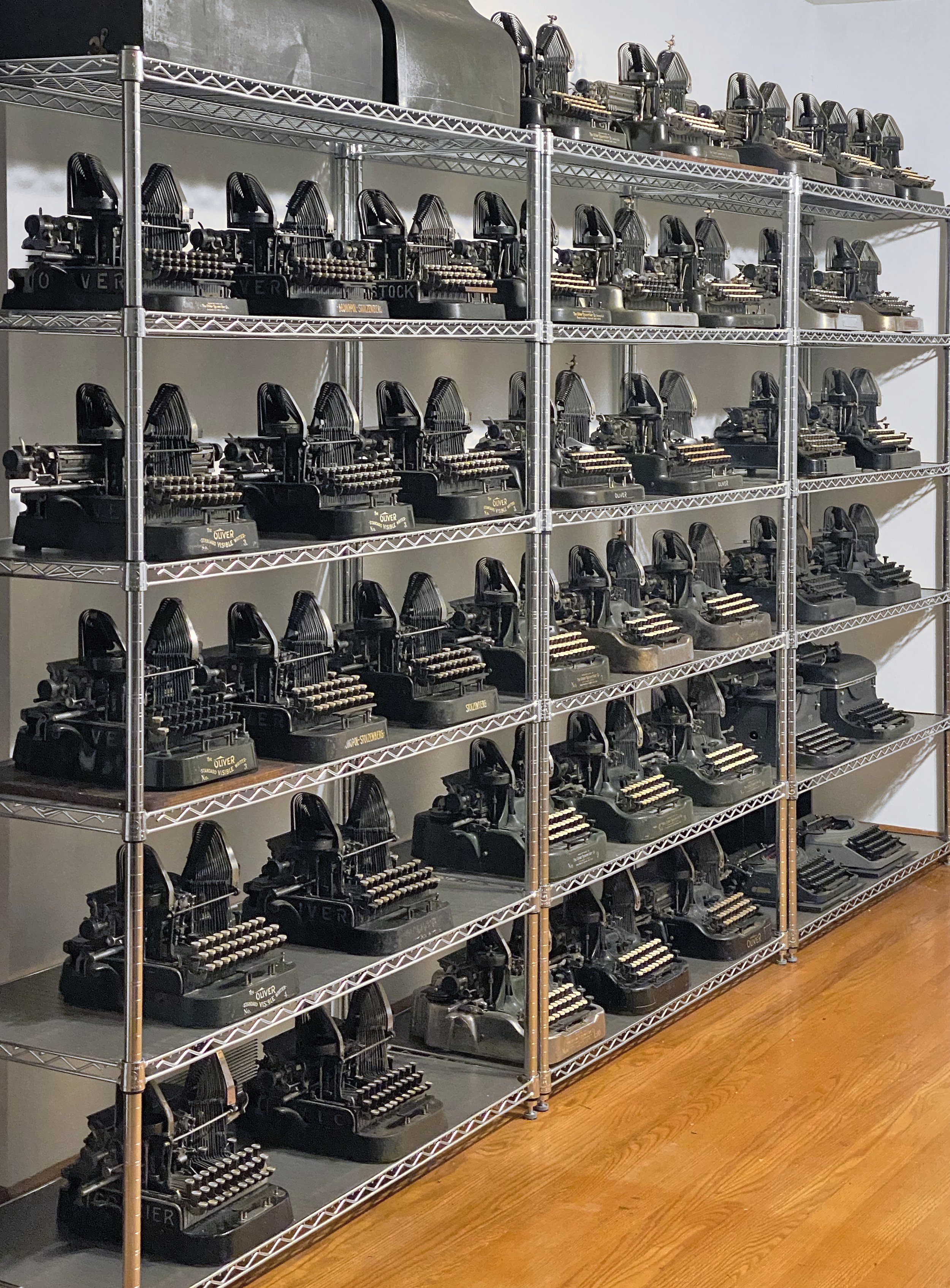
The Oliver typewriter evolved through numerous models over the brand's lifespan. Standard U.S. models include Nos. 1, 2, 3, 5, 7, 9, and 11, with limited quantities sold internationally. The Oliver No. 15 was produced in England by British Oliver. Oliver Nos. 4, 6, 8, 10, 12, and 16 are 32-key derivative versions of their respective preceding odd-numbered model. These models, excluding the British-made No. 16, were built in the U.S. for international markets. Other variants feature distributor-specific decals/designs, either manufactured in the U.S. or abroad by a licensed third party.
Production Percentages
This graph illustrates how common models 9, 5, and 3 are when compared to all other downstrike models. In fact, these models make up 80 percent of all Oliver typewriters.
Standard
Oliver No. 1
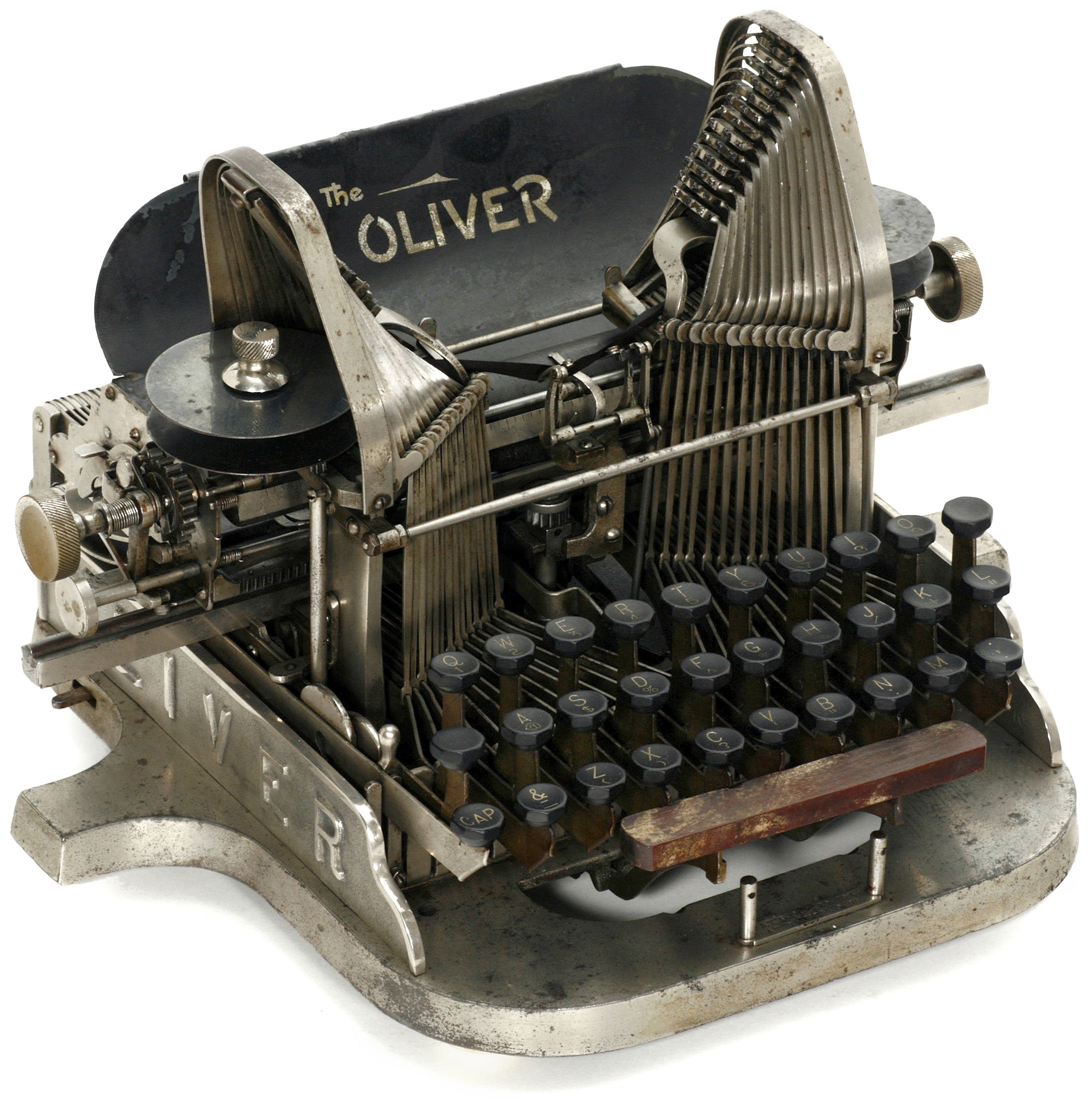
Courtesy Auction Team Breker
The only model produced in Epworth, Iowa, the Oliver No. 1 features flat side handles, easily distinguishing it from later models.
Oliver No. 2
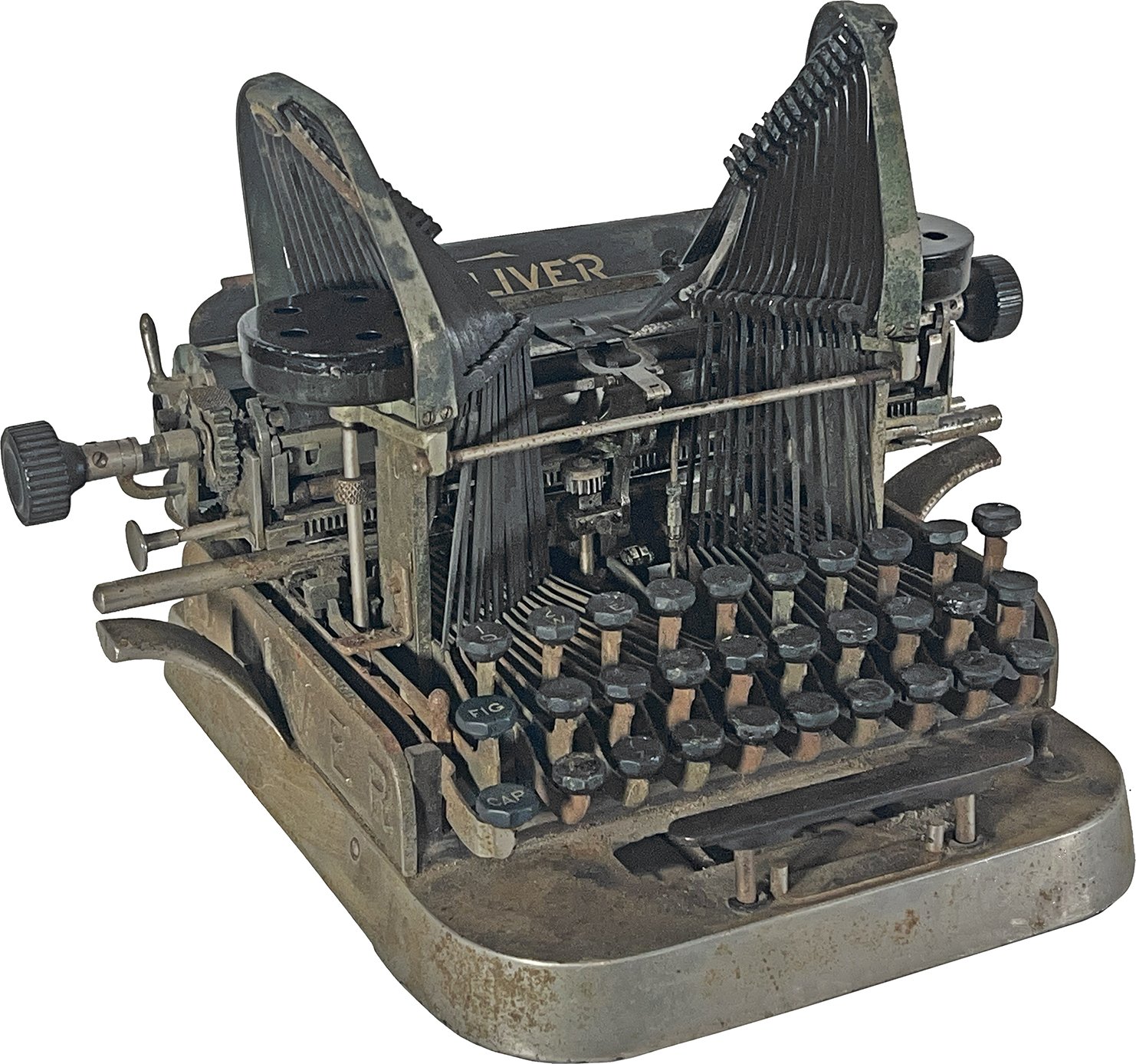
character keys and black shift keys
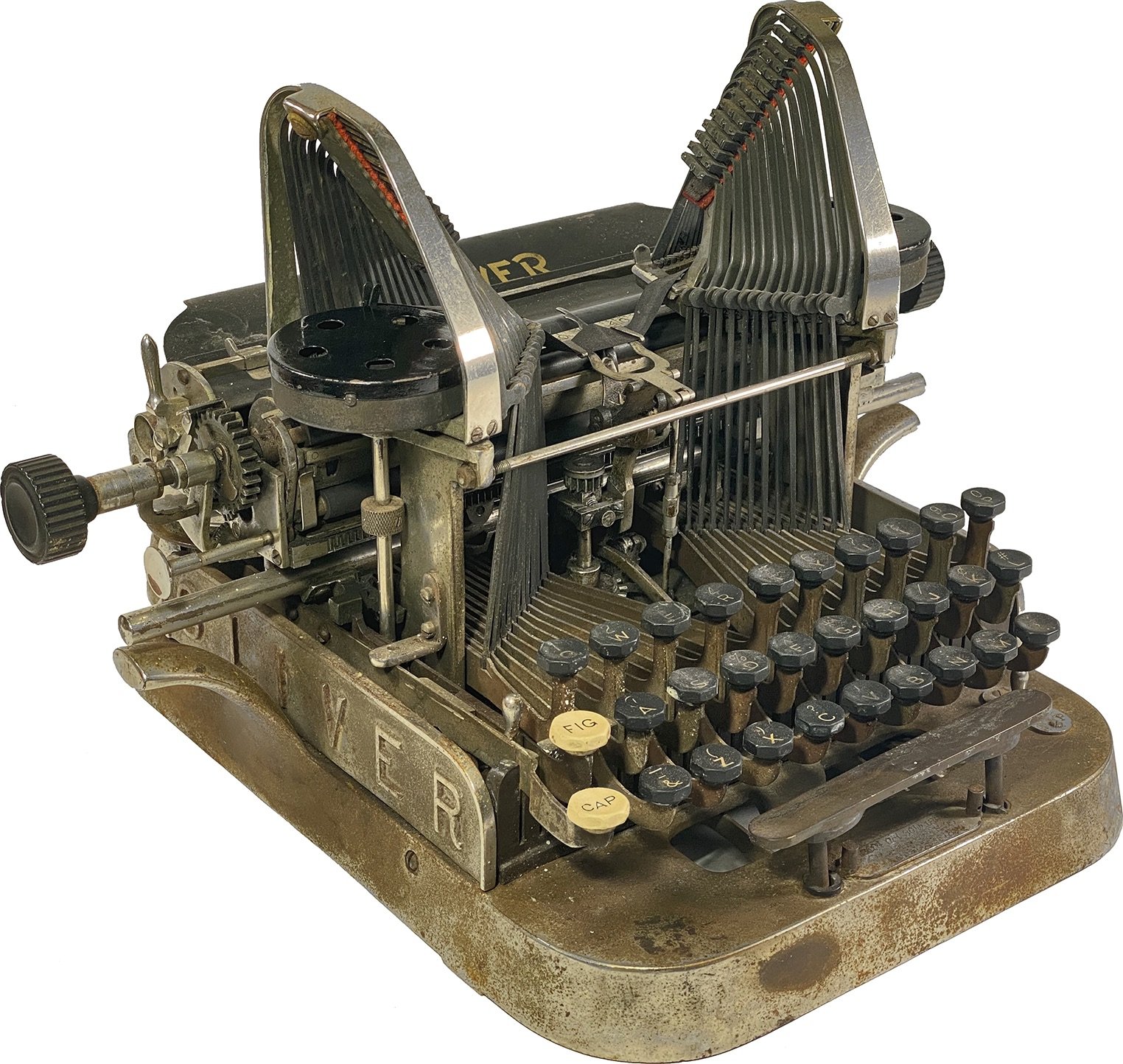
character keys and white shift keys
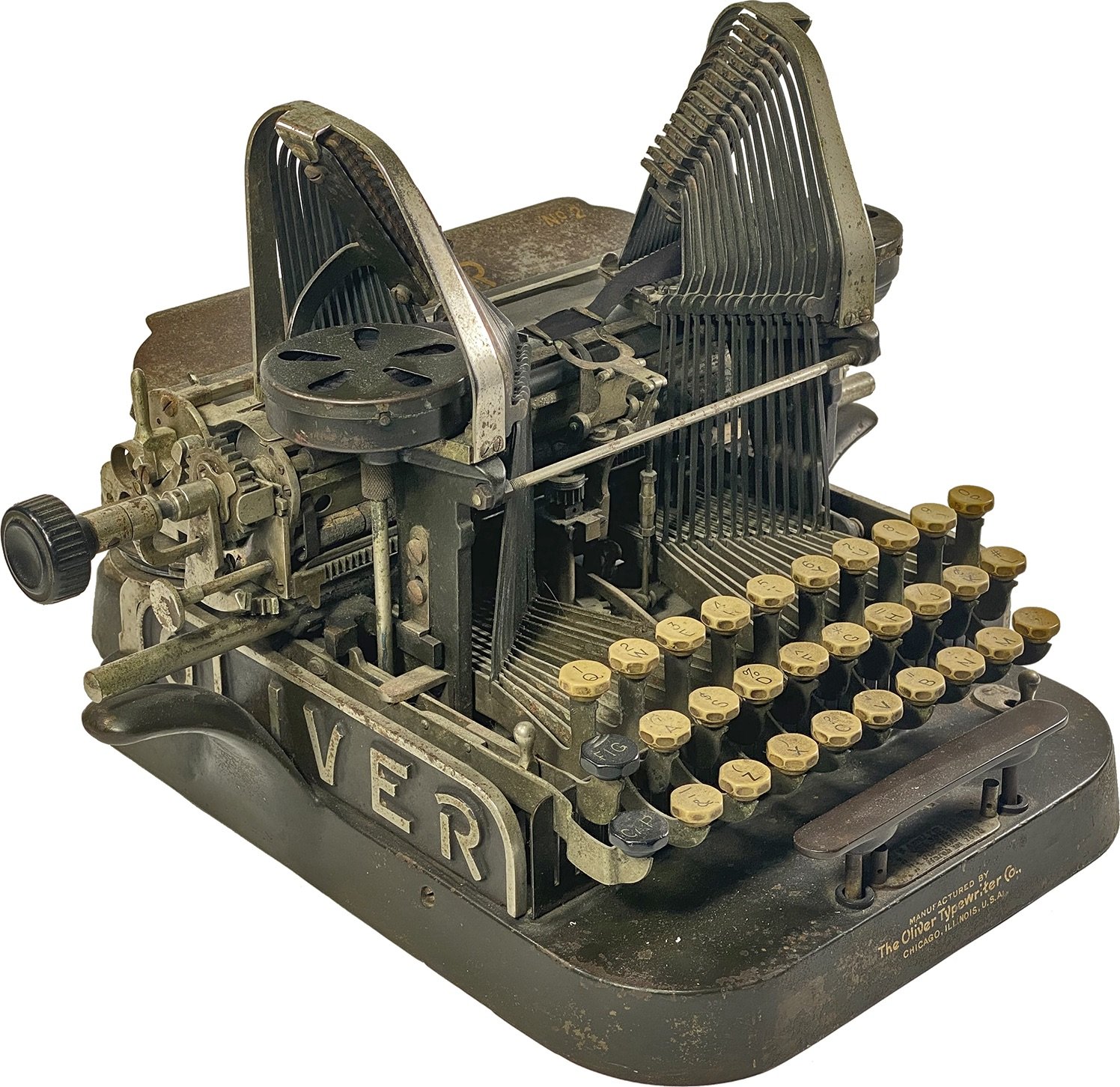
character keys and black shift keys
Production in Woodstock, Illinois began with the Oliver No. 2. Black key tops complimented a nickel base that introduced curved size handles. An olive green base with white key tops soon became default, but any combination of keys and base were furnished to order.
Oliver No. 3
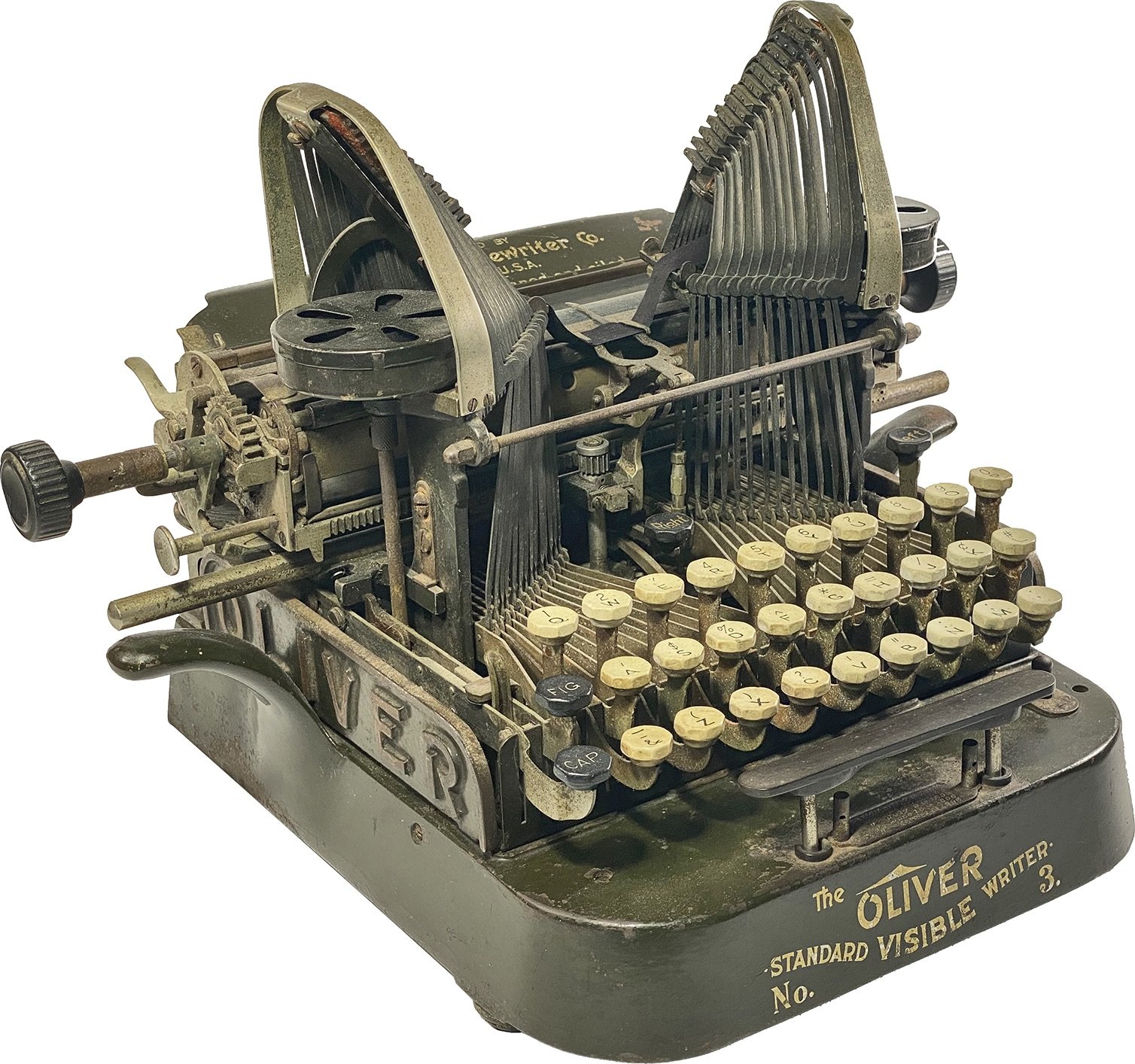
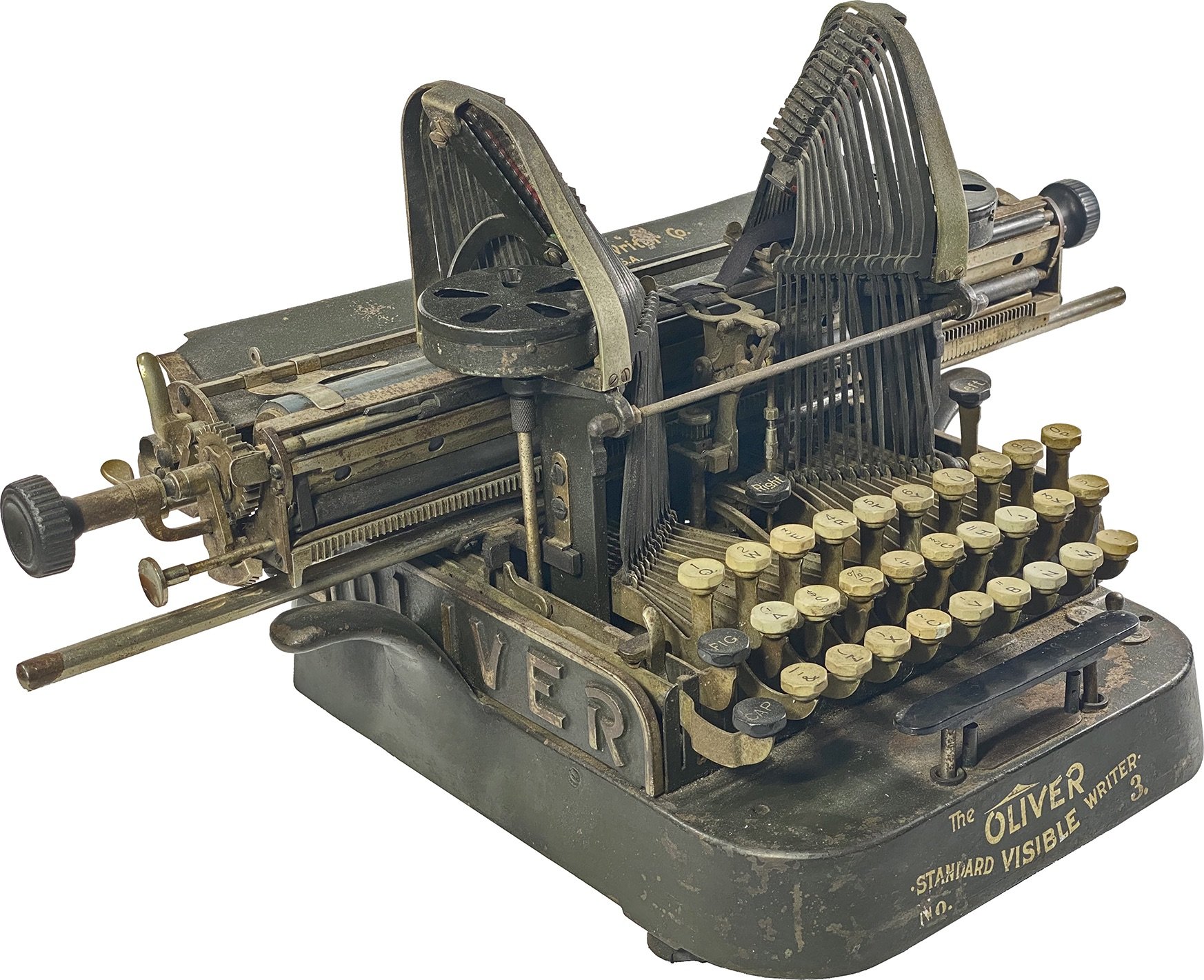
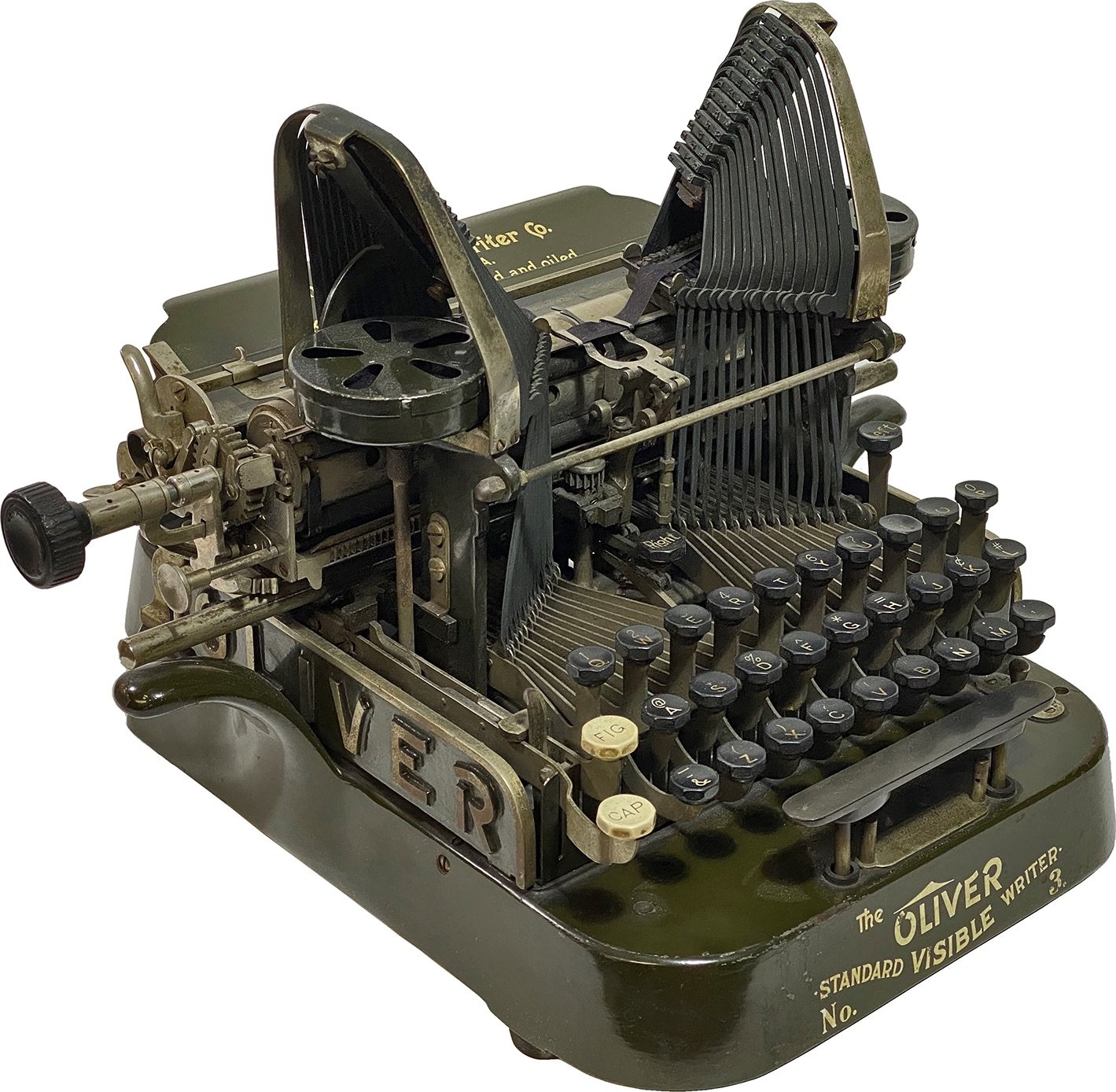
keys with white shift keys
The Oliver No. 3 is very similar to its predecessor, the most striking difference being its taller base. Olive green with white keys remained the default finish, but a nickel base and/or black keys were equipped upon request.
Oliver No. 5
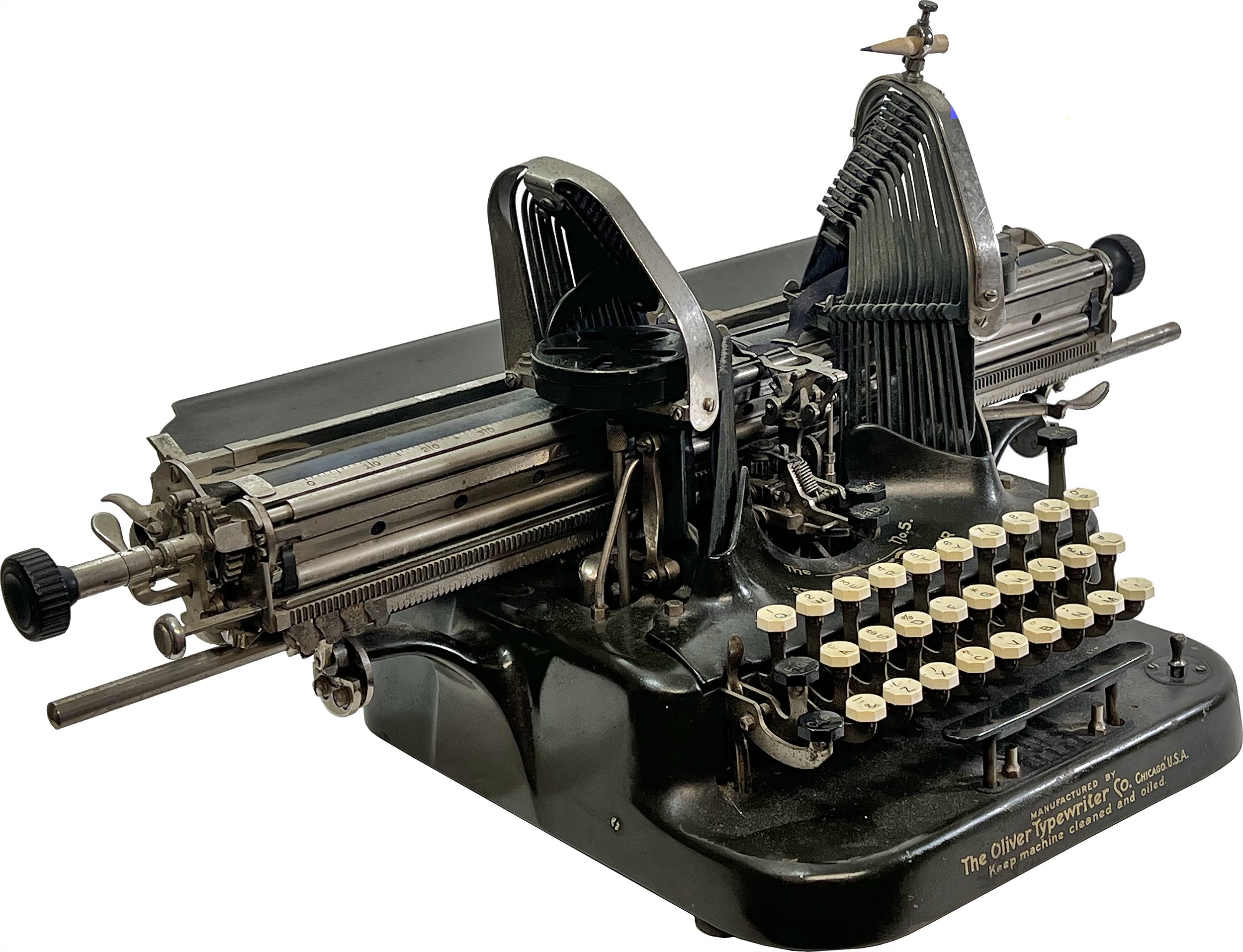
The Oliver No. 5, with its base much larger than its predecessors, introduced a graphite stick ruling device. This ruling device was updated to accept a standard wooden pencil. Early versions also introduced celluloid key covers, but they were ultimately updated to traditional key tops. Throughout its lifespan, the No. 5 also introduced the tab key, backspacer, and an optional typeface called Printype.
Oliver No. 7
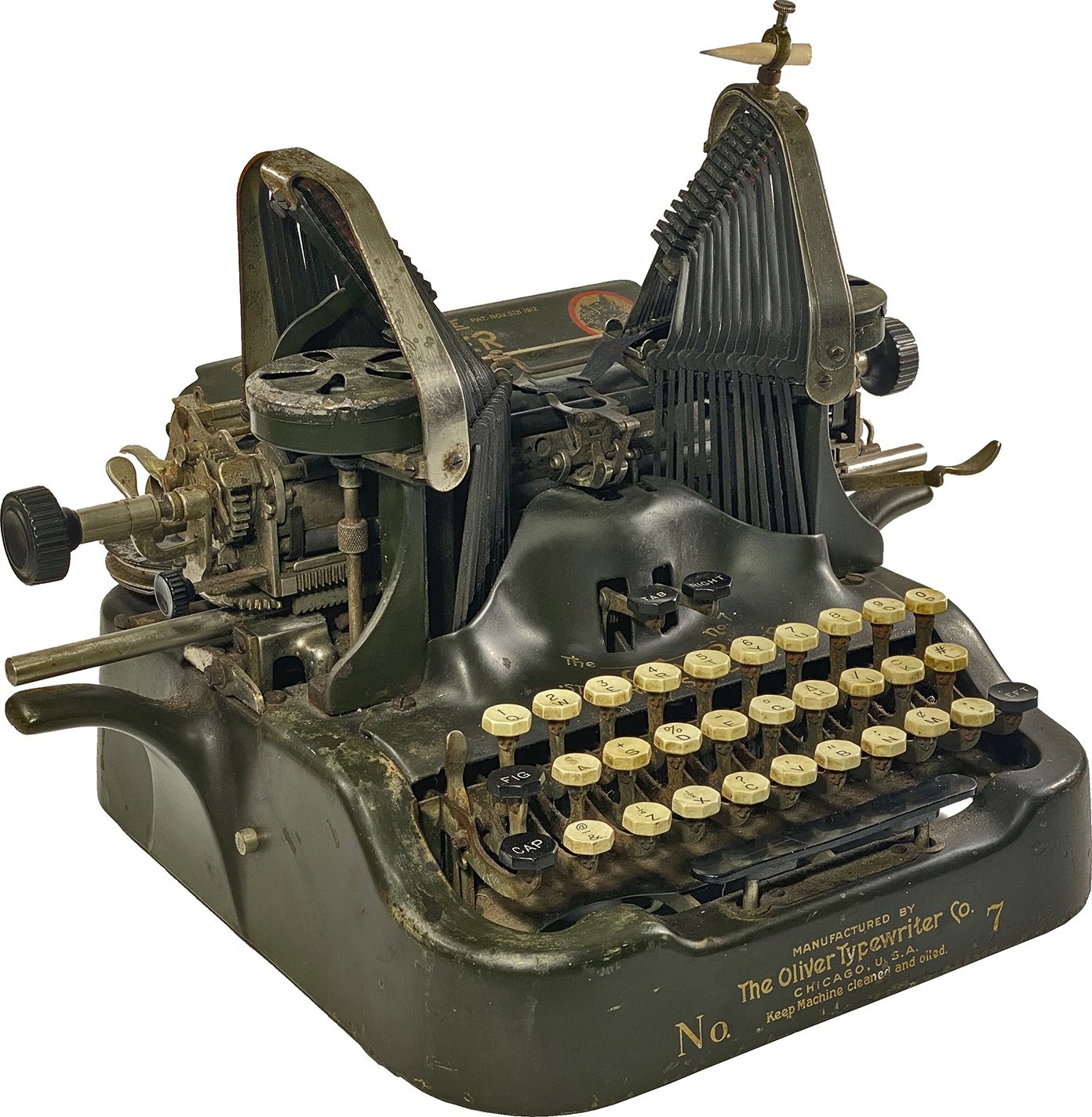
The Oliver No. 7, a relatively short-lived model, introduced a new body style that inspired all succeeding downstrike models.
Oliver No. 9
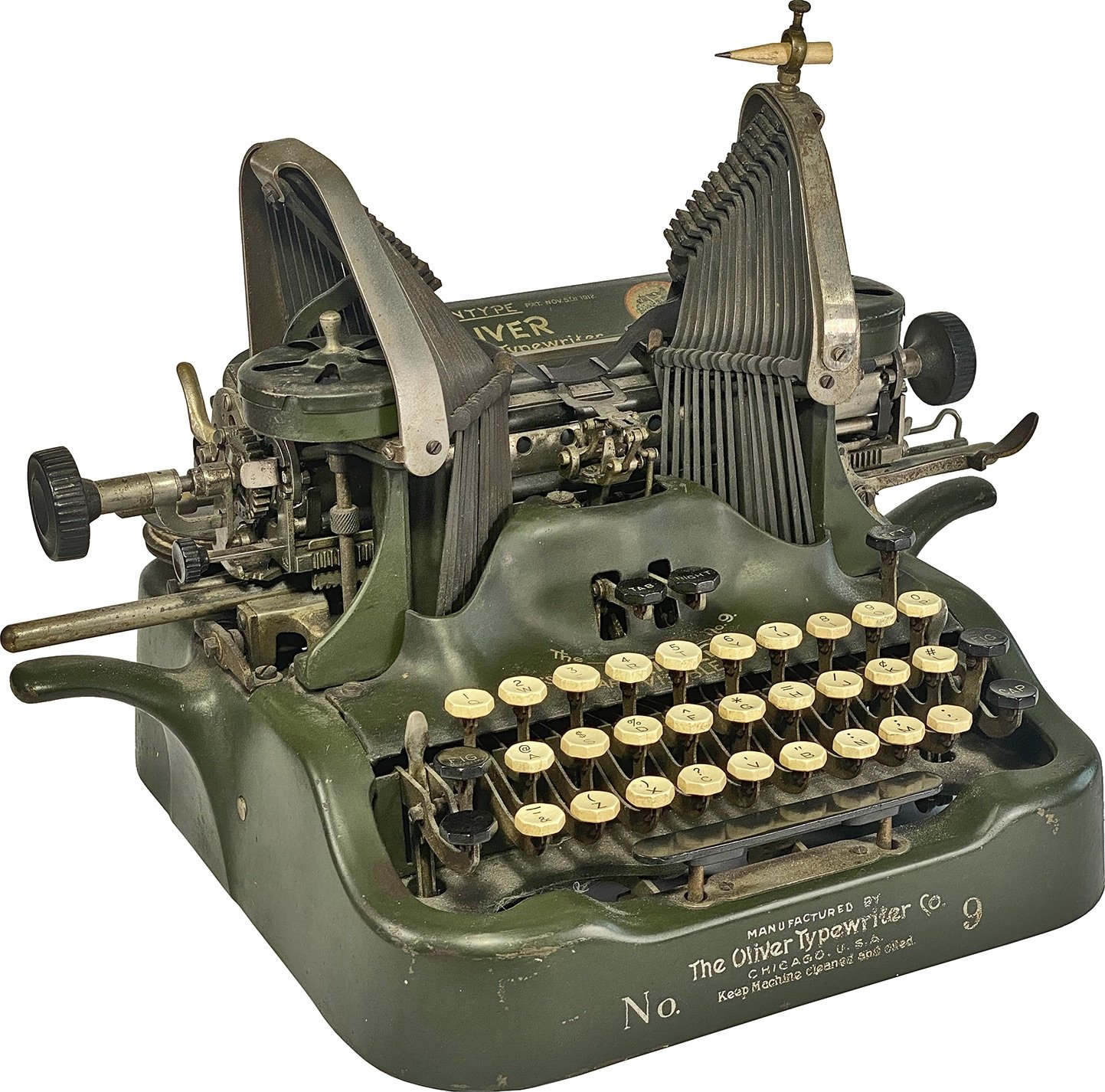
The most popular model by far, the Oliver No. 9 introduces shift keys on both sides of the keyboard.
Oliver No. 11
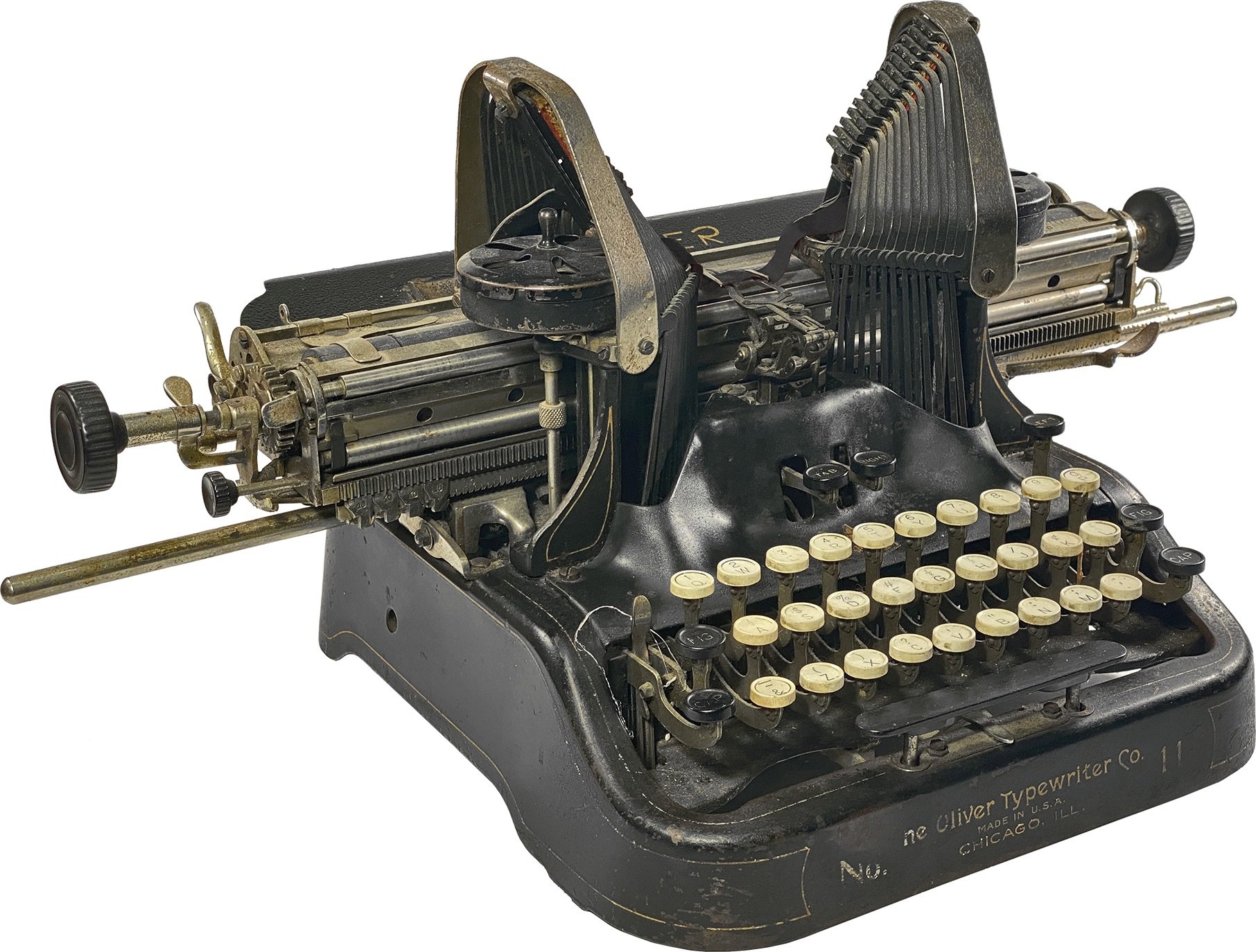
The Oliver No. 11 introduces a black finish with gold pinstriping and round key tops. The No. 11 abandoned the ruling device of many previous models, as well as the curved side handles.
Oliver No. 15
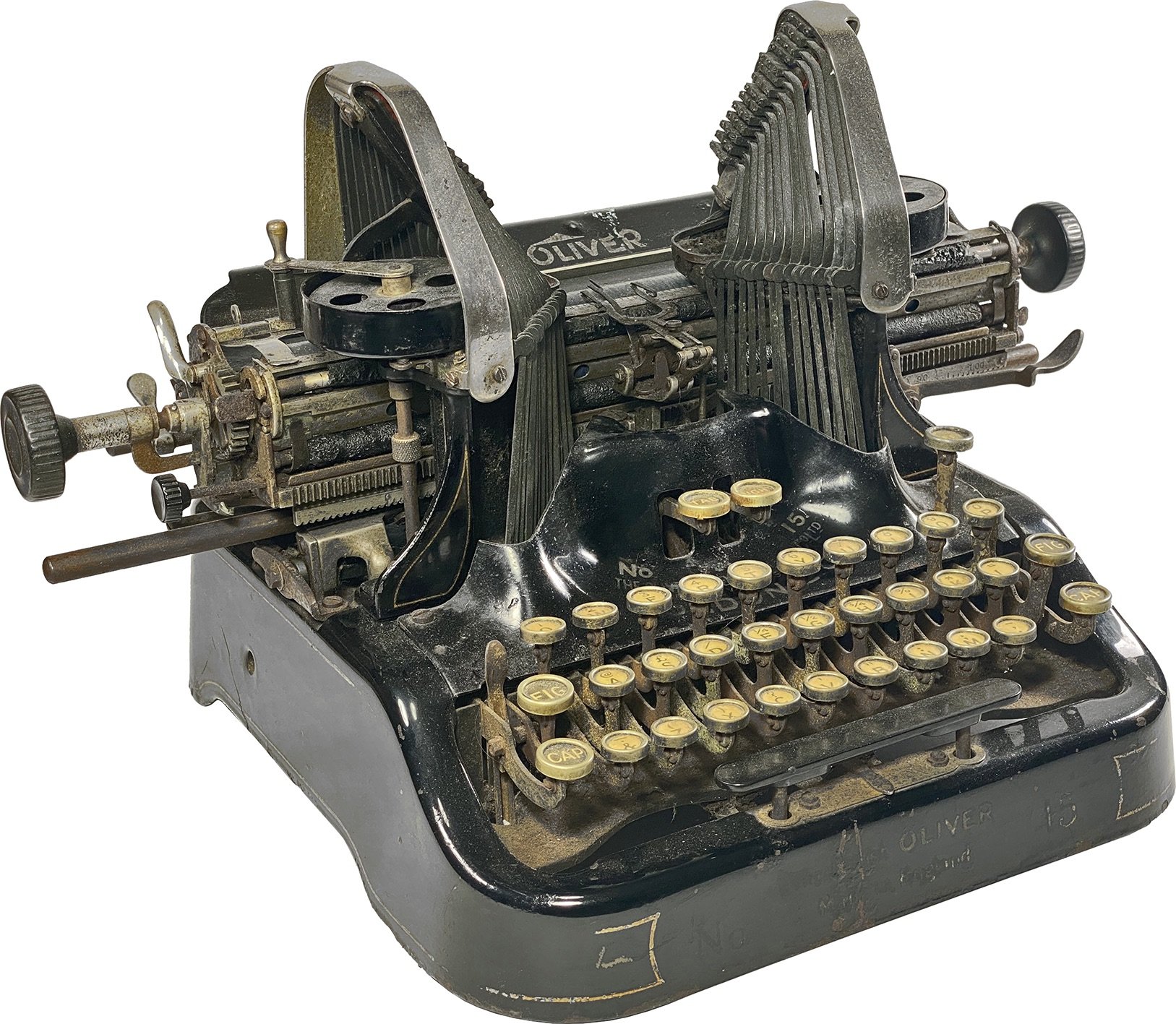
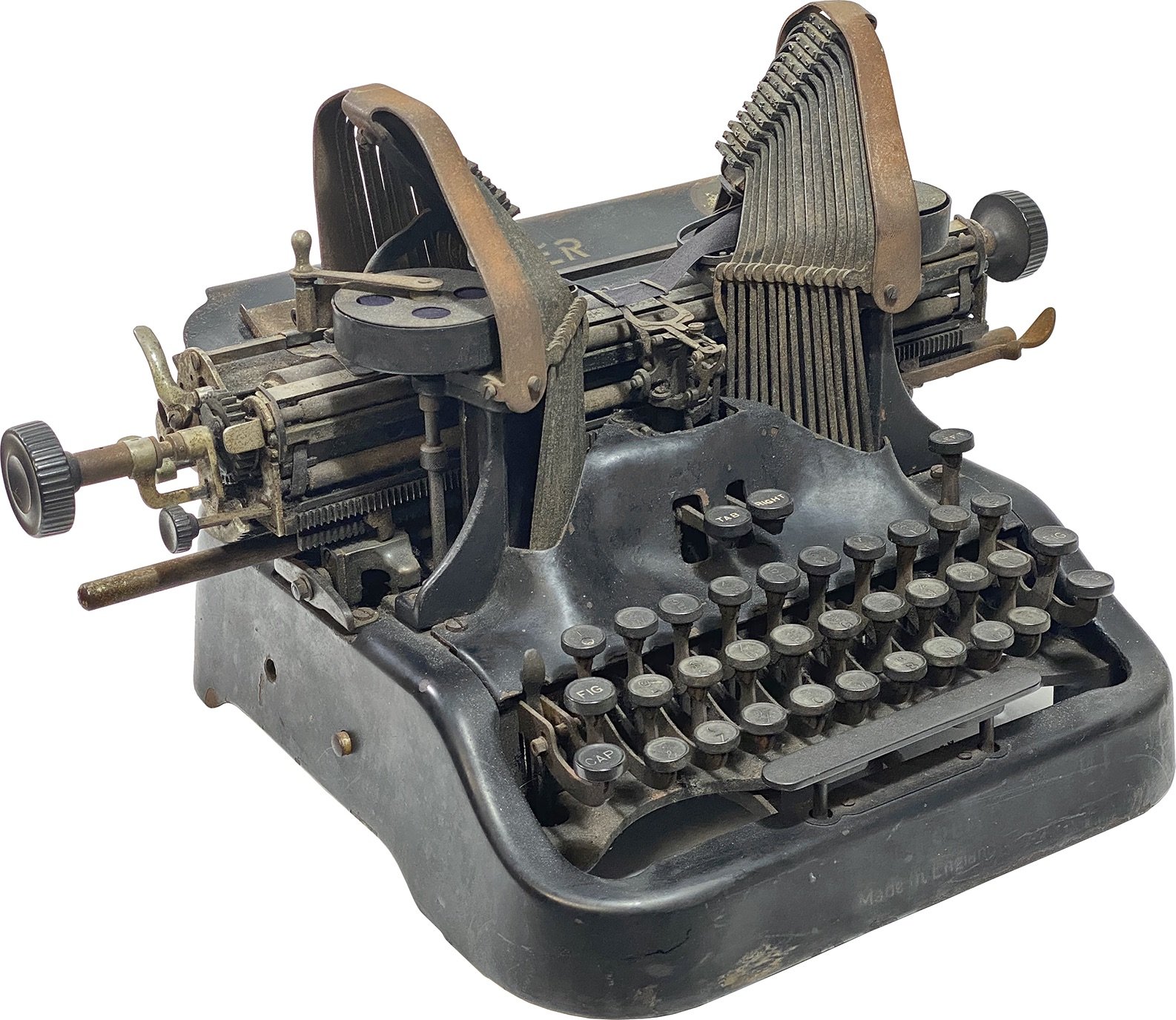
B-size carriage
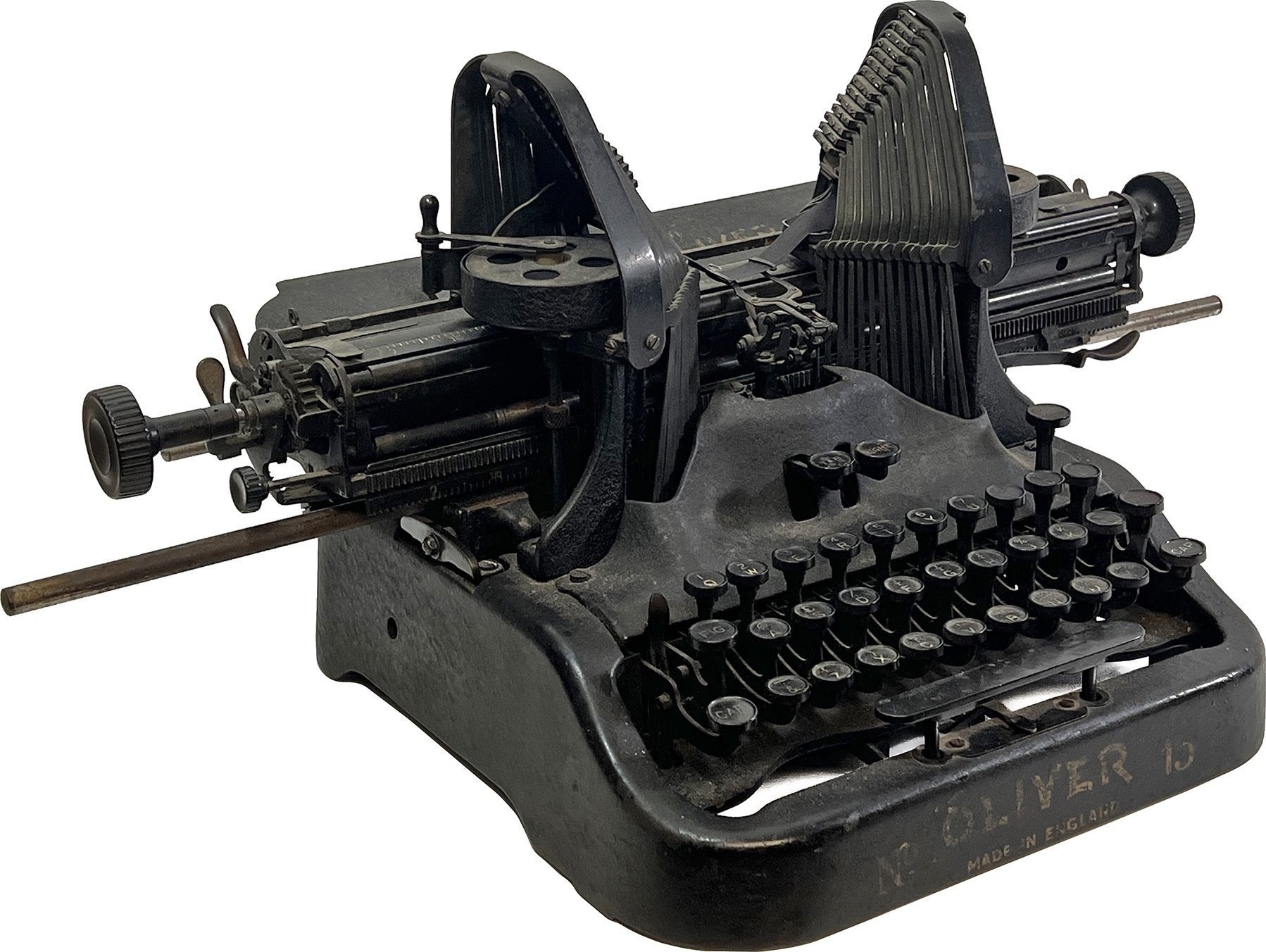
C-size carriage
The Oliver No. 15, the first Oliver produced in Croydon, England, introduces pivoting ribbon spool covers. Early specimens were gloss black with ring and glass keys and nickel-plated accents. Over time, the keys were updated to white or black, and the finish was crinkled with blackened accents.
Derivative
Oliver No. 4
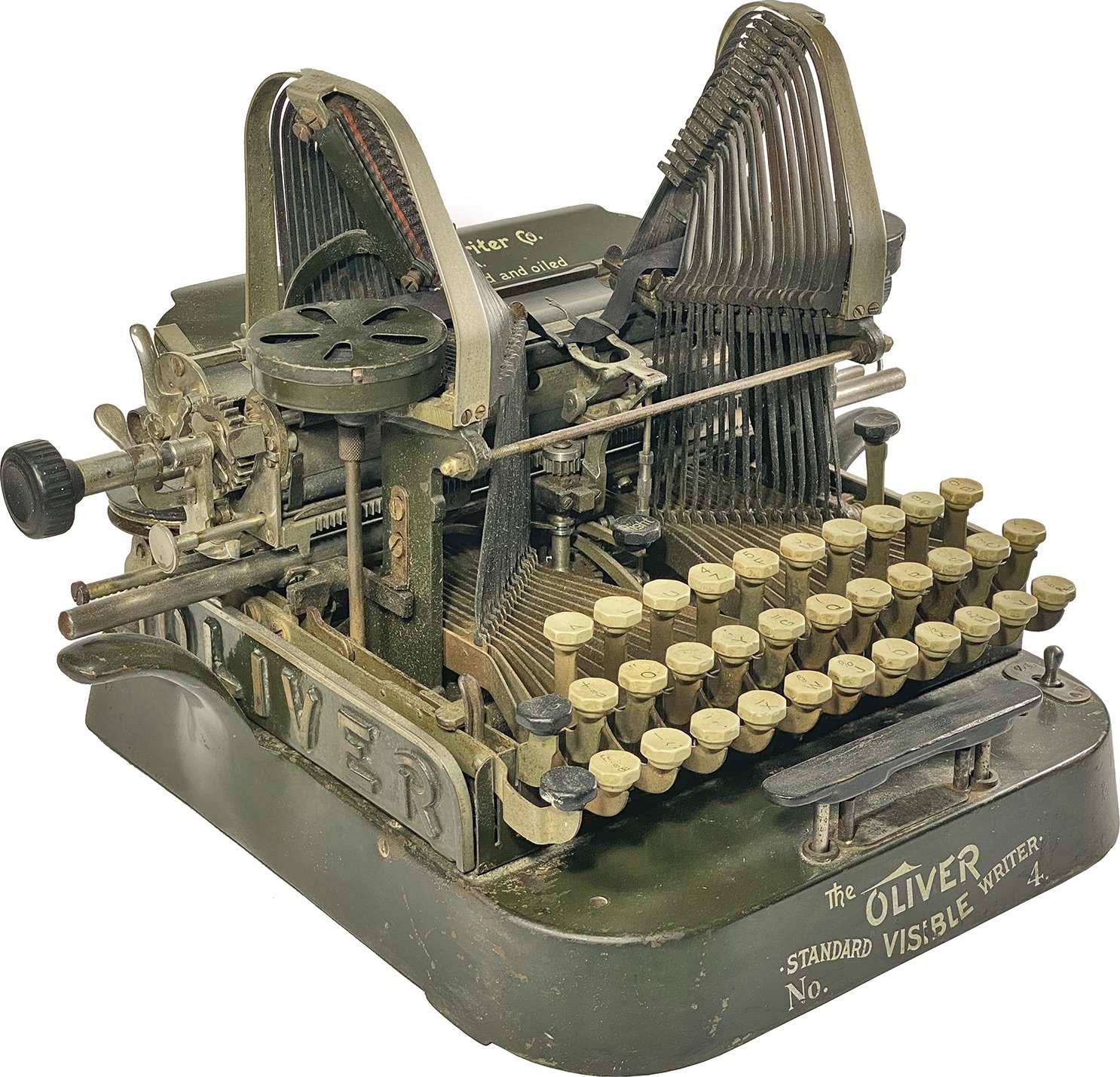
The Oliver No. 4, the first derivative Oliver model, is a 32-key version of the No. 3, introduced in 1904.
Oliver No. 6
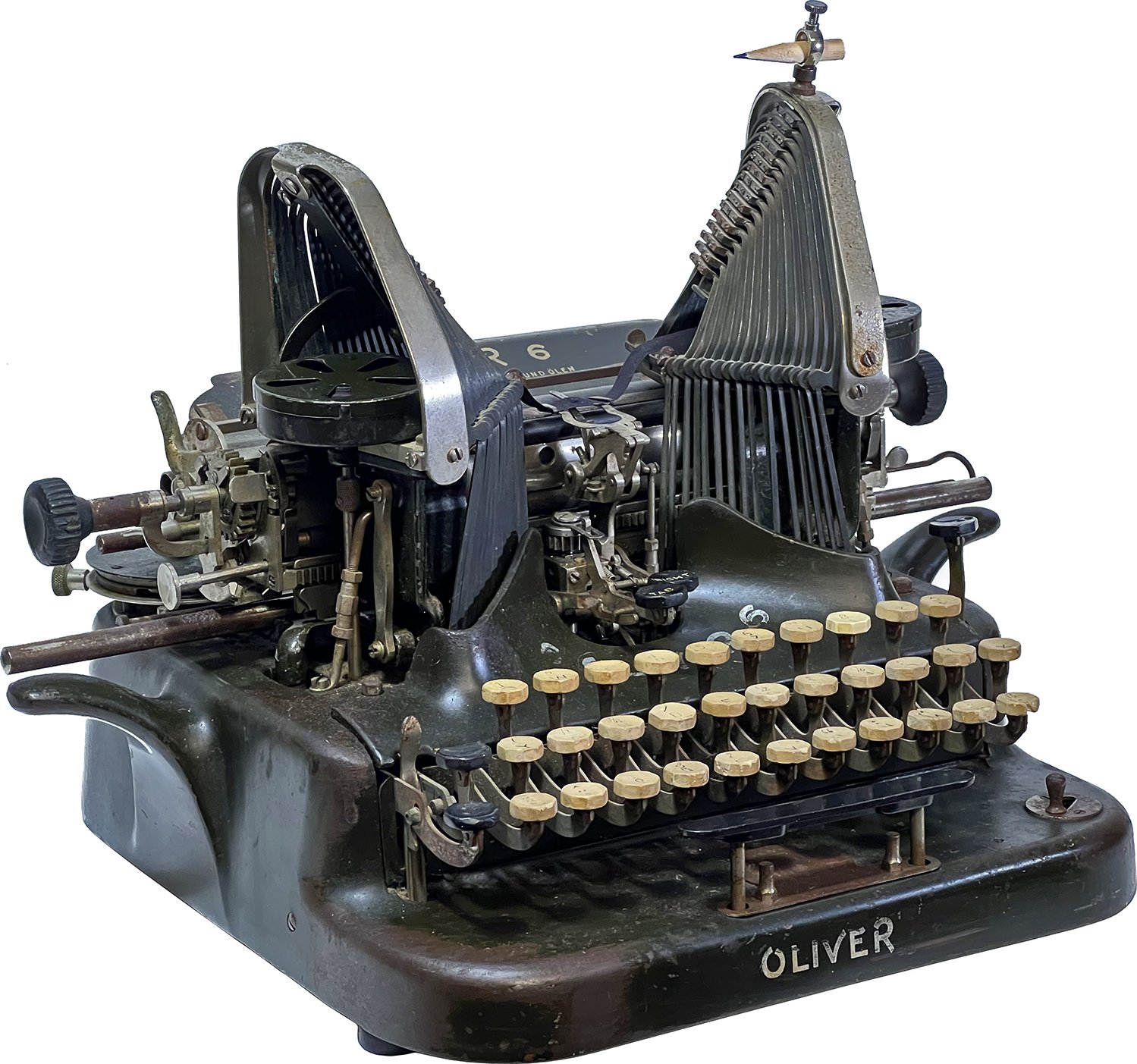
The Oliver No. 6 is the derivative version of the No. 5. Updates made to the No. 5 throughout production also found their way onto the No. 6.
Oliver No. 8
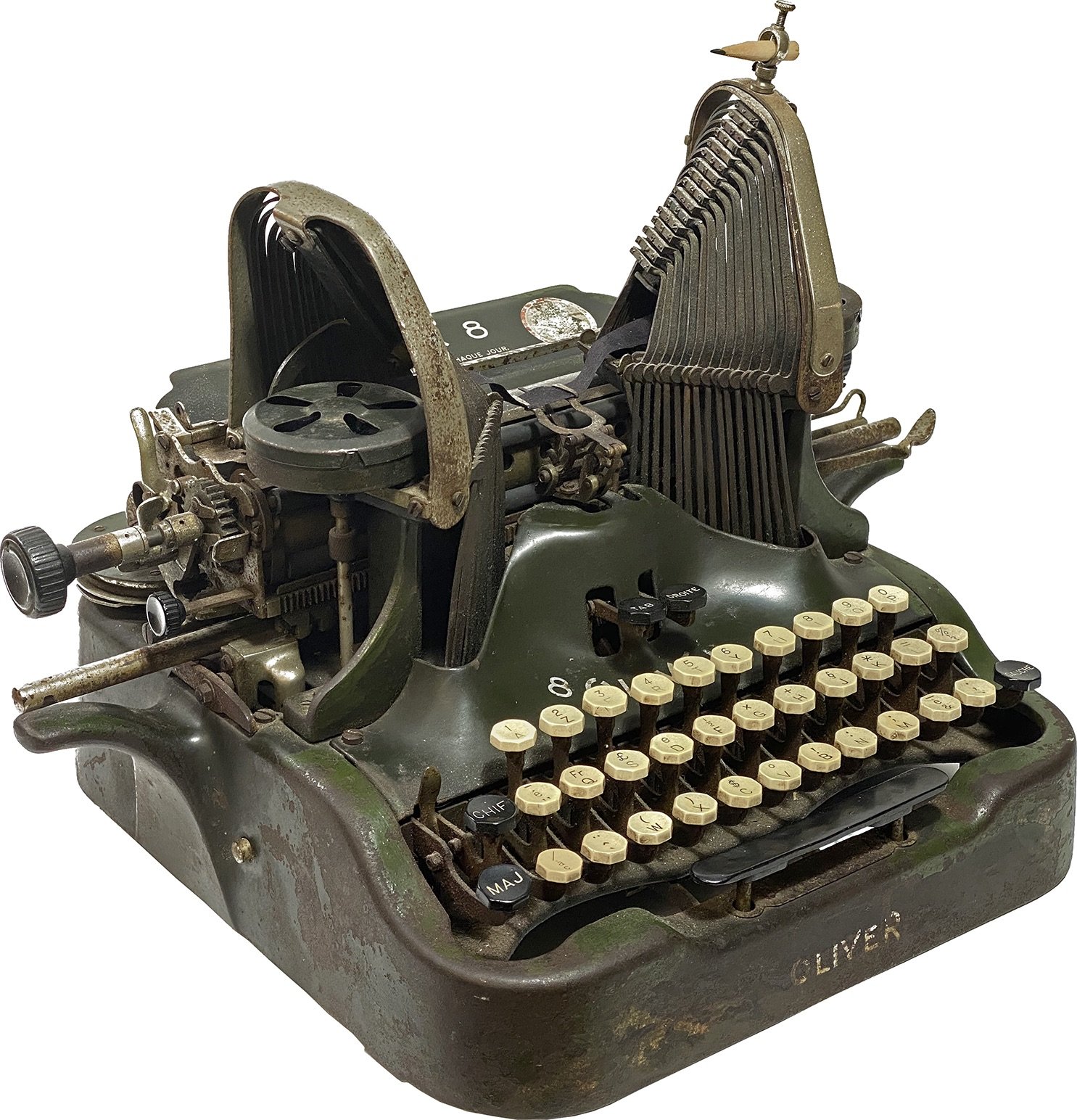
The Oliver No. 8 is the 32-key derivative version of the No. 7. It was produced in very limited numbers compared to other derivative models.
Oliver No. 10
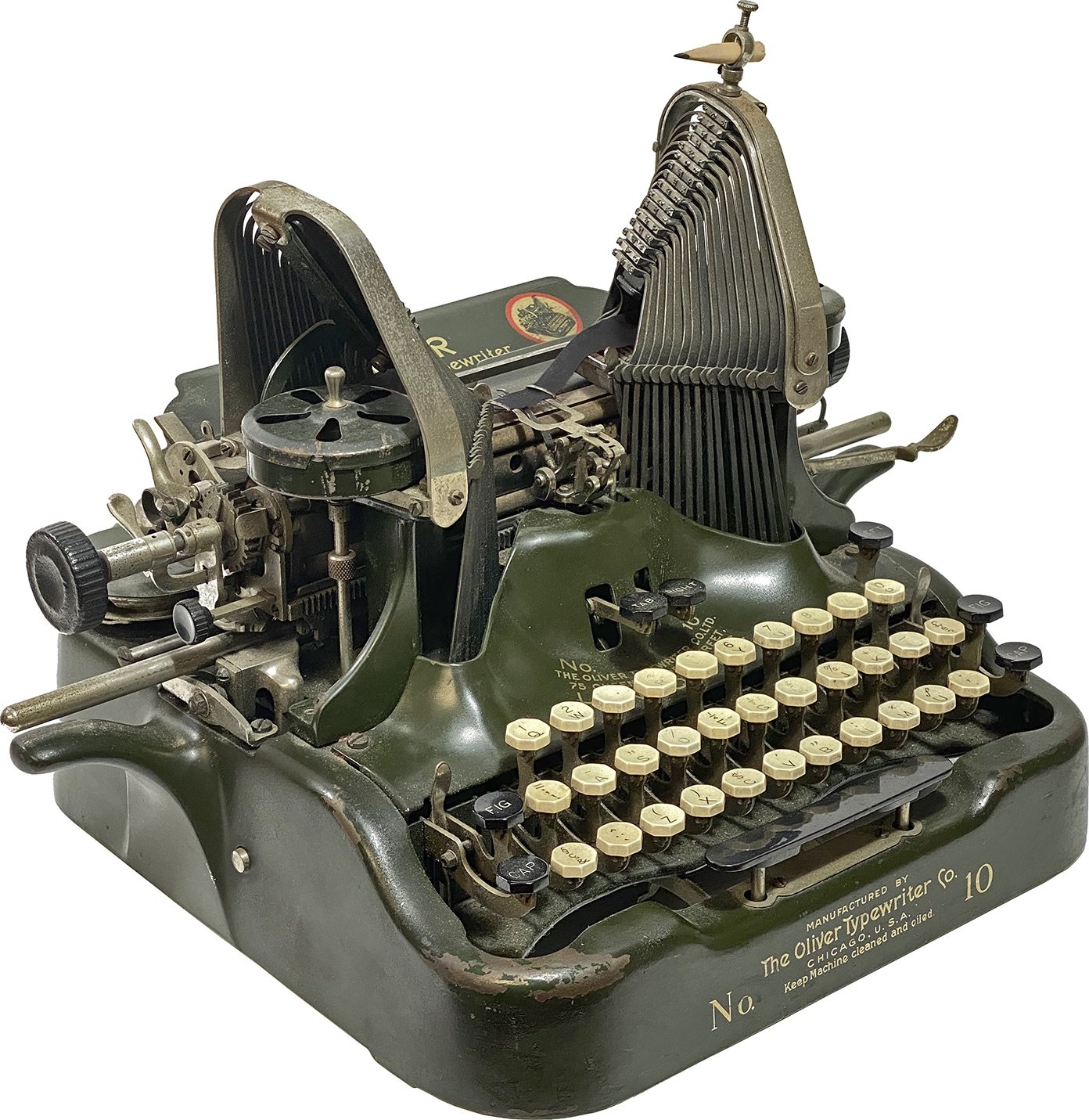
The Oliver No. 10, the 32-key derivative version of the No. 9, is one of the most common export Oliver models.
Oliver No. 12
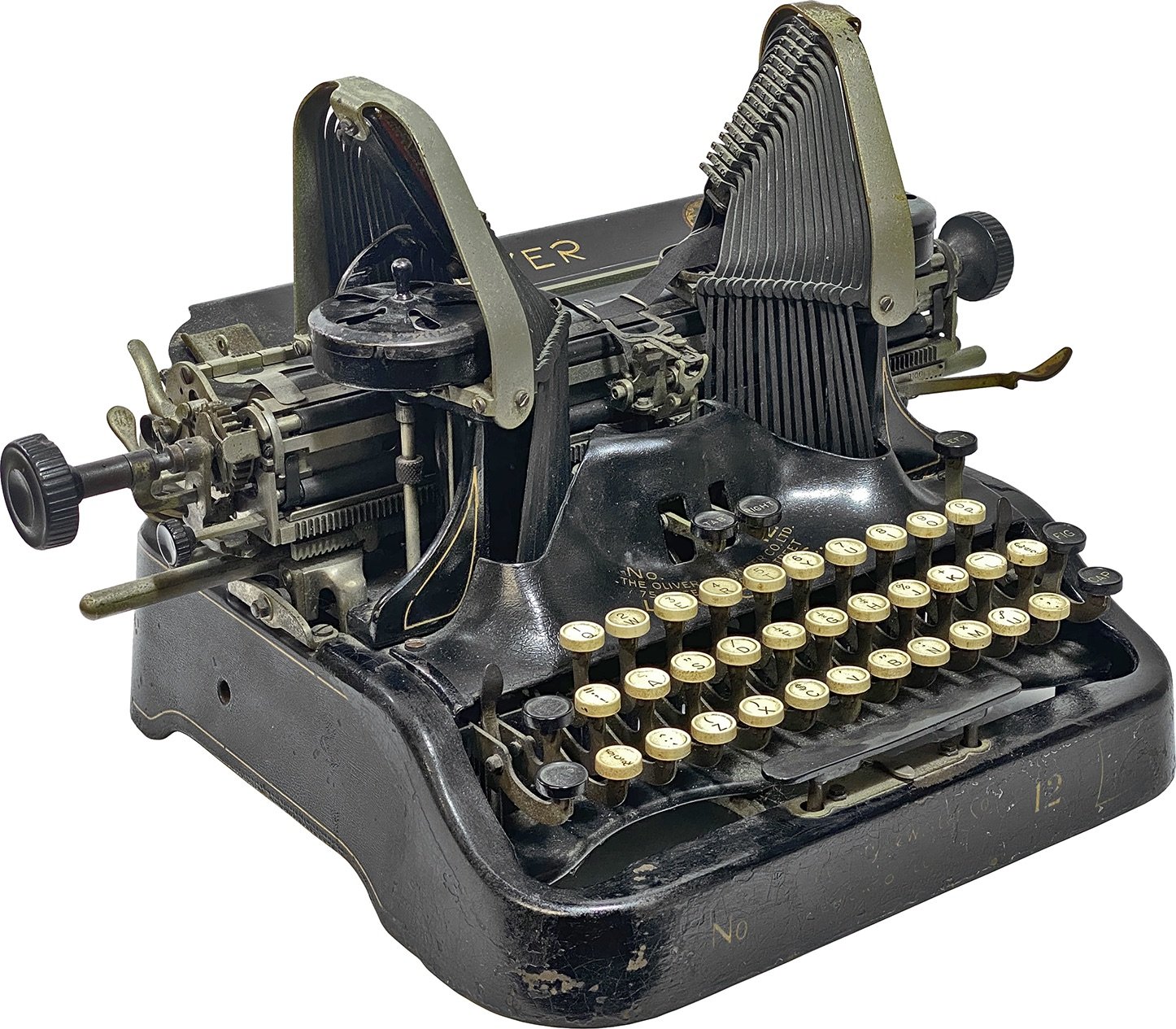
The Oliver No. 12 was the last 32-key model produced in the United States.
Oliver No. 16
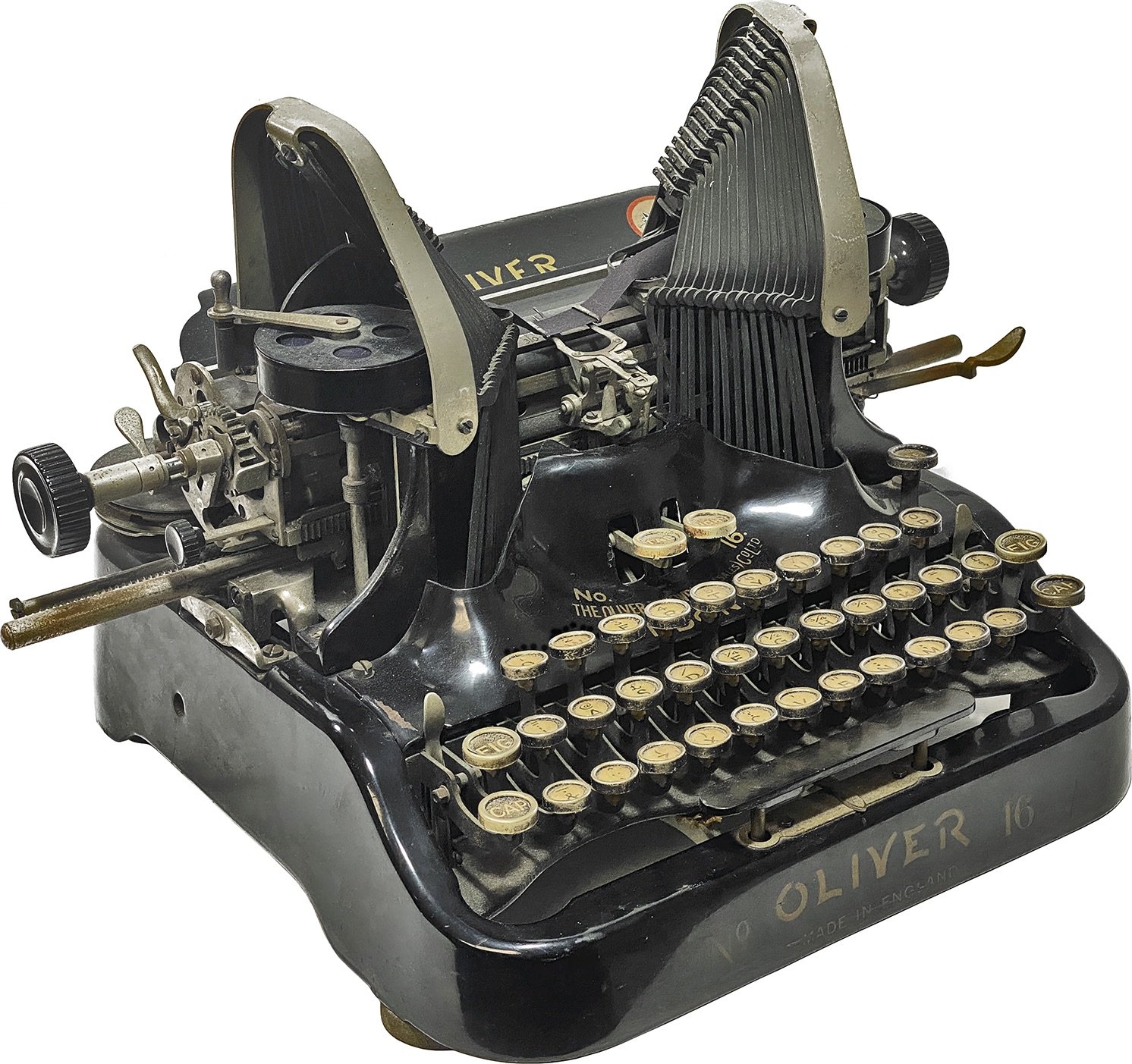
Styled like early examples of the Oliver No. 15, the Oliver No. 16 was the only 32-key Oliver model produced in England.
Remodelled
The Oliver Typewriter (Sales) Company rebuilt and refinished some olive green models in black with gold pinstriping, matching the style of Oliver Nos. 11, 12, 15, and 16. During this process, the carriages were stripped of their original serial numbers with no new number put in place, and a new serial number was put in place over the original on the base.
Remodelled (RM) No. 9
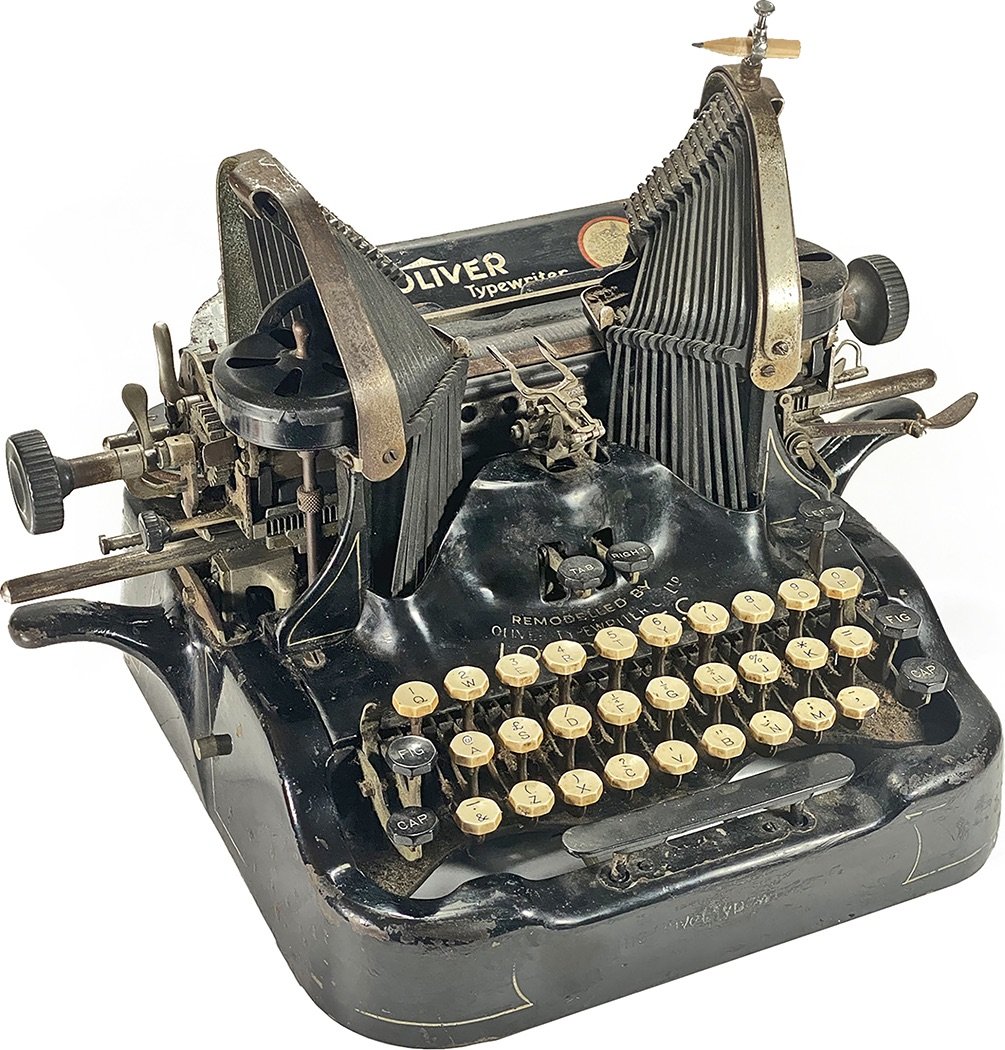
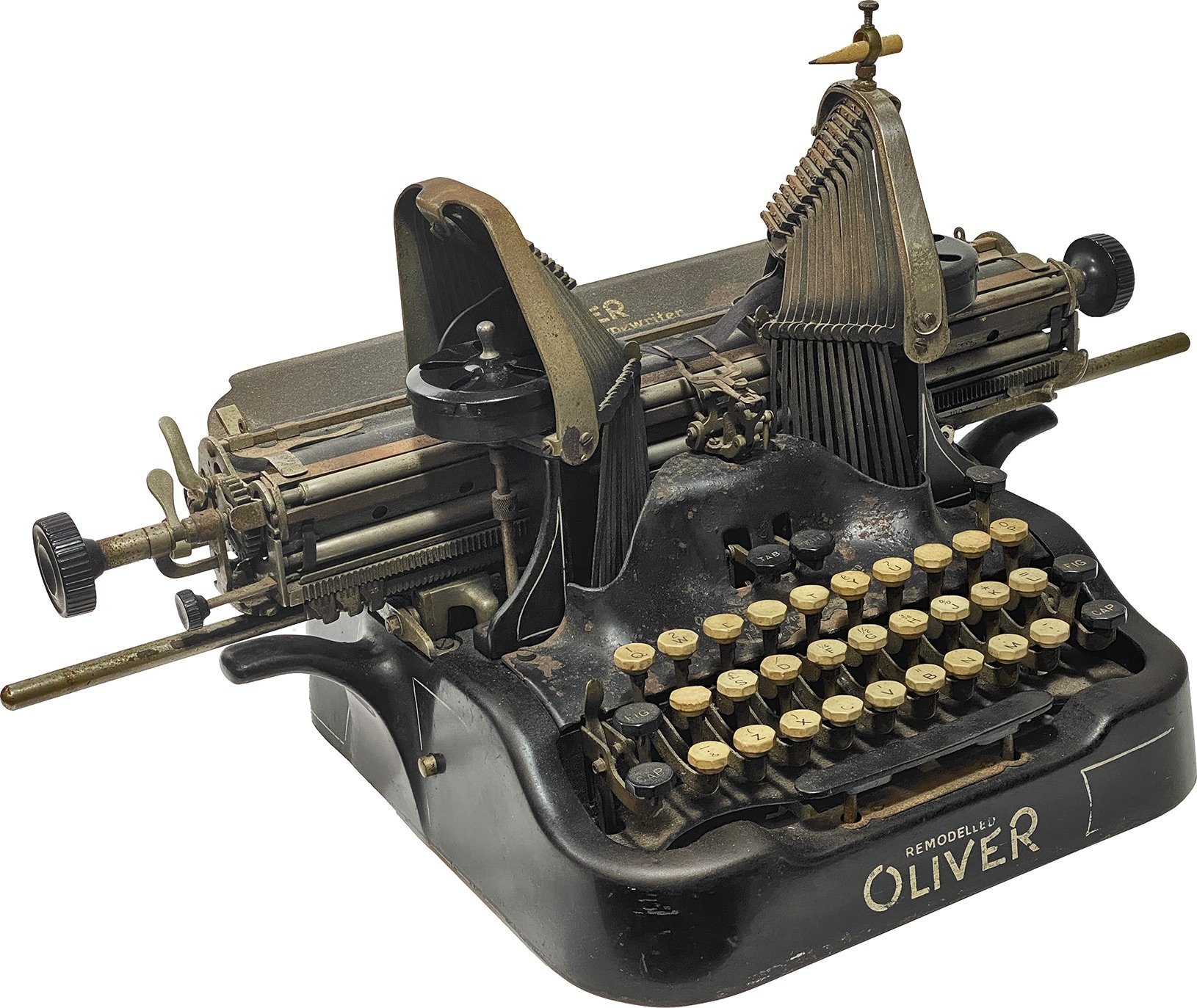
Remodelled (RM) No. 10
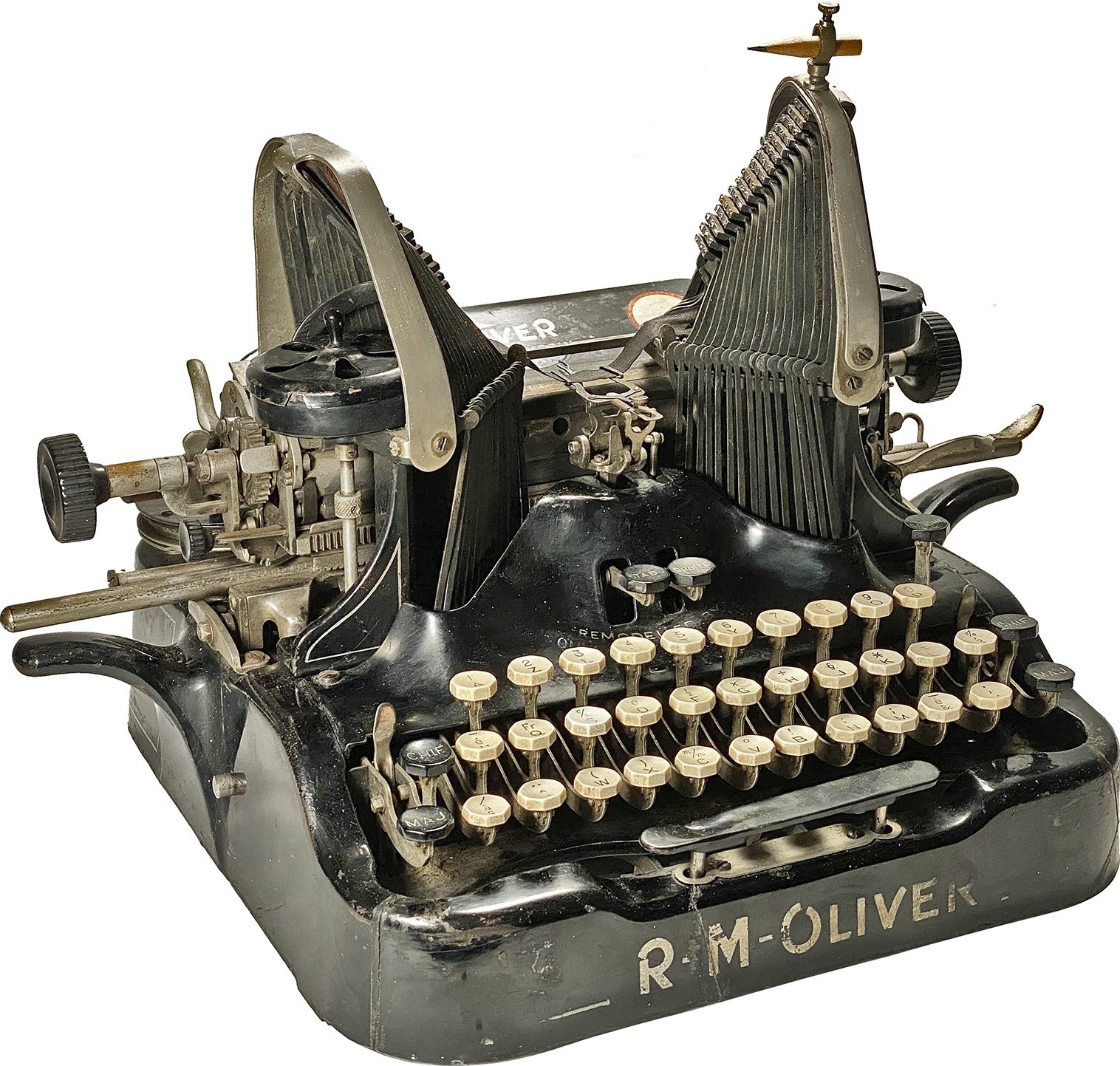
Woodstock
In 1898, the Oliver Typewriter Company manufactured an Oliver No. 2 variant known as the Woodstock for sale by department stores. From September 1898 to January 1899, Detroit’s Board of Education purchasing committee held meetings to discuss purchasing typewriters for use in public high schools. The Linotype Company of Montreal, also known as the Canadian Oliver Typewriter Company, published a pamphlet known as the Battle of Detroit which complied contemporary publications detailing these meetings. According to the pamphlet, an individual referenced as Inspector Marr showed the purchasing committee an advertisement for the Woodstock in the Fall and Winter 1898–99 Montgomery Ward Catalogue, questioning the fairness of the price at which Oliver typewriters had been offered to the Board. W. Waterbury, the general sales manager of the Oliver Typewriter Company, declared the Woodstock an unguaranteed, second-grade machine of which only nineteen were manufactured, all sold to Montgomery Ward. The Oliver Typewriter Company printed an advertisement offering to purchase twenty Woodstock typewriters for a substantial amount of money, reinforcing the fact only nineteen were manufactured. Manufacturing of the Woodstock ceased after it had been on the market for less than ten months.
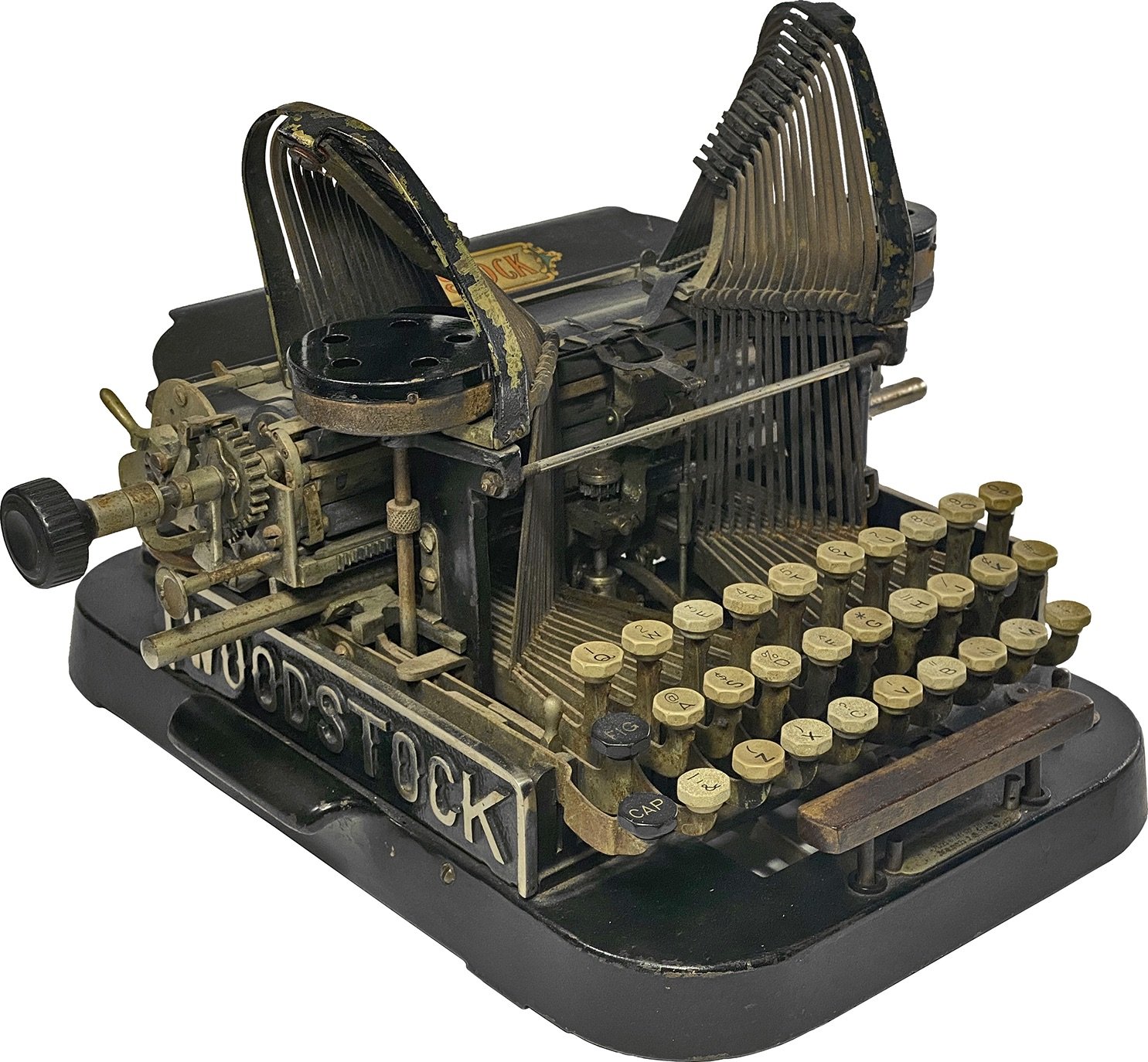
Canadian
John Redpath Dougall was born on August 17, 1841 in Montréal, Quebec, Canada, to Scottish-born merchant John Dougall, founder the Montreal Witness newspaper. In 1871, the father relocacted to New York City where he founded the Daily Witness and New York Weekly newspapers, leaving his son in charge of the Montreal Witness. In 1891, John Redpath Dougall founded The Linotype Company, which manufactured typesetting machines known as the Linotype at 156 St. Antoine Street, Montréal. In 1898, the Linotype Company expanded to manufacture versions of the Oliver No. 2 and, in 1901, the Oliver No. 3, for Canadian and South American markets. Compared to their American manufactured counterparts, Canadian Oliver typewriters have smaller side handles, curved shifting brackets, and a different ribbon vibrator. In 1904, Dougall sold the Linotype division of his company to the Toronto Type Foundry, and rebranded the typewriter division as the Canadian Oliver Typewriter Company. The Canadian Oliver Typewriter Company eventually stopped manufacturing machines and by 1912, focused solely on nickel plating and polishing.
Canadian Oliver No. 2
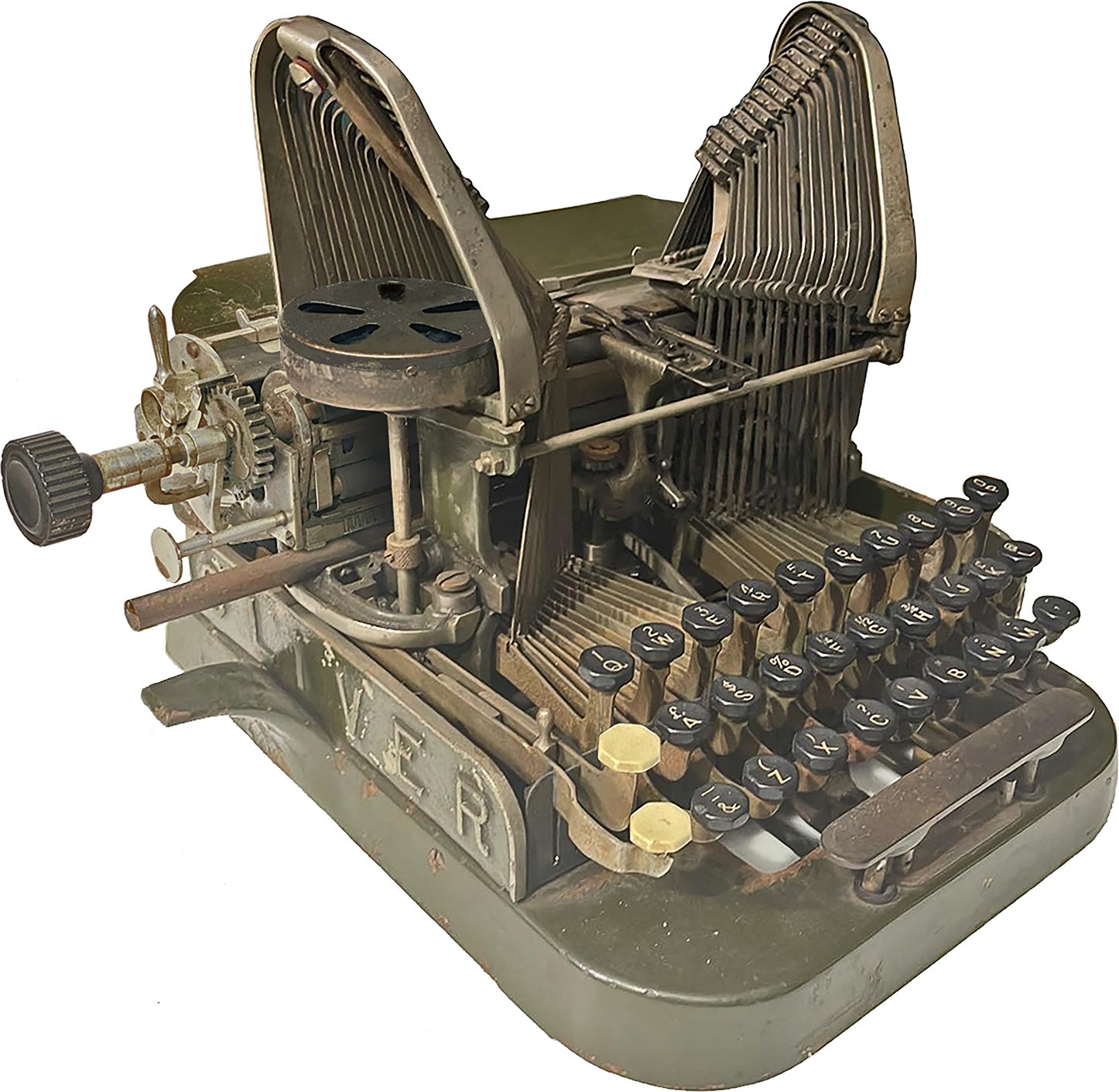
Courtesy Maxim Suravegin
Canadian No. 2 machines, some of which have vertically-mounted ribbon spools, are based on early specimens of the Oliver No. 2 machines manufactured in Woodstock.
Canadian Oliver No. 3
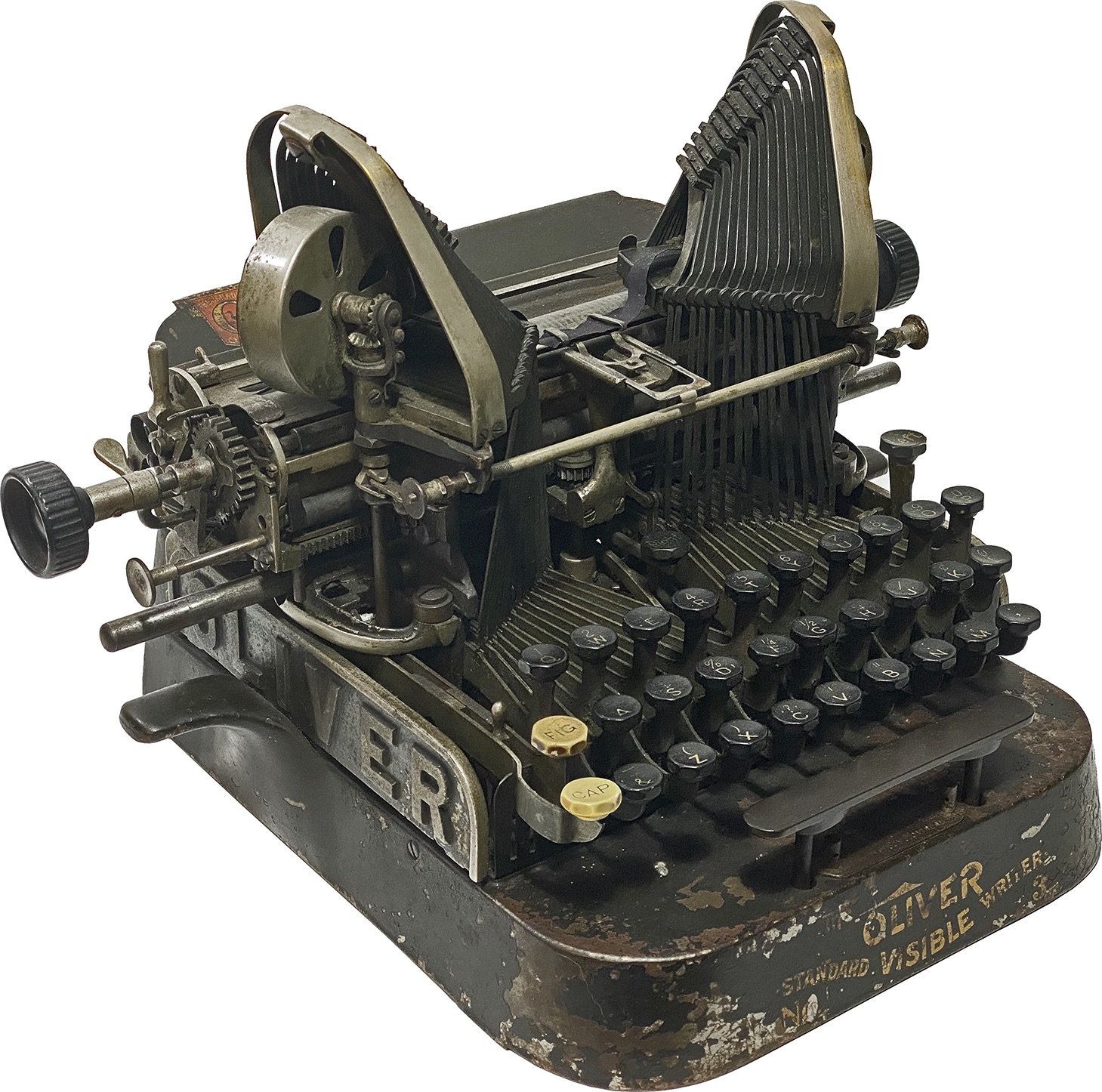
Earlier Canadian No. 3 machines have black keys, vertically mounted ribbon spools, and side panels displaying OLIVER in an unusual blocky typeface. These features, as well as the keyboard layout, were progressively updated to make the Canadian No. 3 more closely resemble the No. 3 produced by The Oliver Typewriter Company. Canadian Oliver No. 3 machines retained some parts of the Canadian Oliver No. 2, including the shift lock lever. They also have different mounting hole locations than the No. 3 machines manufactured in Woodstock.
Latin American
The Oliver Typewriter Company marketed most Oliver models in Latin America through Compania Parker S.A., operated by William Archer Parker, the Oliver Typewriter Company’s Latin American sales agent. Oliver Nos. L-10 and earlier were nickel plated by default, with olive green finishes furnished upon request. Oliver Nos. L-12 and L-13 were only nickel plated. The Linotype Company/Canadian Oliver Typewriter Company also manufactured Oliver typewriters for sale in South America.
Oliver (Latina) No. 3
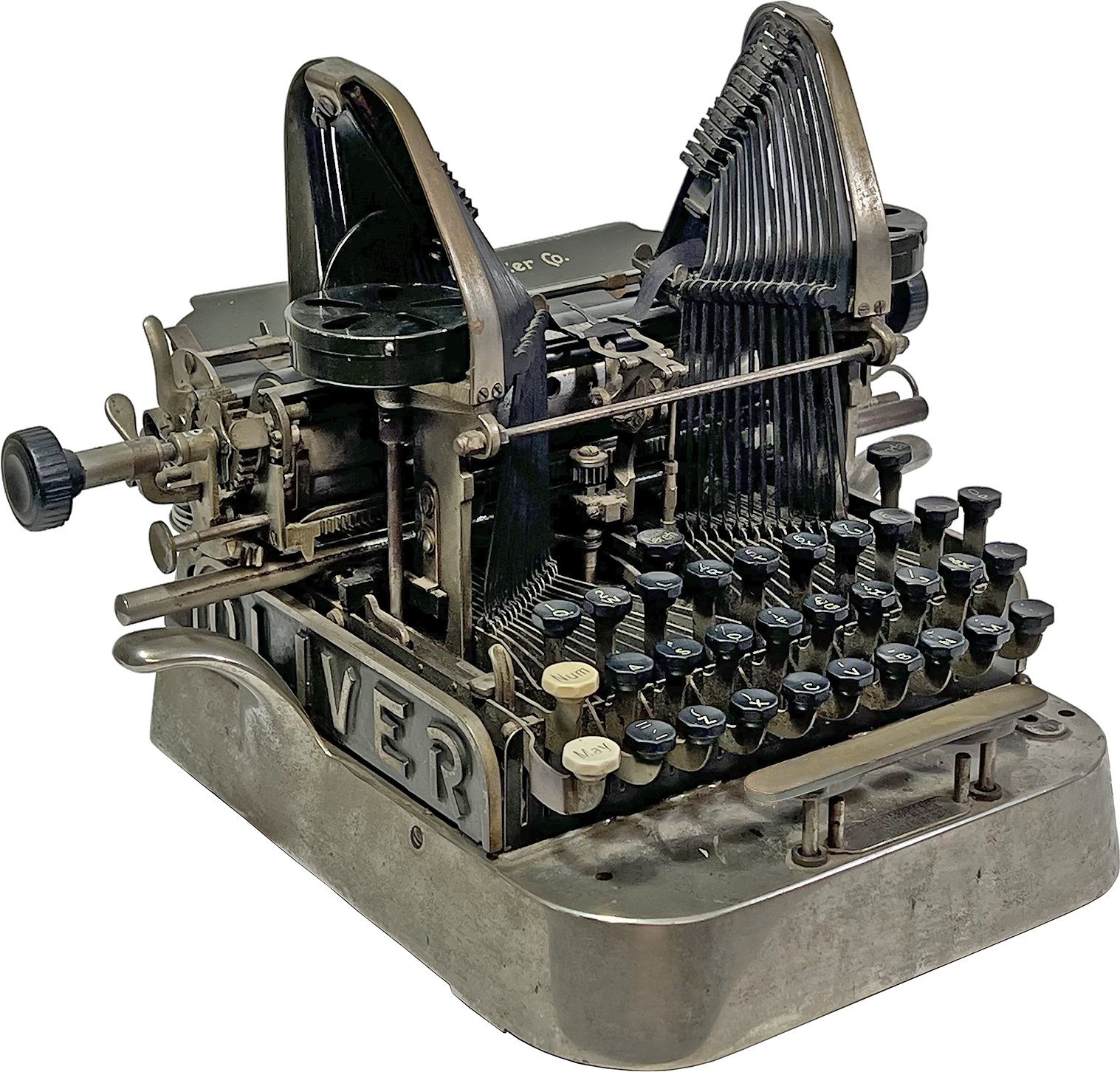
Oliver (Latina) No. 5
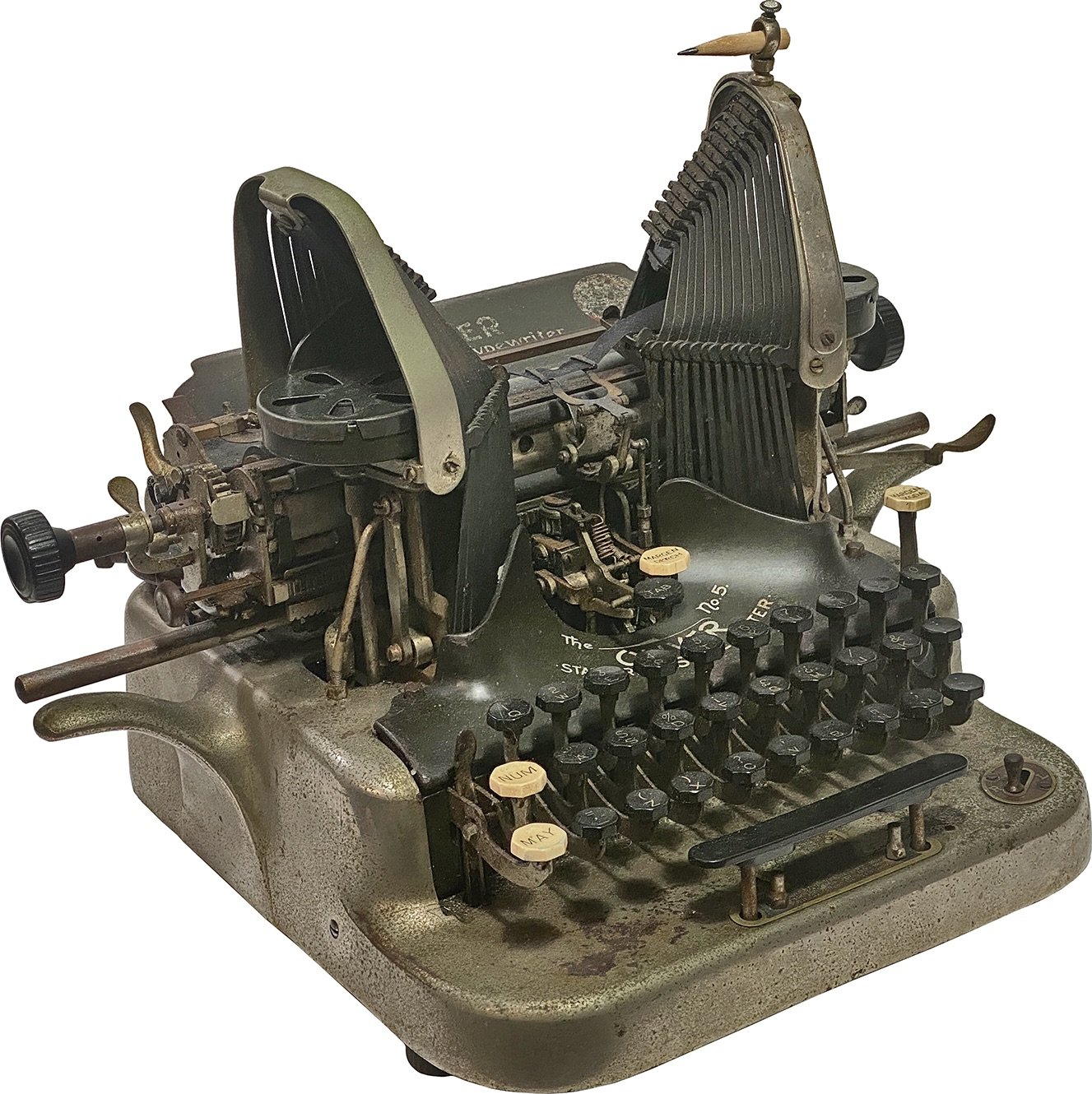
Oliver (Latina) No. 6
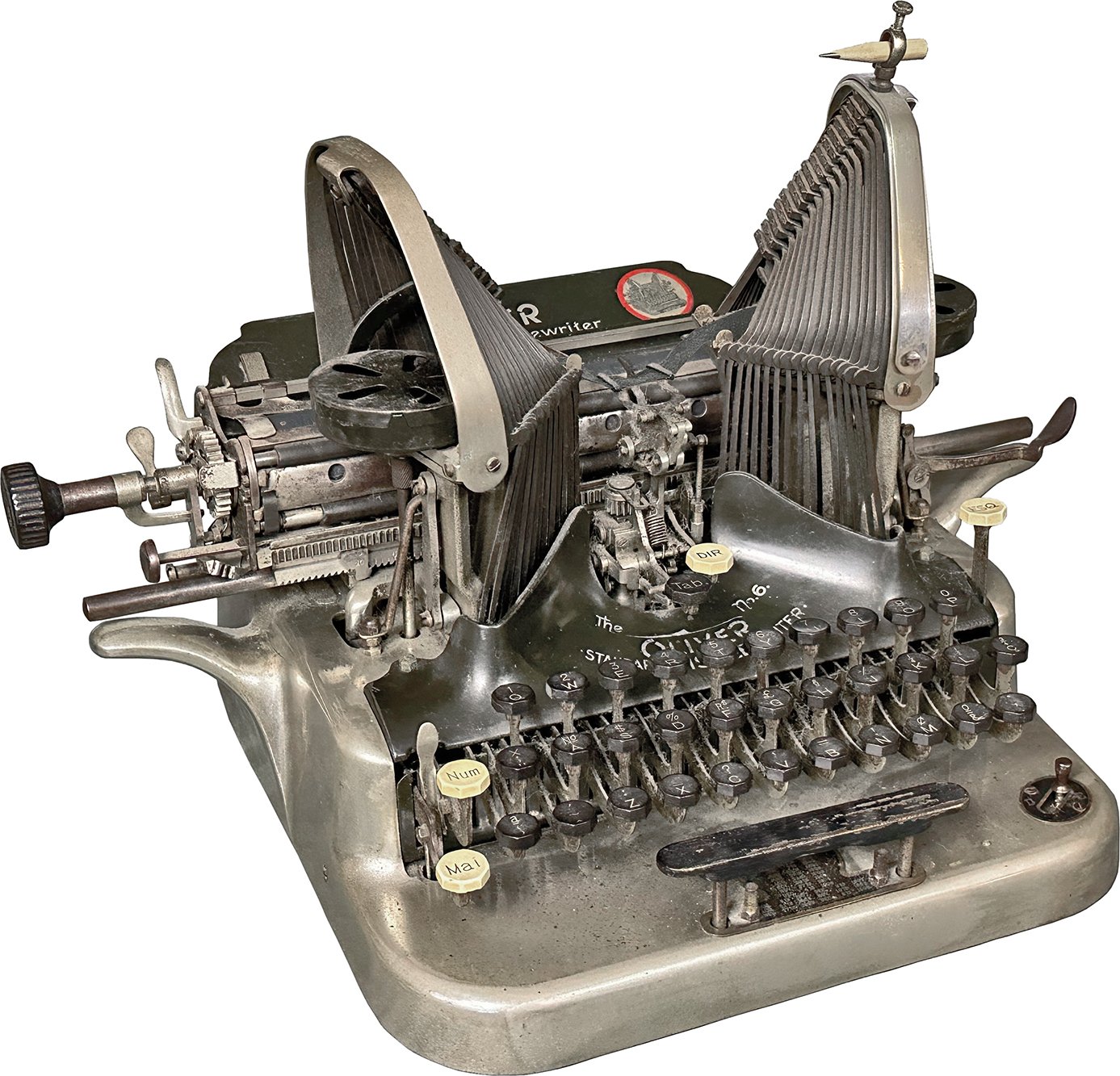
Oliver (Latina) No. 7
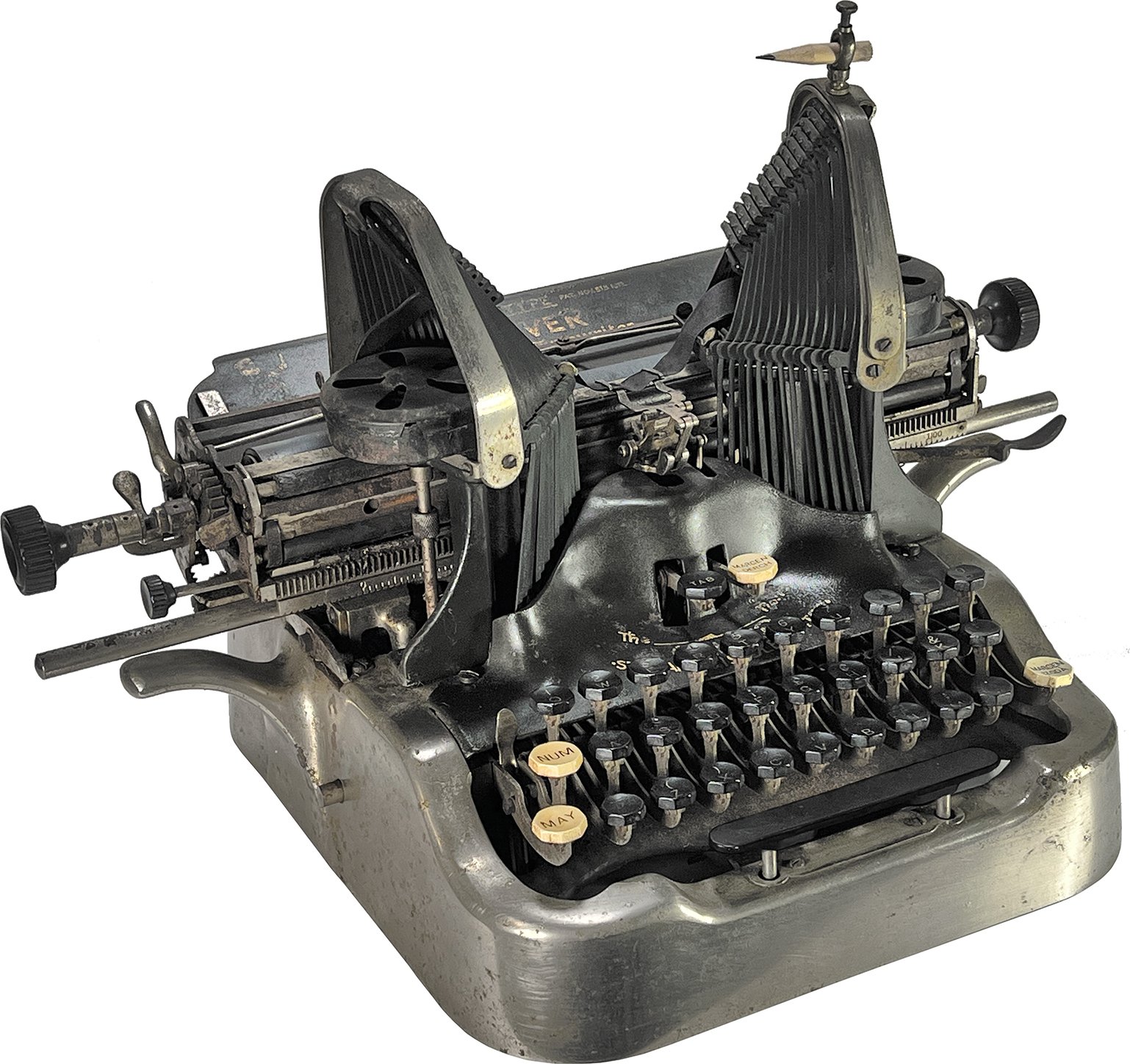
Oliver No. L-10
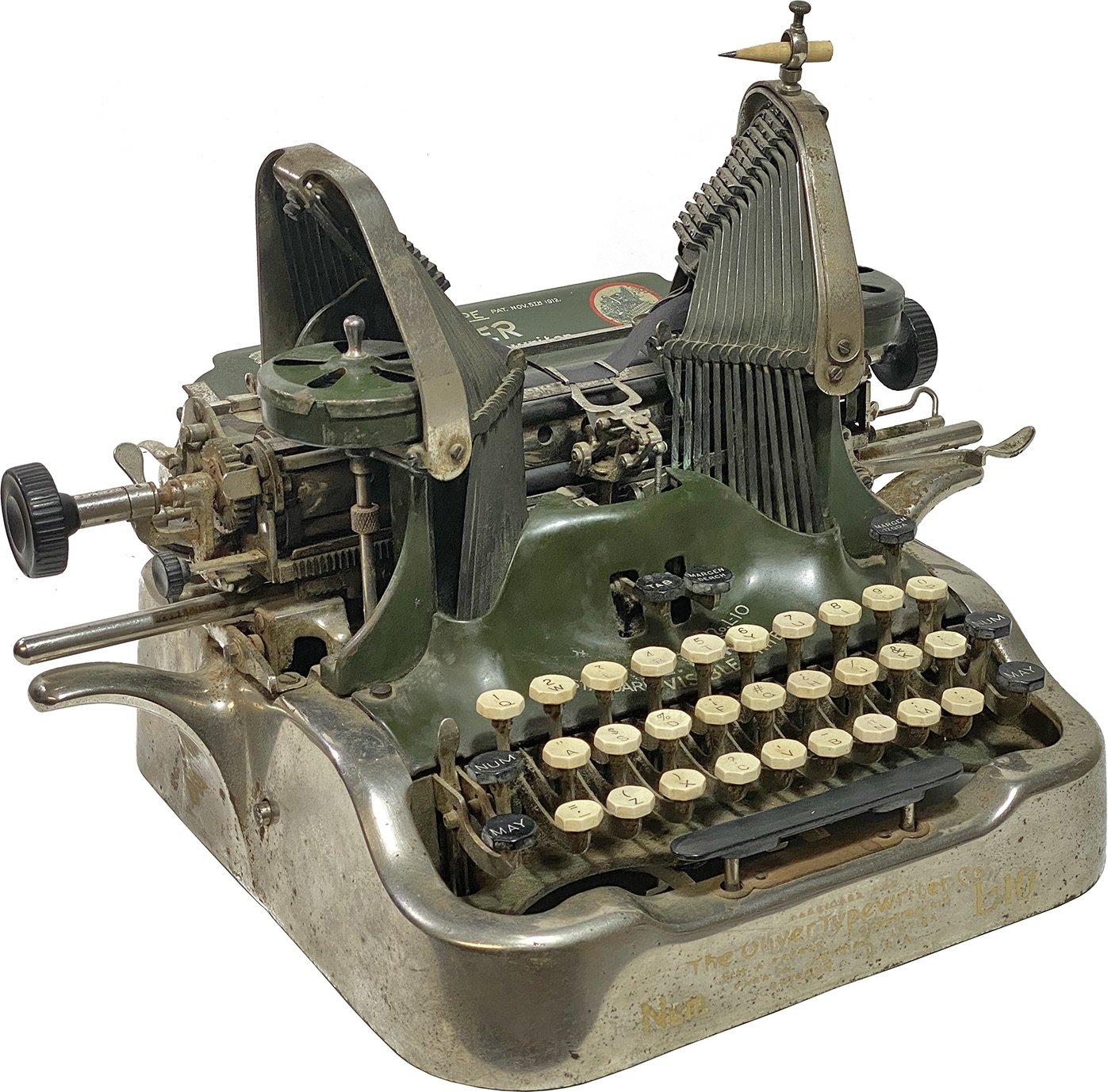
The Oliver No. 9 was rebranded for Latin America as the Oliver No. L-10. Some versions have no branding below the keyboard, while others have a decal (as seen above) or red plaque. Some Oliver No. L-10 machines were painted olive green by special order.
Oliver No. L-12
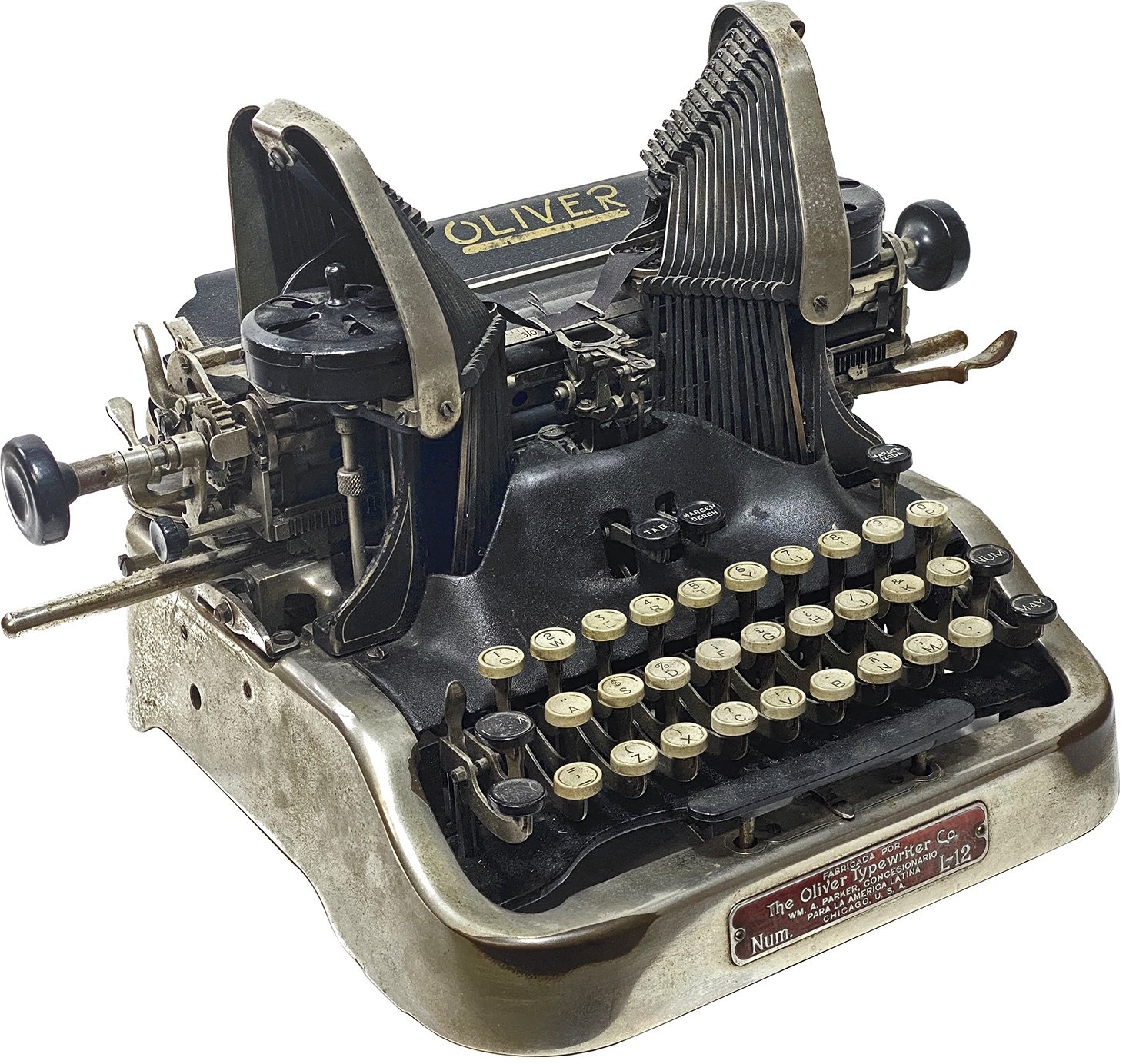
The Oliver No. L-12 was the original Latin American version of the Oliver No. 11. The No. L-12 and previous Latin American models manufactured in the United States were distributed by Compania Parker S.A., as mentioned on the rear plaque of the machine. This plaque also describes the No. L-12 as a silent model.
Oliver No. L-13
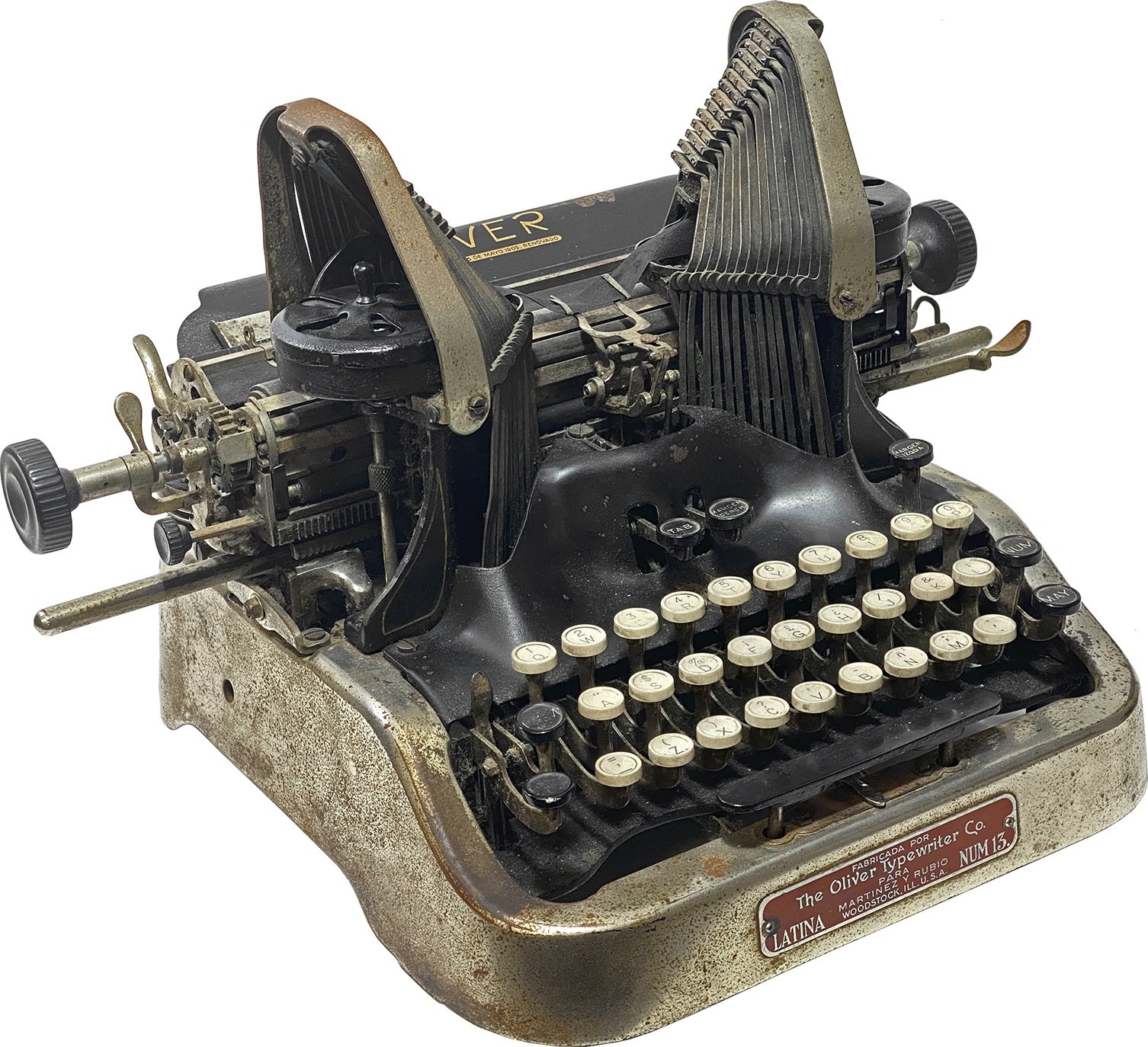
Towards the end of production of the Oliver No. 11, the No. L-12 was replaced by the No. L-13 because the distributer changed from Compania Parker S.A. to Martinez y Rubio. The Oliver No. L-13 displays front and rear plaques just like the No. L-12, but now reflect the new distributor. The rear plaque no longer describes the machine as a silent model.
German
Fabrik Stolzenberg, Deutsche Einrichtungs-gesellschaft m.b.H. was the primary distributor of Oliver typewriters in Germany. The company, owned by Gustav Metz, was based in Oos, Baden-Baden, with subsidiaries in Berlin, Cologne, and Hamburg. All Oliver machines distributed by Fabrik Stolzenberg have white margin release keys as opposed to black. Following Fabrik Stolzenberg’s Oliver typewriter distribution success, a special company dedicated to German Oliver distribution, Oliver Schreibmaschinen Gesellschaft mbH, was founded by Dr. Gustav Metz. This new company was based in Berlin and managed by Karl Friedrichs.
Monopol-Stolzenberg No. 2
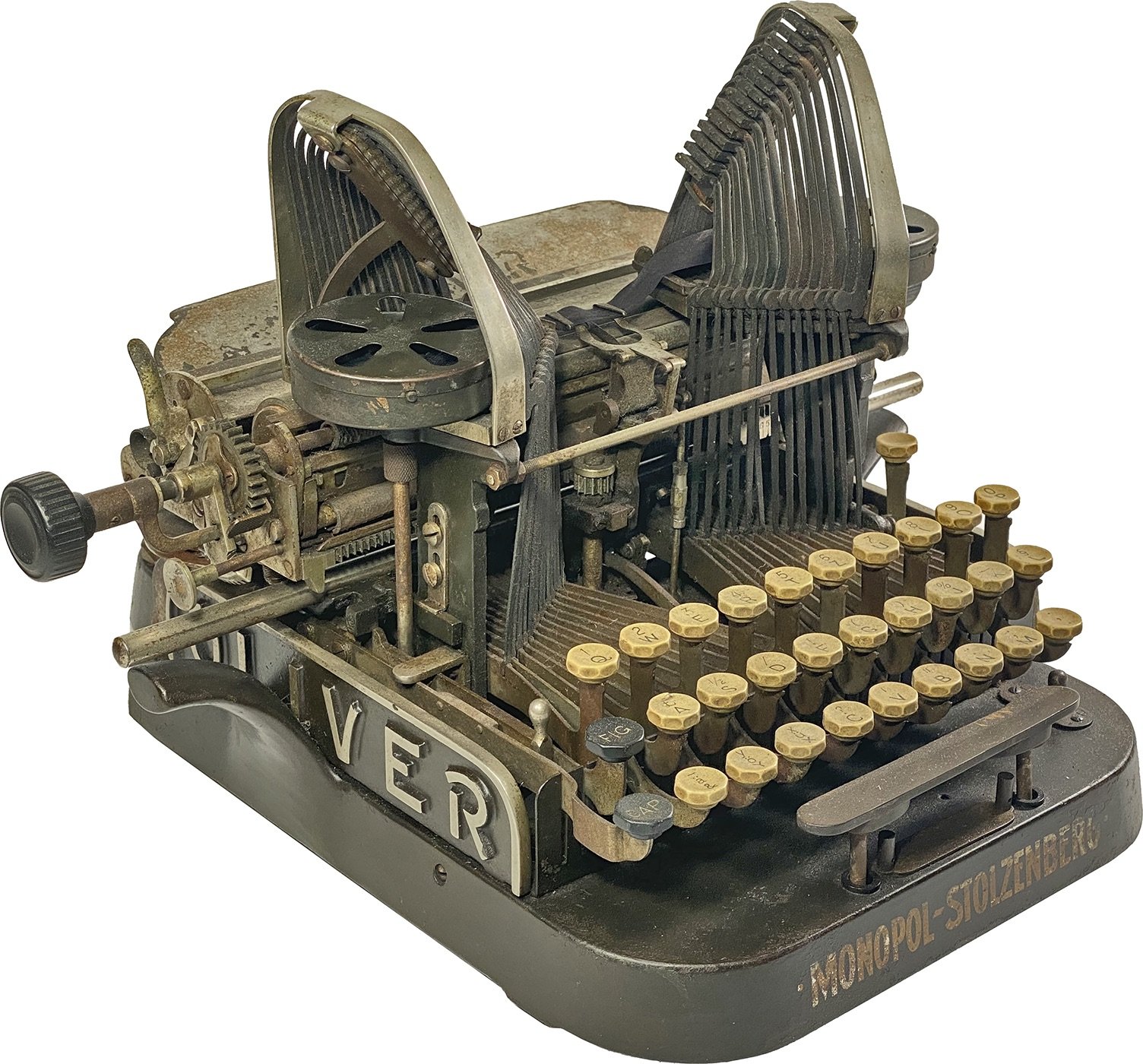
Unlike domestic Oliver No. 2 machines, the Monopol-Stolzenberg No. 2 machines distributed by Fabrik Stolzenberg were equipped with margin release keys.
Monopol-Stolzenberg No. 3
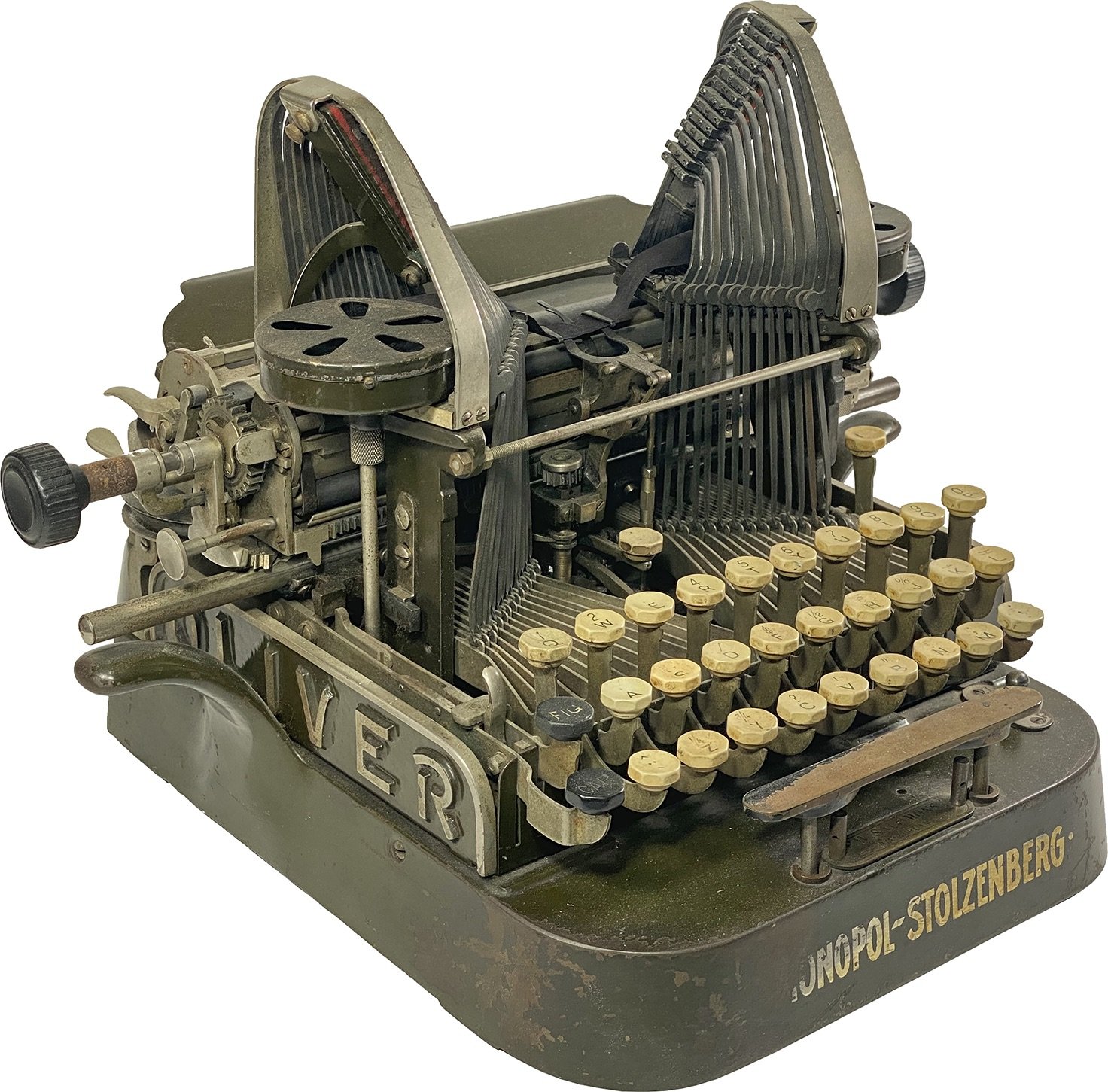
The Monopol-Stolzenberg name initially carried over from the No. 2 to the No. 3.
Oliver Stolzenberg No. 3
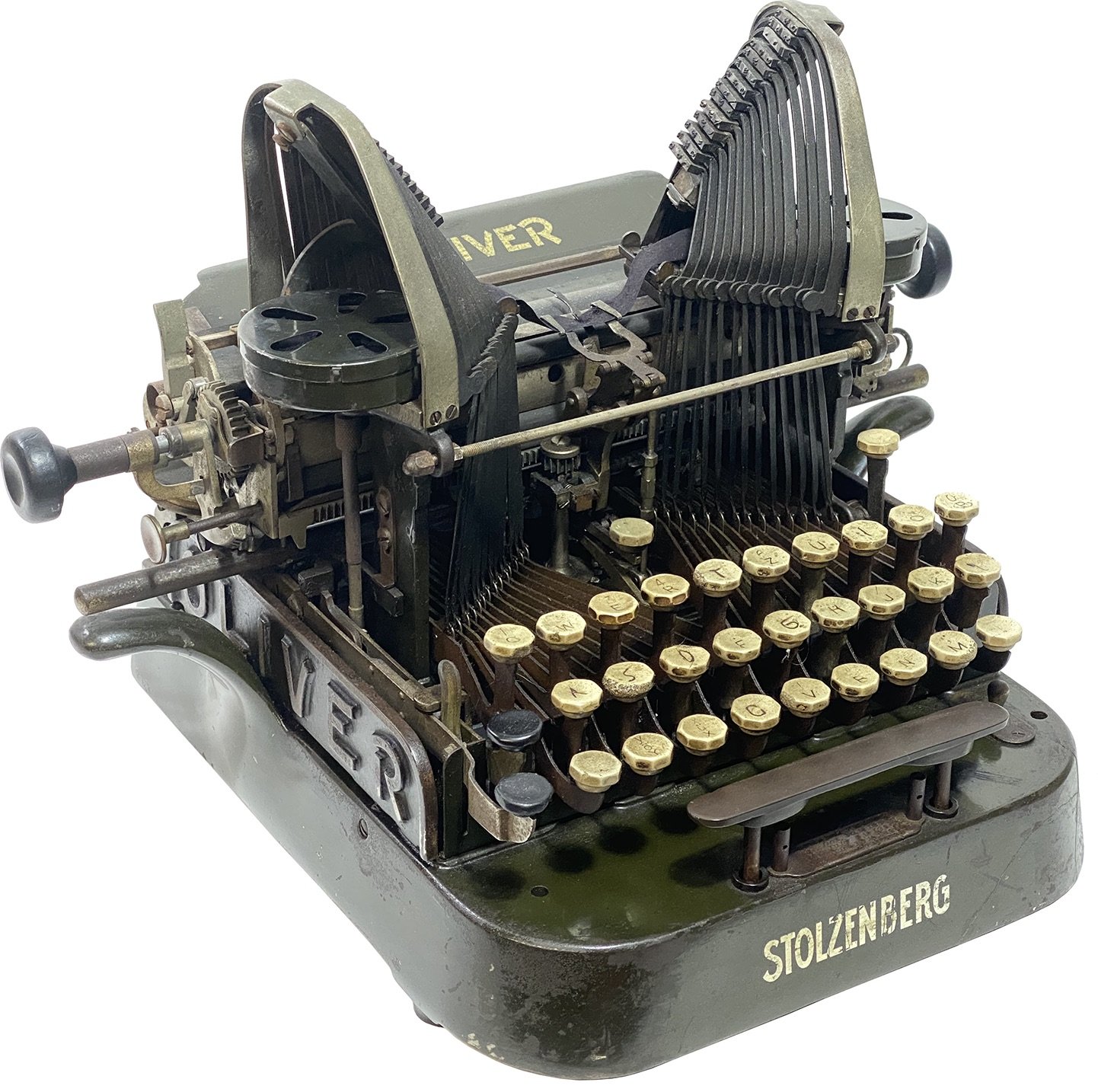
Eventually, the Monopol portion was dropped from the Monopol-Stolzenberg No. 3, resulting in a Stolzenberg No. 3. Fabrik Stolzenberg also distributed the Oliver No. 4 as the Stolzenberg No. 4. The style of the front decal is different from the Stolzenberg No. 3. This style was also used on Russian Oliver No. 4 machines.
Oliver Stolzenberg No. 4
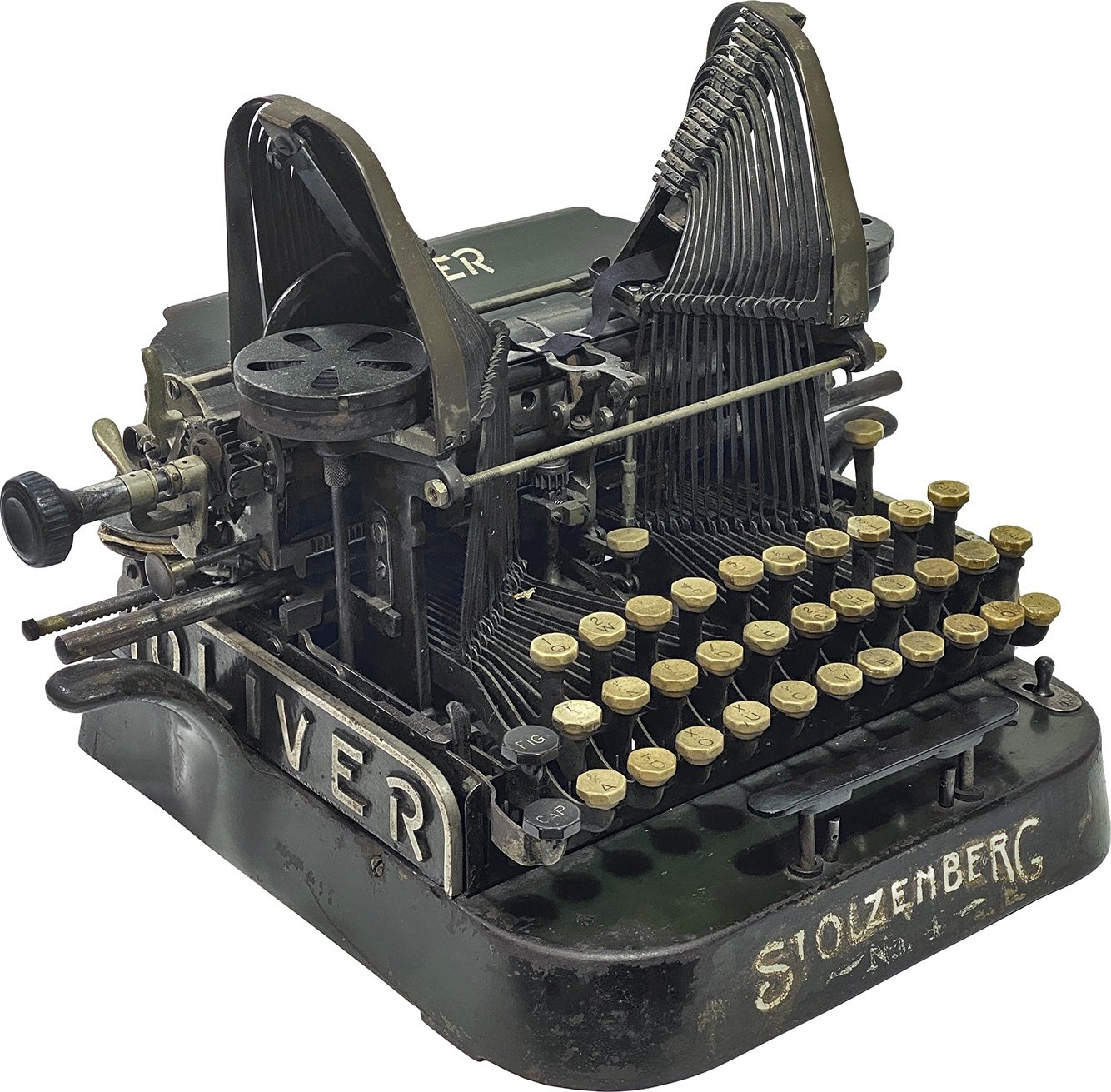
Fabrik Stolzenberg distributed the Oliver No. 4 as the Stolzenberg No. 4. The front decal style, differing from the Stolzenberg No. 3 decal, was also used on Russian Oliver No. 4 machines.
Oliver Schreibmaschinen Gesellschaft No. 3
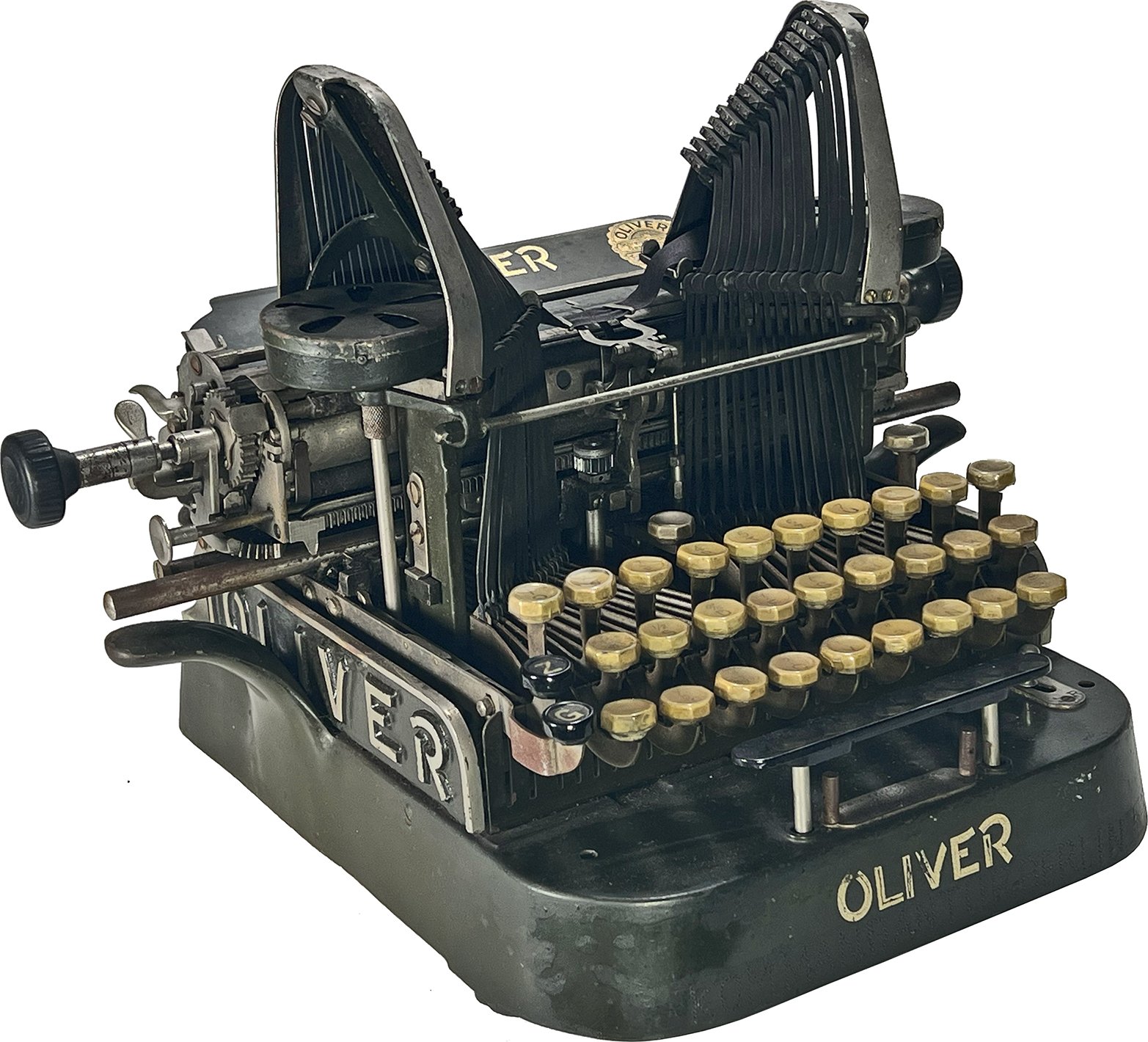
Oliver Schreibmaschinen Gesellschaft No. 5
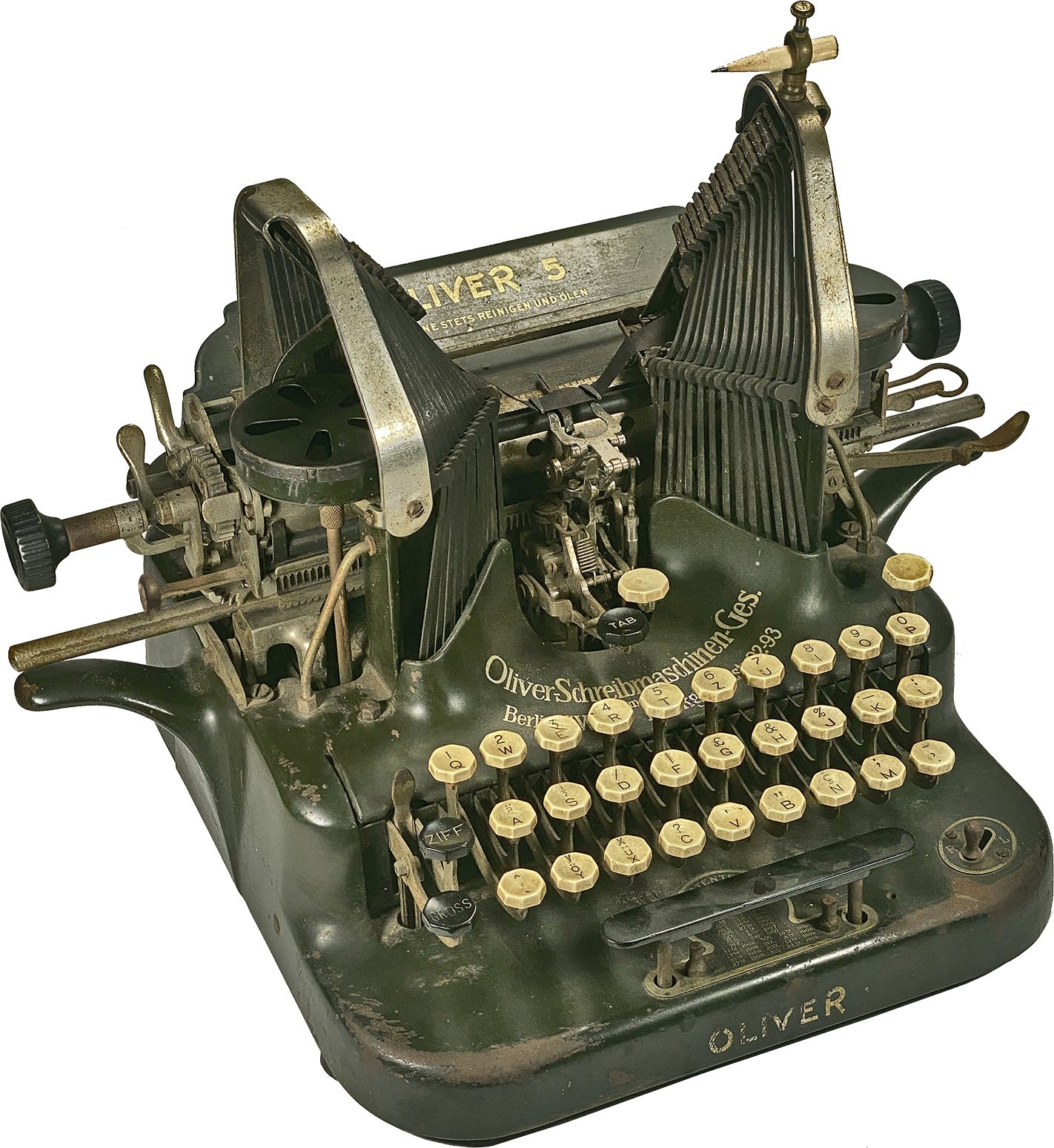
In 1909, to upsize their offices and showrooms, Oliver Schreibmaschinen Gesellschaft mbH relocated from Charlottenstraße to Markgrafenstraße 92–93. Some machines distributed by this firm display Oliver Büromaschinen Gesellschaft as the distributor, located at either Markgrafenstraße 76–77 or Markgrafenstraße 92–93.
Austrian
A bicycle manufacturer in Vienna, Austria known as A. Greger & Company produced the Oliver No. 3 as the Courier, Jacobi, and Jwic from 1903 to 1919. Pre-manufactured parts were being assembled until 1927. When the Oliver No. 5 was introduced in the United States, the type guards and ribbon reverse of these Austrian machines used the new Oliver No. 5 style. In addition, a backspacer was added to the Austrian machines once it was introduced on the Oliver No. 5.
Courier
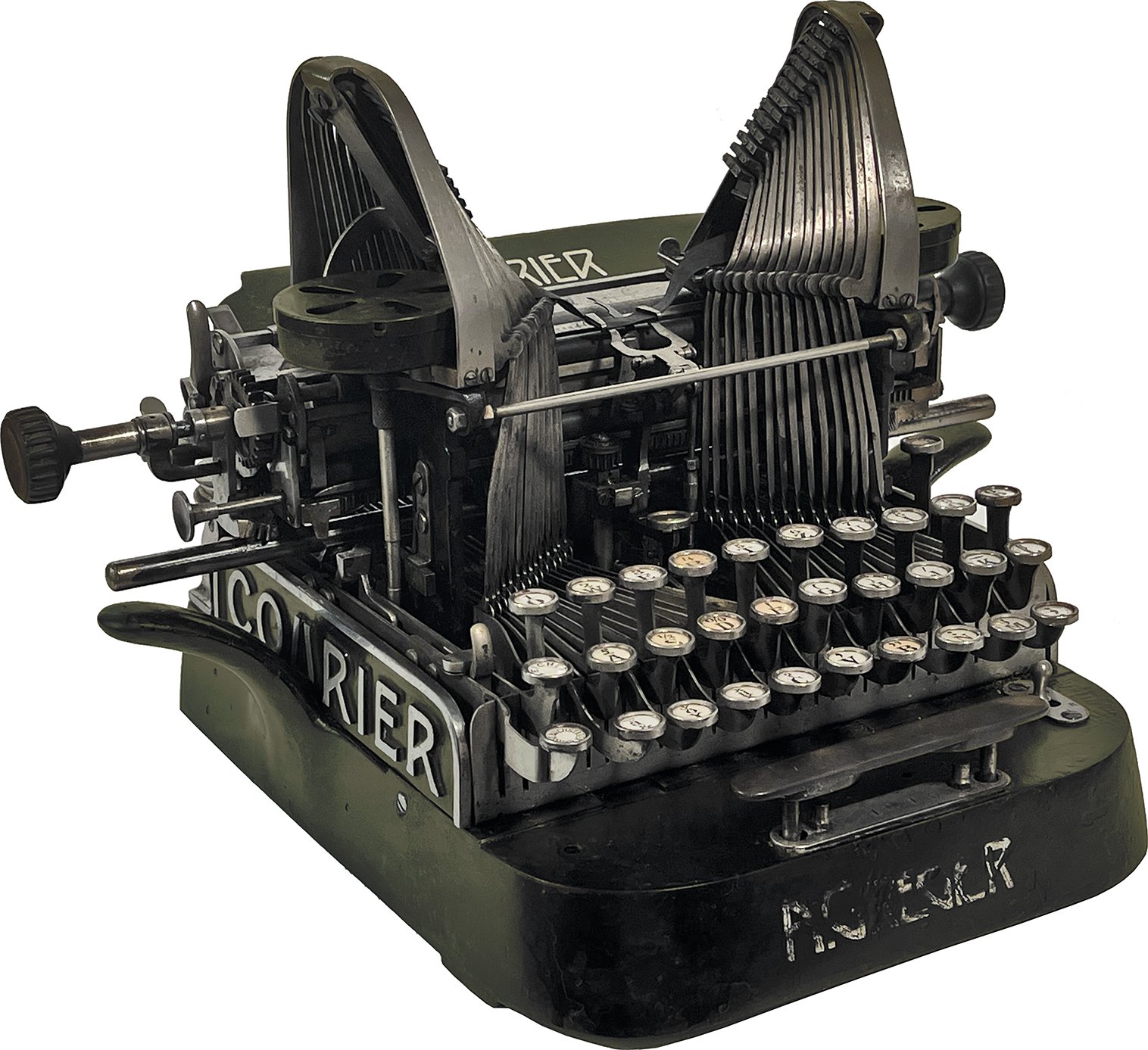
The olive green finish was eventually discontinued in favor of black. At this time, the Courier’s paper table decal was updated to display The Courier Typewriter as opposed to Courier.
Jacobi
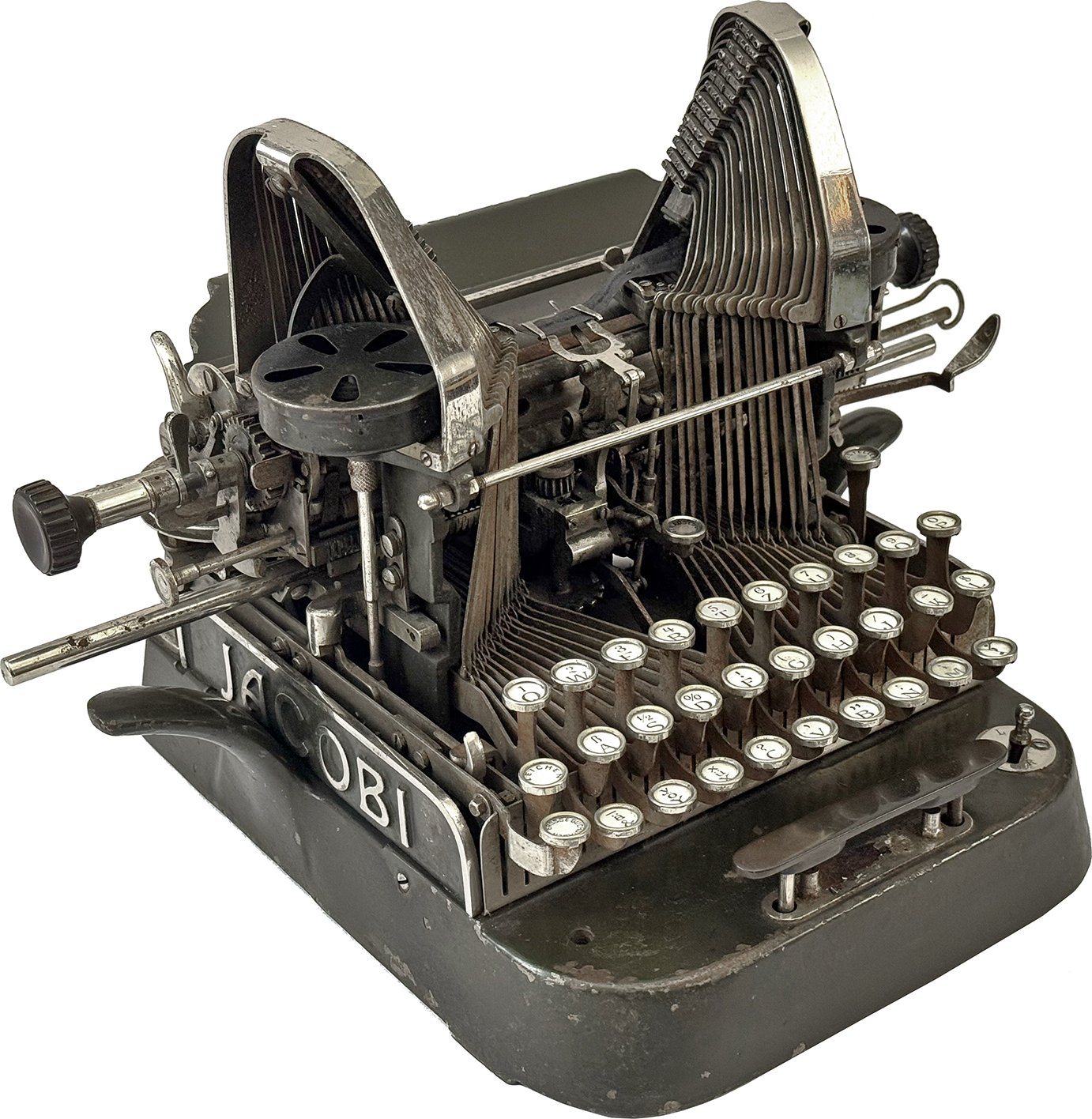
A variant of the Courier was produced for a German office equipment dealer in Munich under the name Jacobi, which was also the name of the sewing machine division of A. Greger & Company.
Jwic
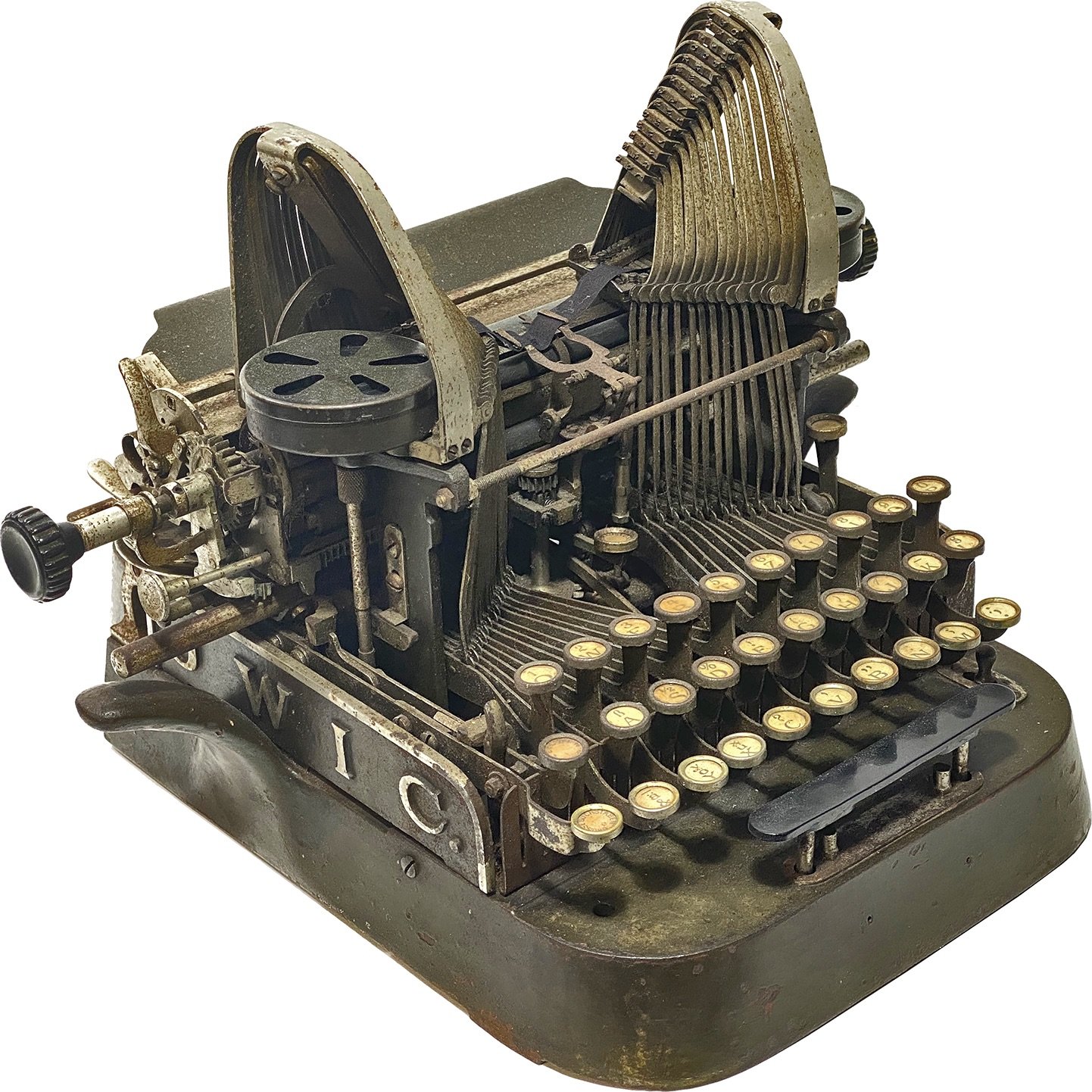
A Czech variant of the Courier was produced as the Jwic.
Four Bank Desktops
Four Bank Prototype
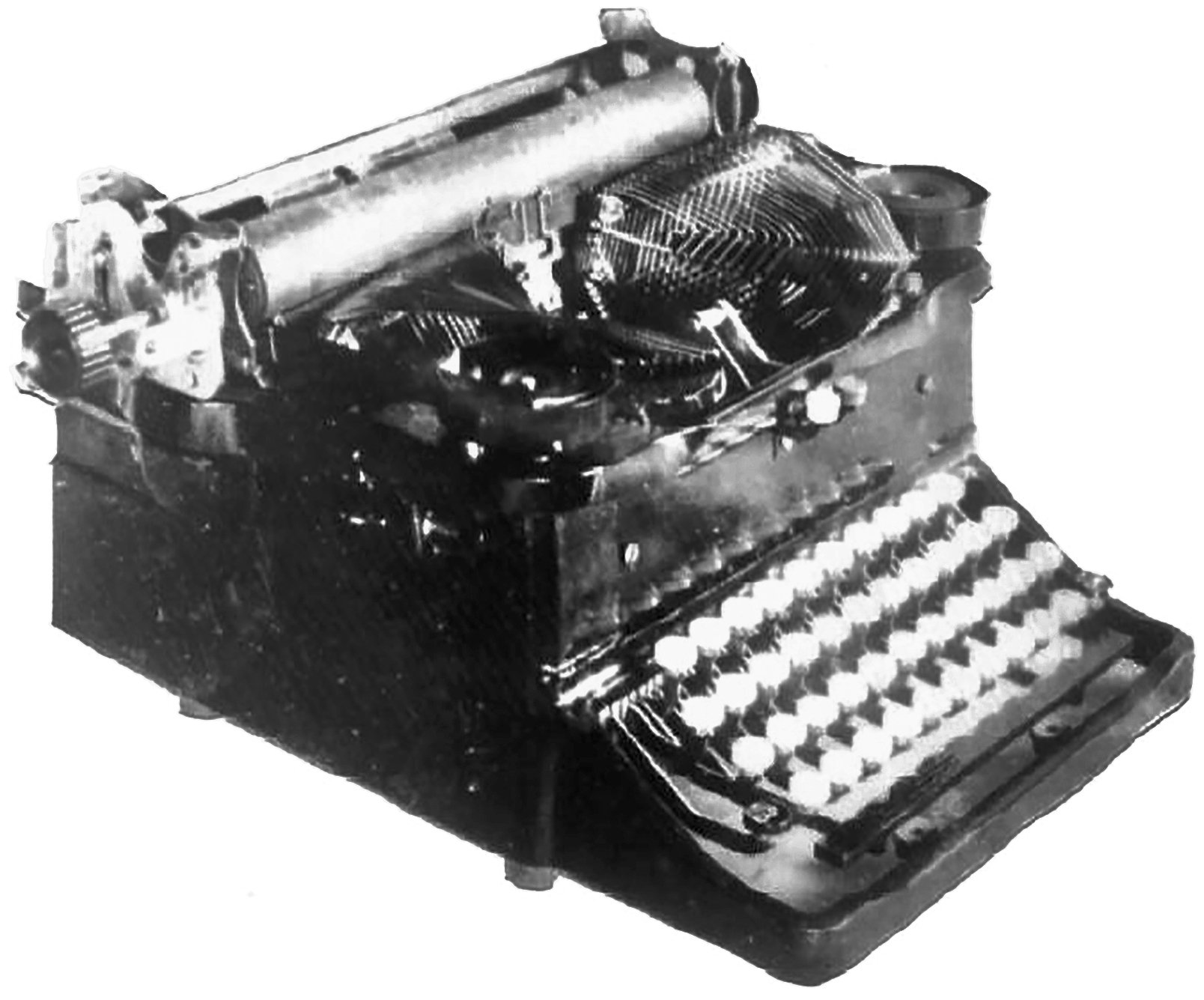
The first instance of a four-bank Oliver (an Oliver with four rows of keys) occurred in 1922, when Theron Knapp, chief design engineer of The Oliver Typewriter Company, presented to the Oliver Board of Directors his new four-bank typewriter prototype. This machine was designed to resemble typewriters of other brands on the market at the time. It still featured the iconic Oliver typebars, but they were angled to swing towards the platen from the front instead of downward. Despite its novel design, the prototype never reached production, likely due to the Depression of 1921–1922.
Oliver Four Bank
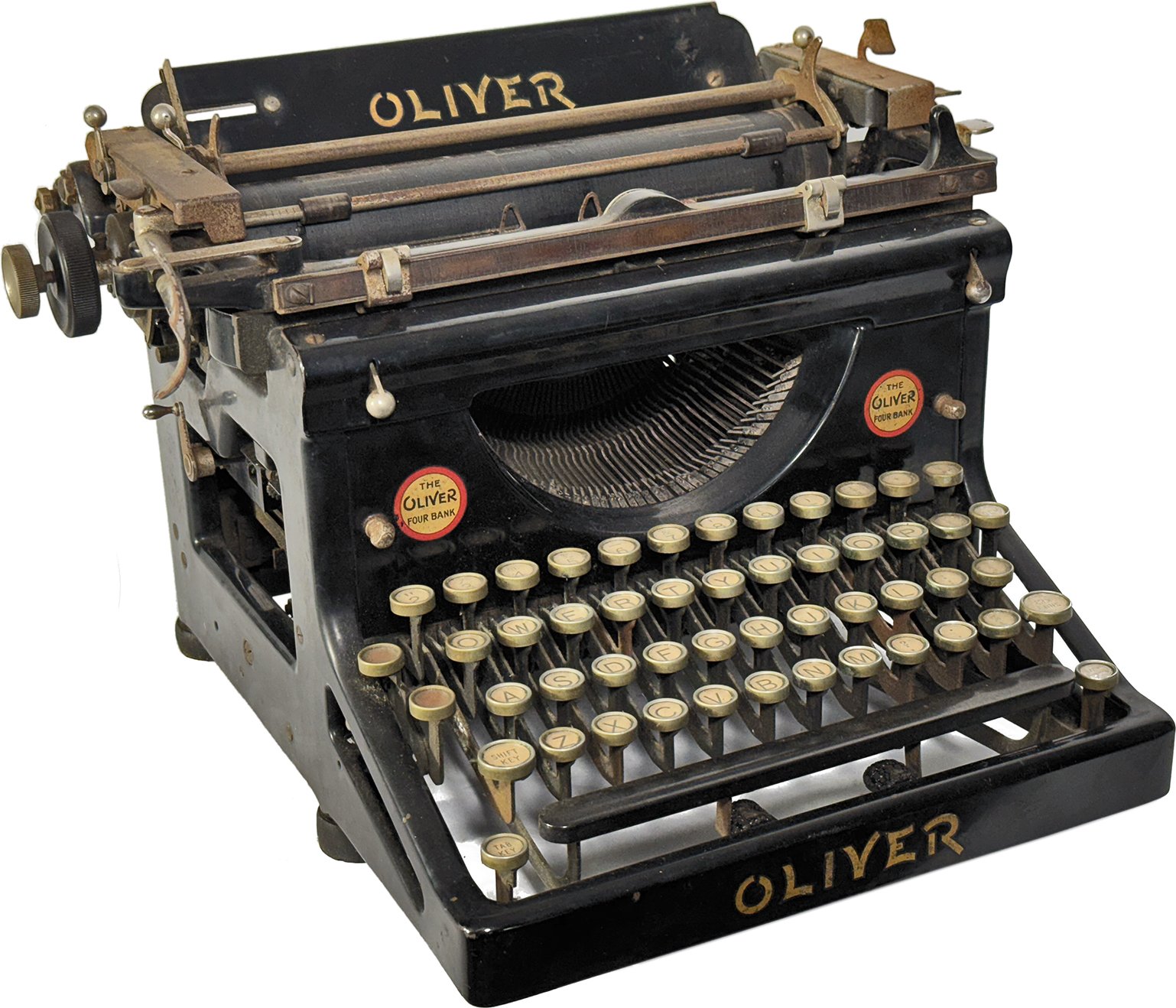
The first commercially available four-bank desktop Oliver was sold by British Oliver from 1931 to 1935. The Fortuna IV was rebranded and sold as the Oliver Four Bank, without any model number designation. Parts were manufactured by Fortuna Büromaschinen GmbH in Berlin, Germany, while the machines were assembled at the Oliver factory in Croydon, England.
Oliver No. 20
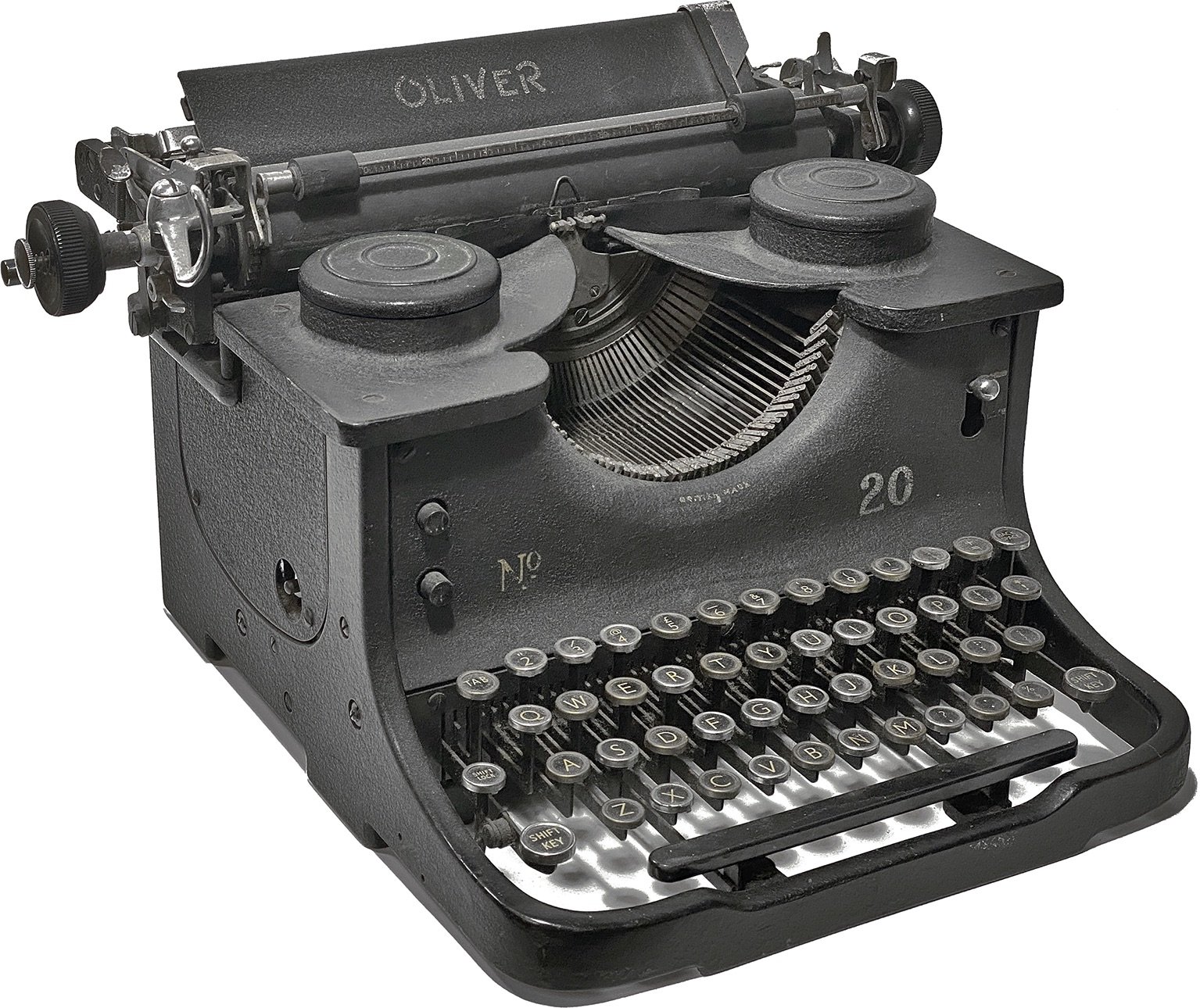
The Oliver Four Bank was replaced by the Oliver No. 20, a rebranded Halda-Norden No. 5, manufactured in Svängsta, Sweden. When the No. 20 was first introduced, it was sometimes advertised as an Oliver Four Bank without a model number. Early production Oliver No. 20 machines display "The Oliver Four Bank" in the iconic red Oliver circle, "The British Oliver" on the paper table, "BRITISH MADE THROUGHOUT" around the curve of the type basket, and "OLIVER 20" on the frame below the keyboard. Late production Oliver No. 20 machines display "BRITISH MADE" around the curve of the type basket, "OLIVER" on the paper table, and No. 20 above the keyboard.
Oliver No. 21
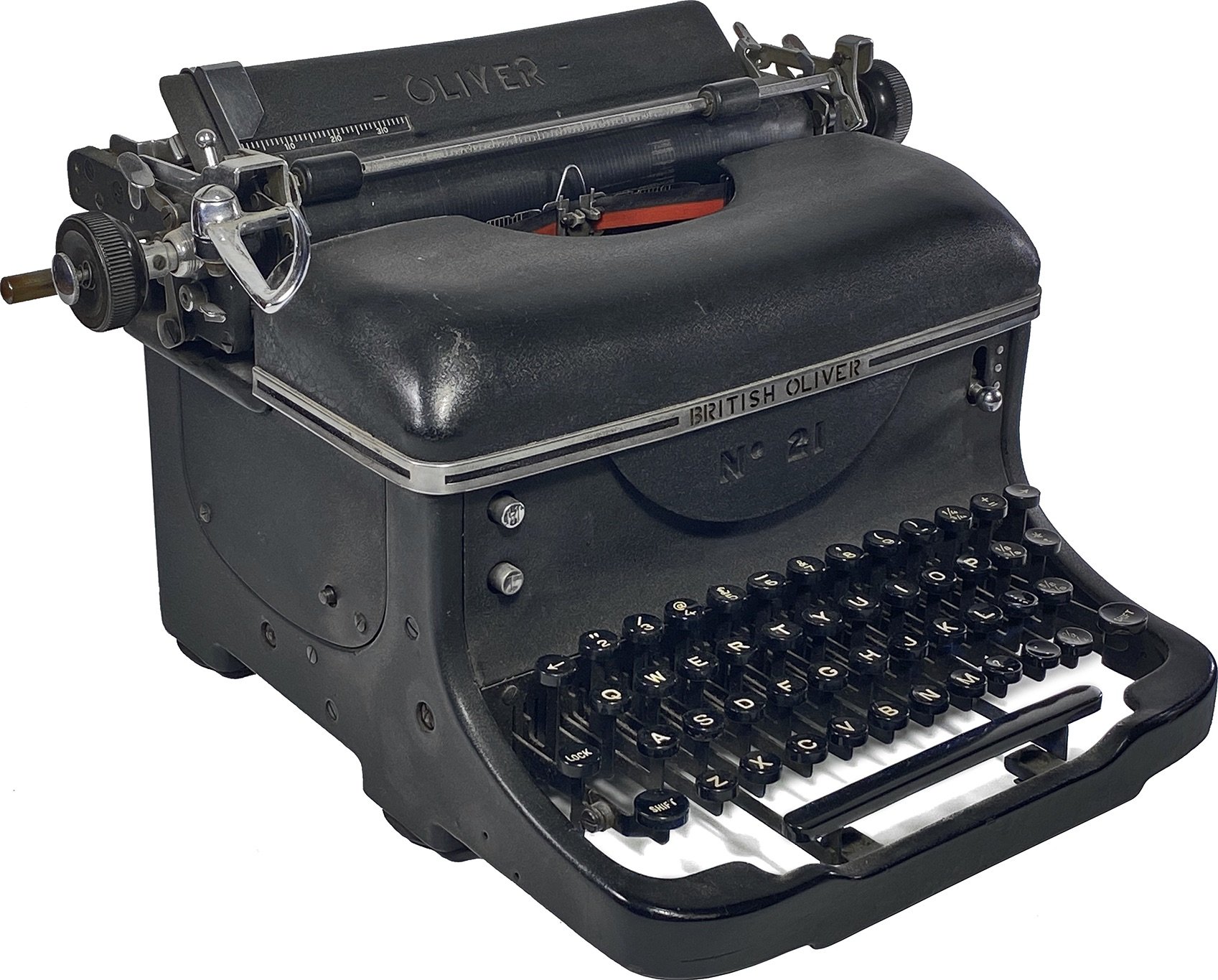
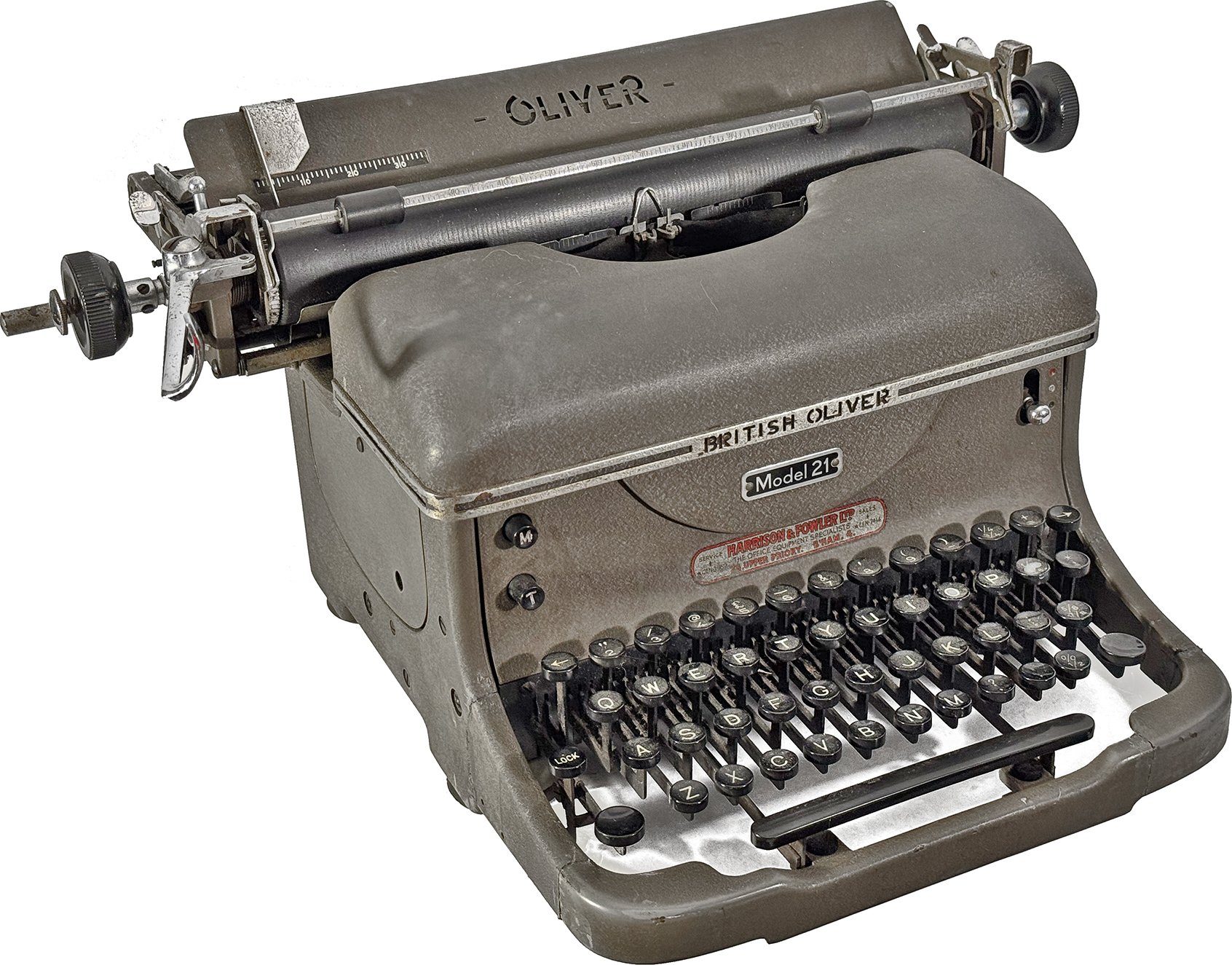
The successor to the Oliver No. 20, a rebranded Halda-Norden No. 5, was the Halda No. 6, rebranded as the Oliver No. 21. It was manufactured at the Halda-Norden factory in Svängsta, Sweden. Initially, the Oliver No. 21 machines were black with a debossed model number above the keyboard. Late production Oliver No. 21 machines were produced in gray and have a plaque that displays Model 21.
Portable
Europa/SIM
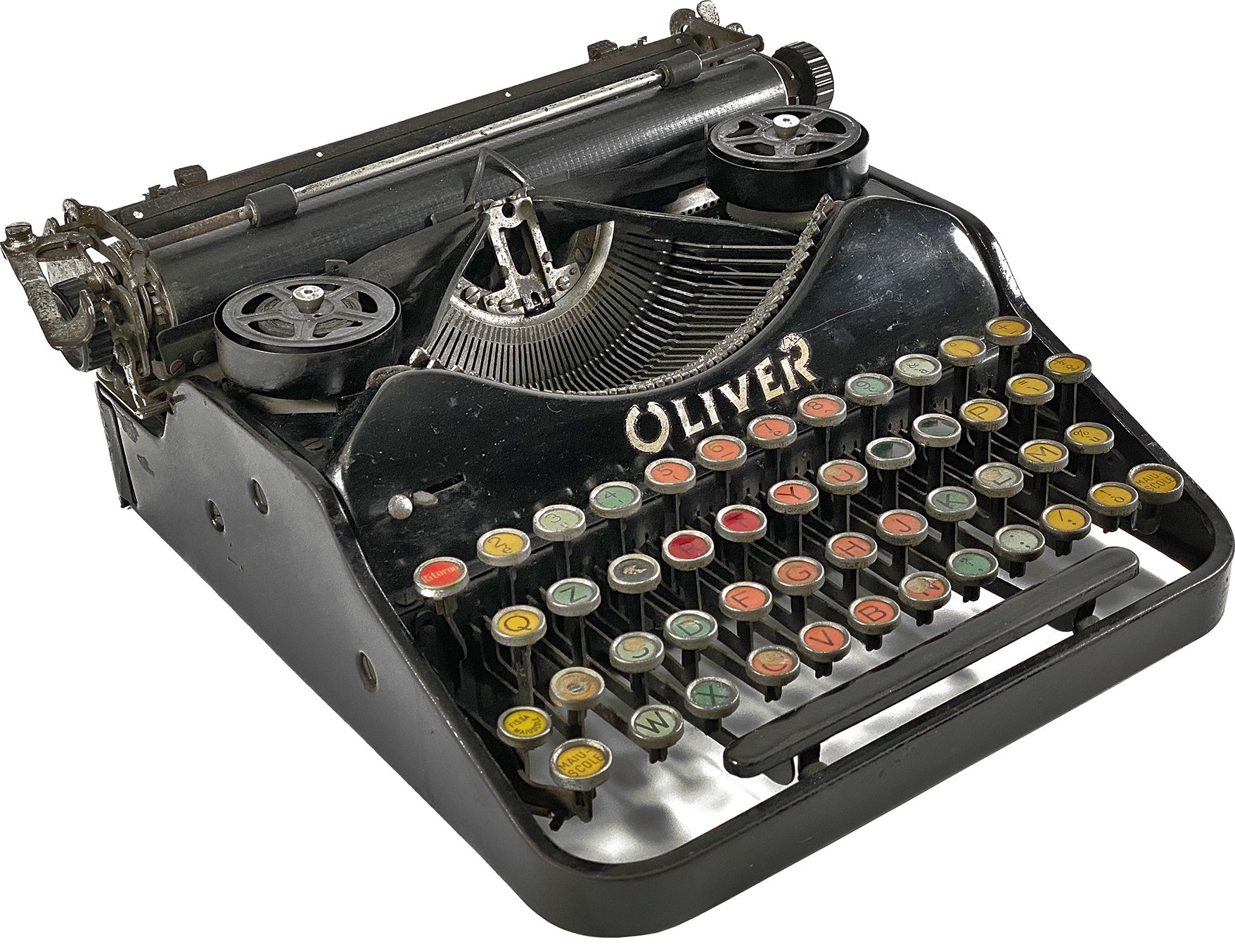
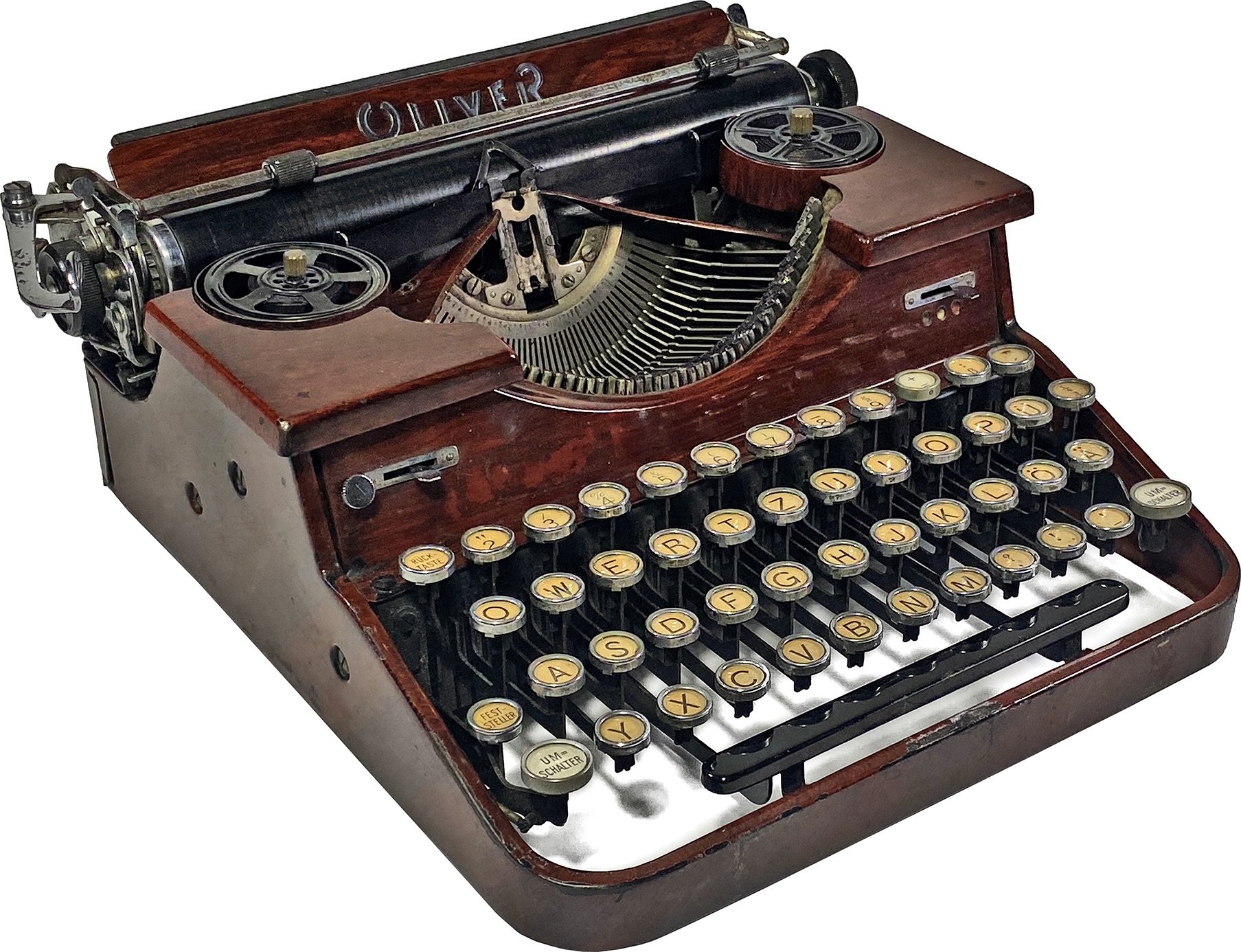
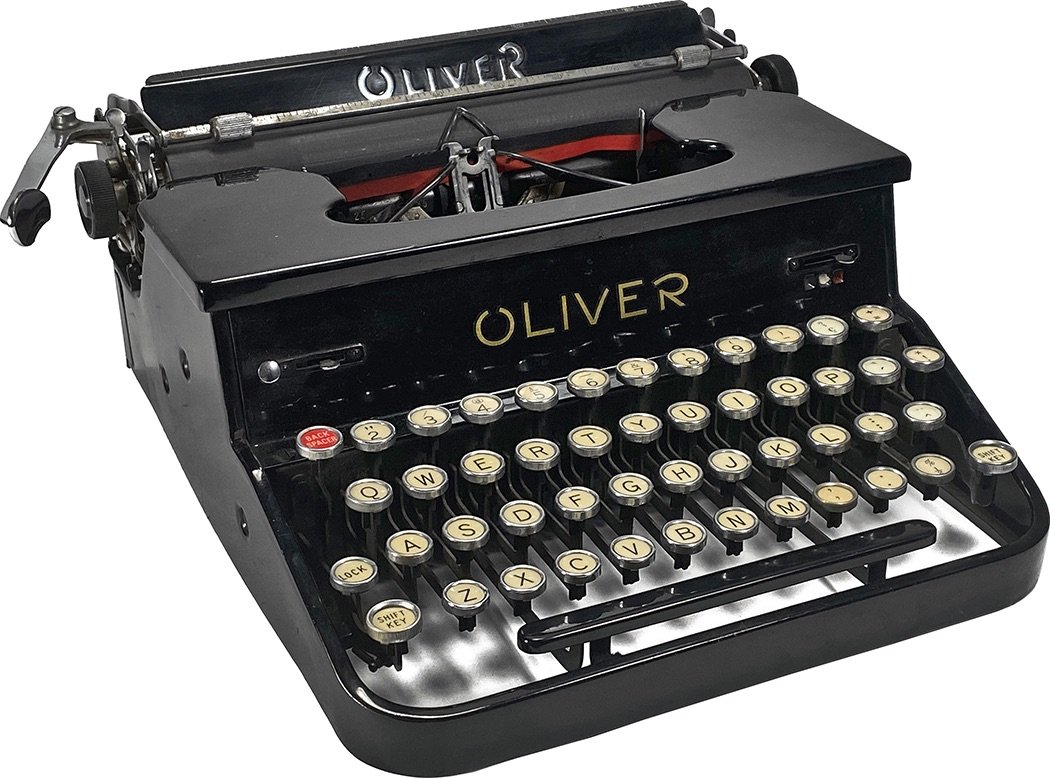
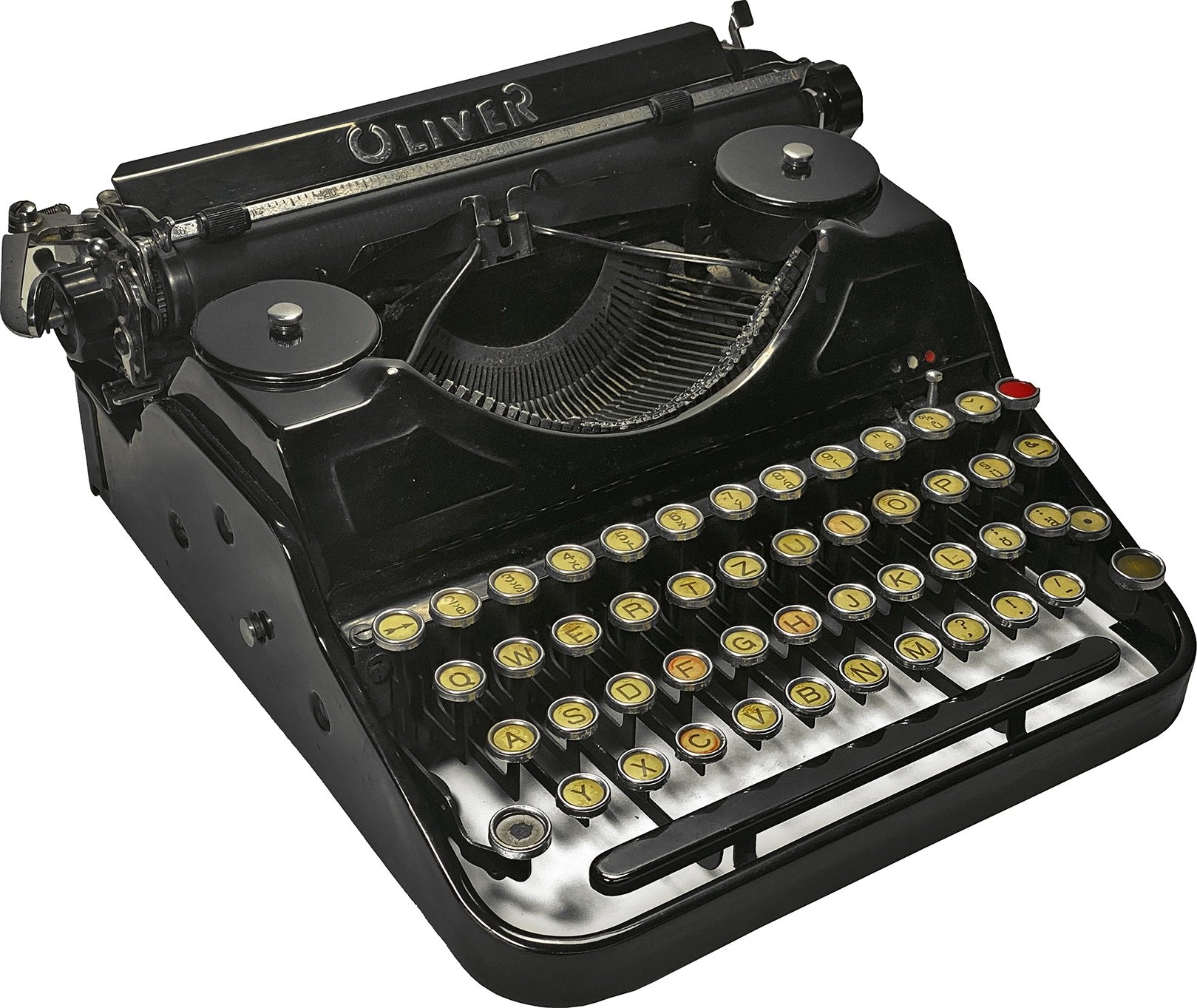
In the early 1930s, manufacturing began for the first of many four-bank portable typewriters by Europa Schreibmaschinen AG and Fortuna Büromaschinen GmbH, both based in Berlin. In Italy, these machines were manufactured by Oliver Typewriter (Italy) Ltd. of Milan and Società Industriale Meccanica (SIM) of Turin. These machines were branded and marketed under a plethora of names, including Oliver.
Patria
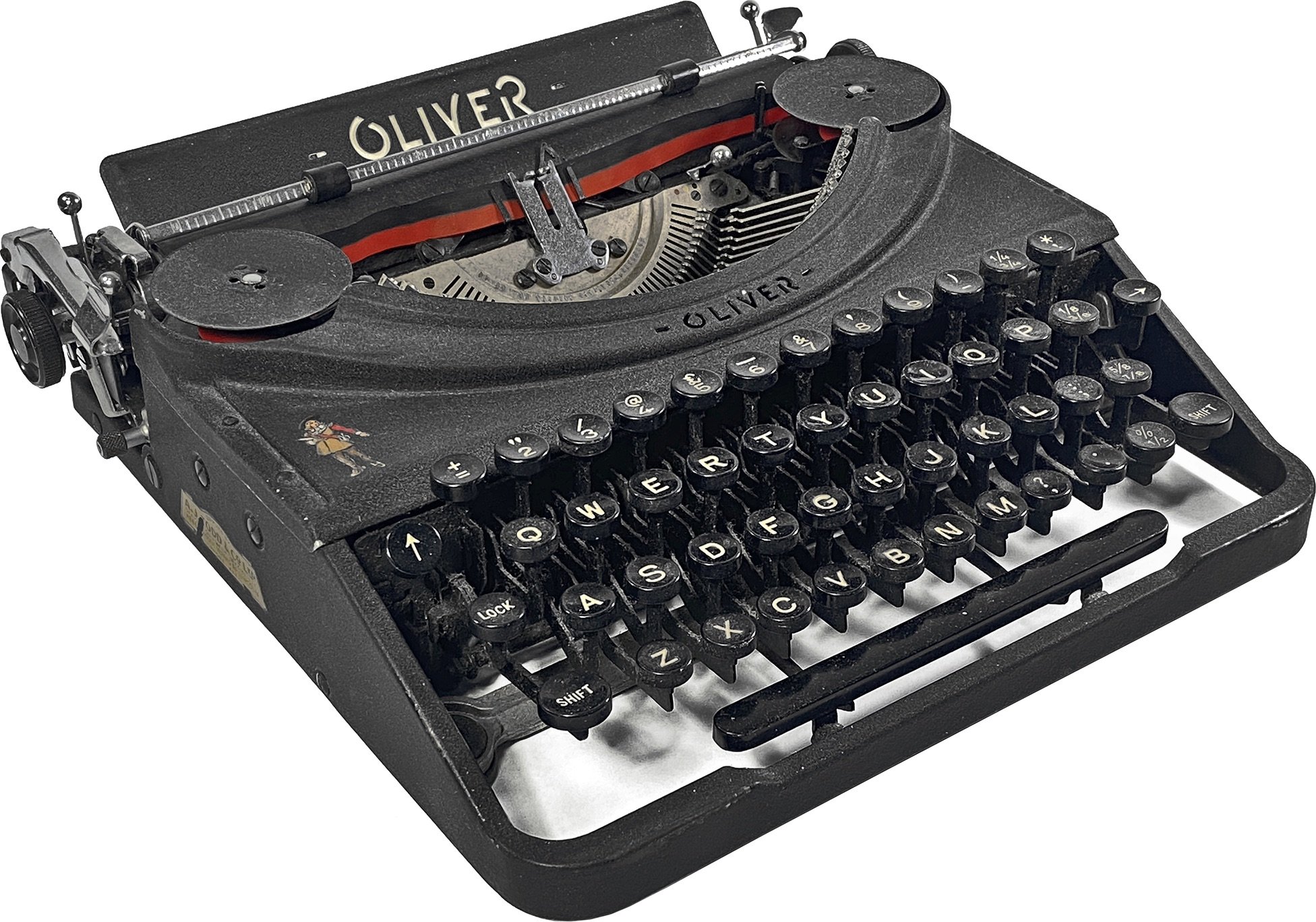
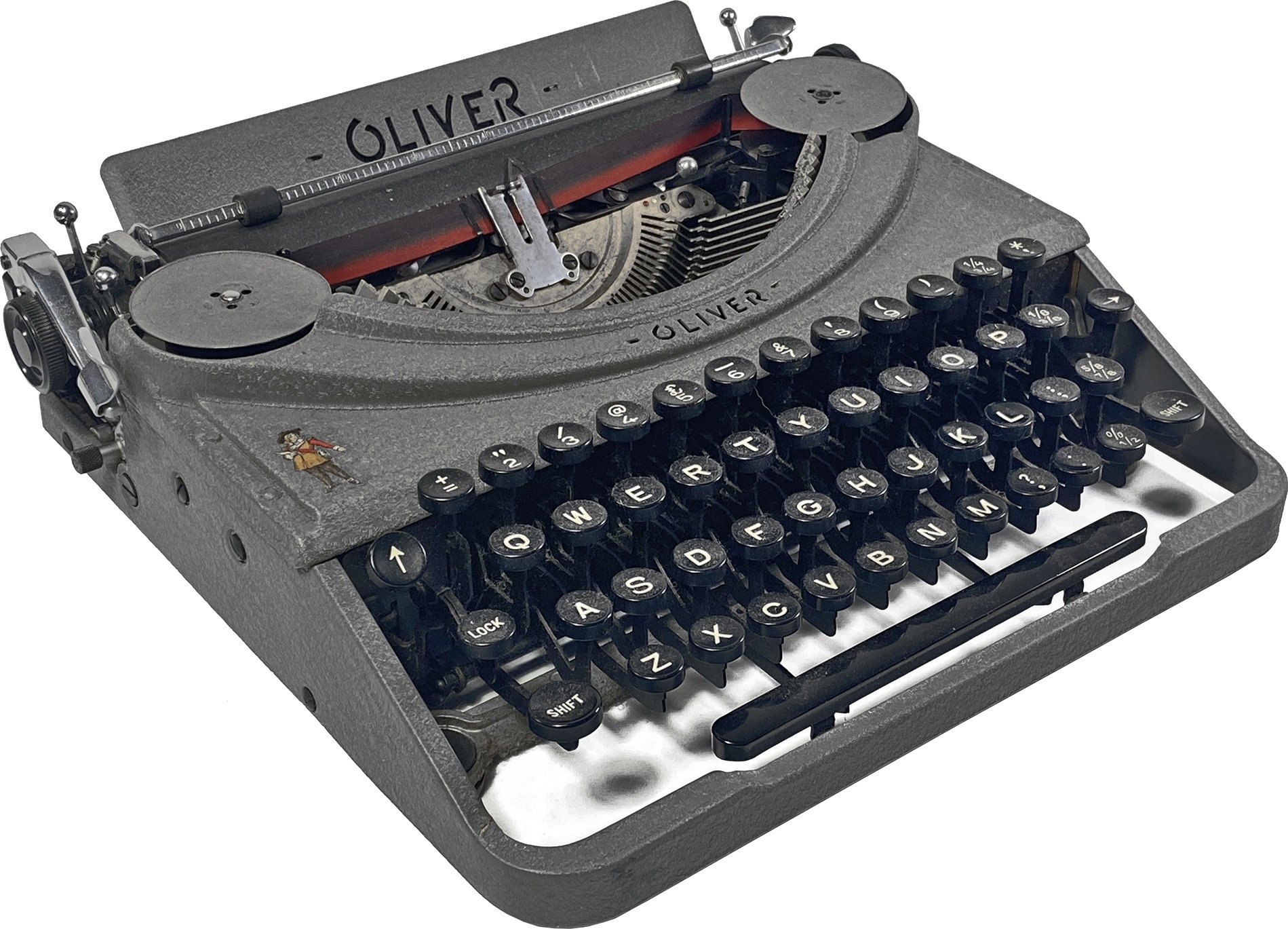
From 1948 to 1954, the Oliver Portable was a rebranded Patria produced by August Birchmeier’s Söhne in Canton of Aargau, Switzerland. Early iterations were only offered in black with ring-and-glass keys and an Oliver decal above the keyboard. The portable was updated with a cutout logo above they keyboard and a decal of Oliver Cromwell, a 17th century English political leader. The Oliver typewriter was often compared to Oliver Cromwell, exemplifying each as a successful Oliver of their respective eras. The ring-and-glass keys were soon changed to black composite keys. A gray color option was also introduced. In 1954, the Oliver Cromwell decal was no longer added.
Oliver Courier
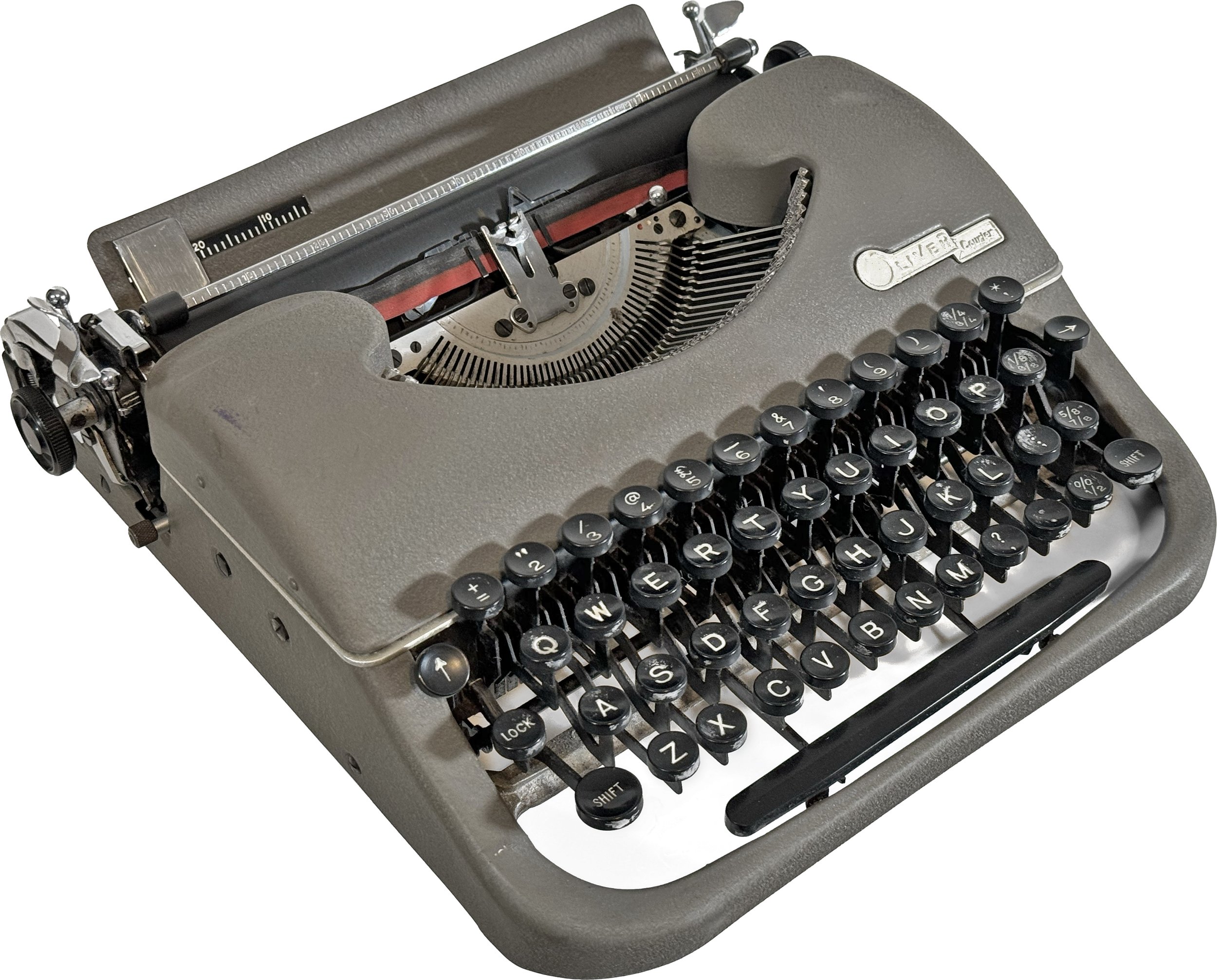
earliest logo badge
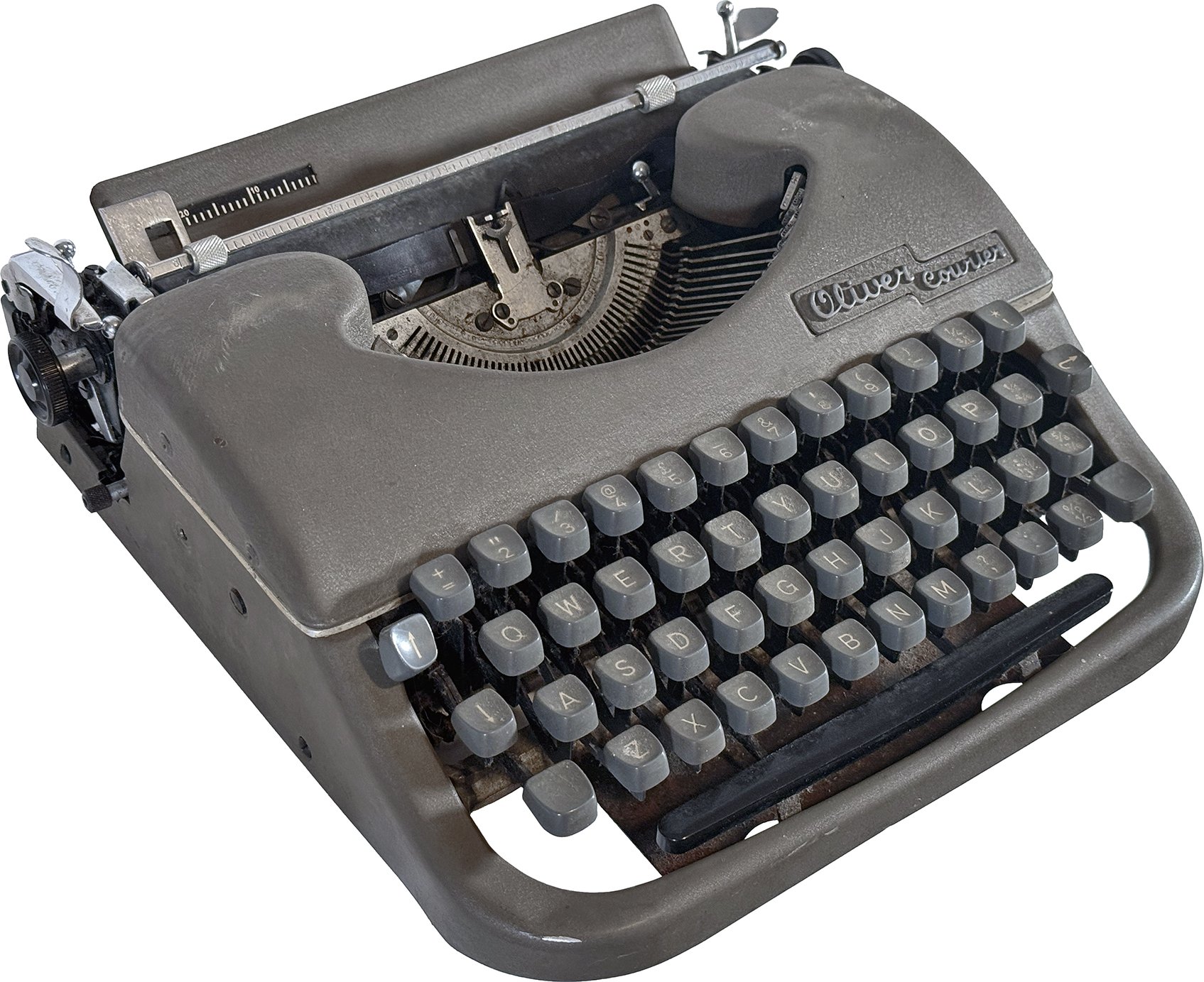
mid-production logo badge
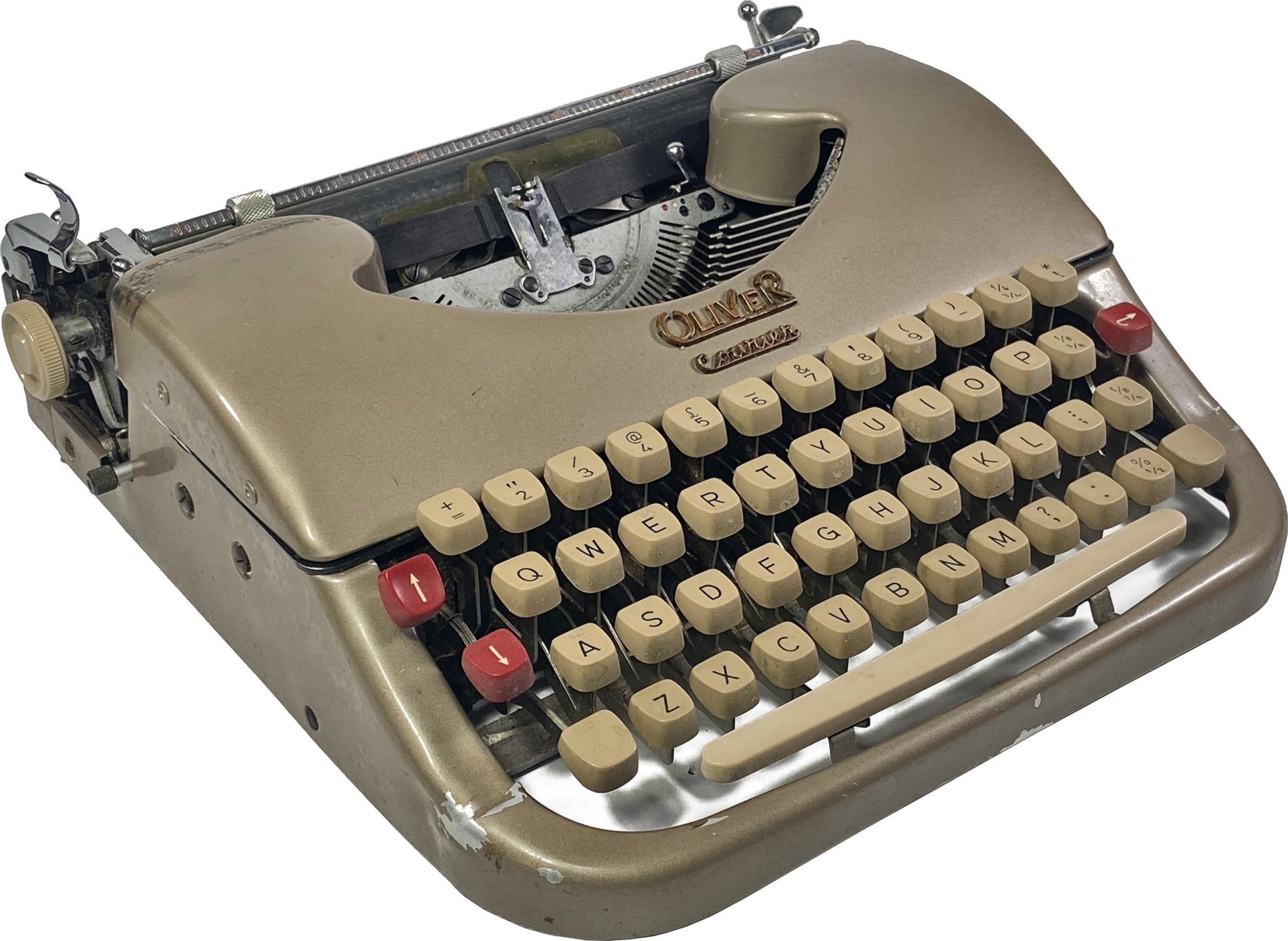
latest logo badge
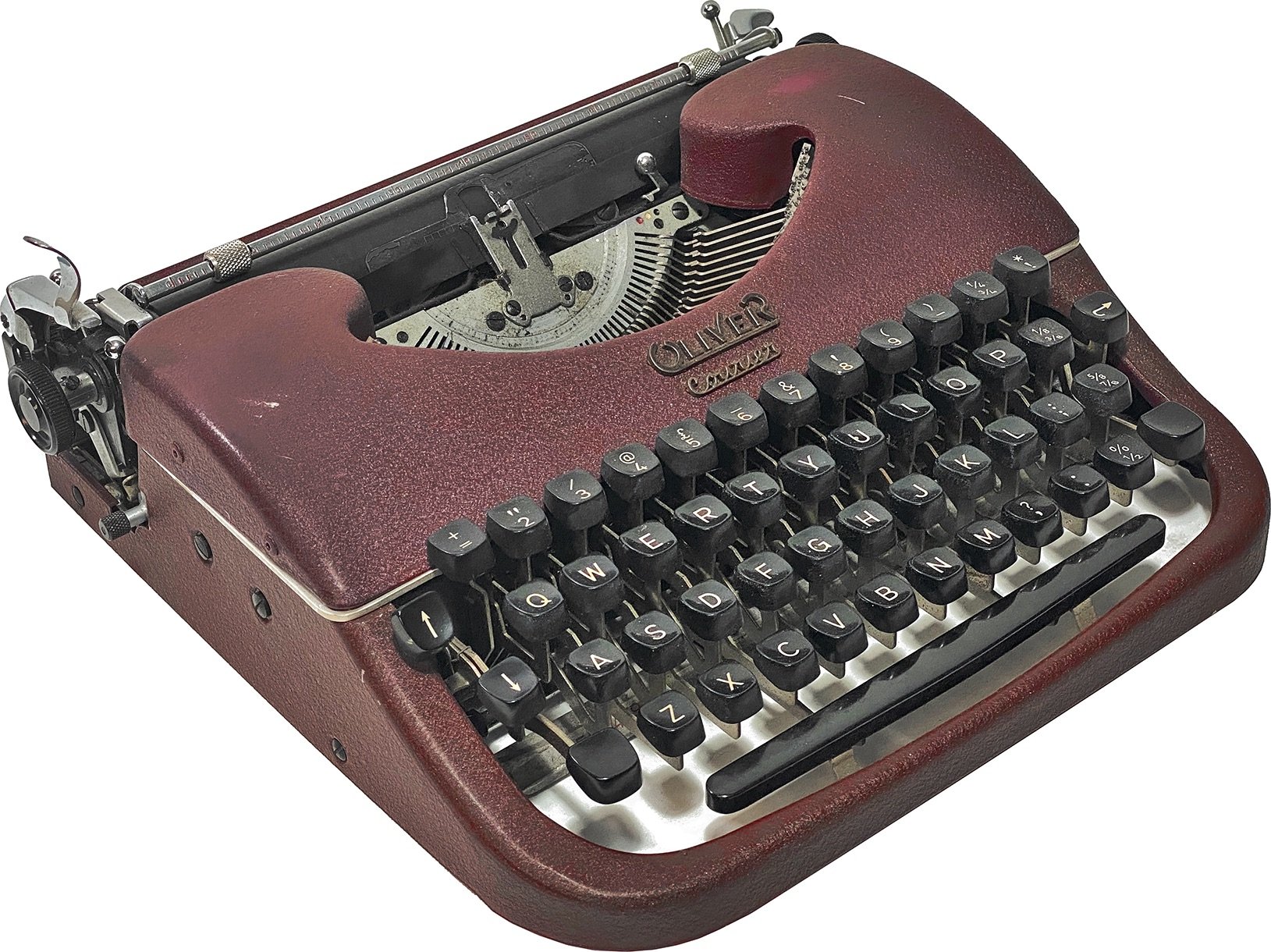
latest logo badge
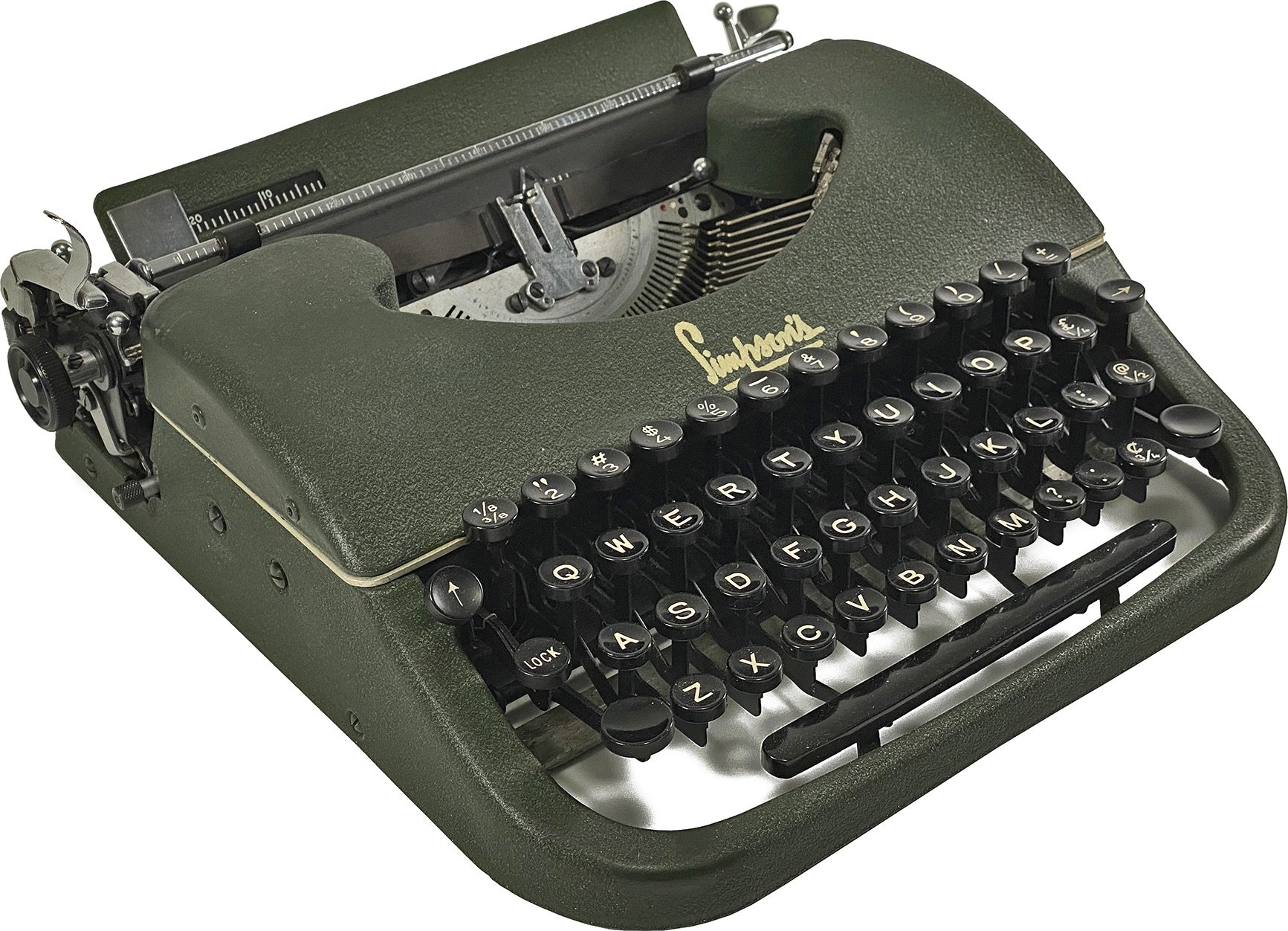
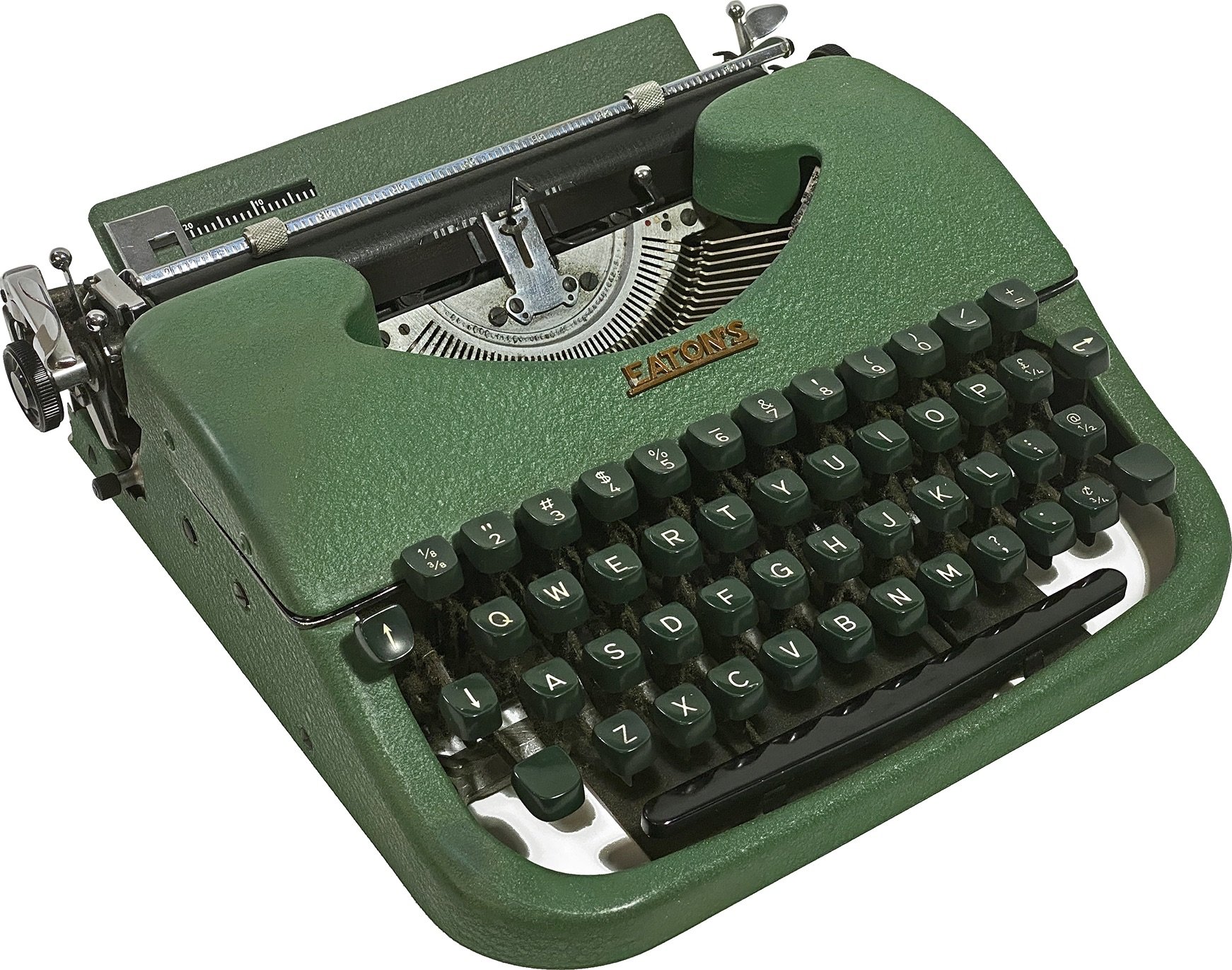
The successor to the Oliver Portable (Patria), branded as the Oliver Courier from 1954 to 1959, was manufactured by August Birchmeier’s Söhne in Canton of Aargau, Switzerland. They originally produced this machine as the Swissa Piccola. In France, it was sold as the Byron, Japy P68, Japy Personelle, Patria, Typo, and Select. The French watch company Japy Freres & Cie manufactured this machine through a licensing agreement. Guillermo Trúniger, S.A. distributed this machine in Spain under the names Amaya, Florida, Königer, Patria, and Pulasatta, and exported it in small quantities. Voss sold this body style as the Privat in Western Germany.
Early production Oliver Courier machines, produced in black or gray with round, black keys, feature a recessed badge toward the right of the cover. The next iteration of Oliver Courier adorns an updated badge featuring an embossed script, while the last iteration of the Oliver Courier features a badge centered above the keyboard.
The Oliver Courier was sold in Canada by the T. Eaton Company as Eaton’s through department store. Another Canadian variant was sold by the Robert Simpson Company through Simpson's department stores. The Oliver Courier was also sold in the United States as the Tower by Sears, Roebuck, and Company. The Tower Collegian (branded as Collegian) is another Canadian variant distributed through Simpsons-Sears, a partnership formed by the Robert Simpson Company and the Sears, Roebuck and Company. Additional variants include Conqueror, Monitor, and Steelmaster.
Oliver Consort
The Oliver Consort, manufactured by Voss Schreibmaschinenfabrik GmbH in Wuppertal, West Germany, forms a family of rebranded Voss machines of two distinct body styles. Both body styles were marketed under the name Oliver Consort, but branded as MT 10, MDT 10, MT 13, or MDT 13, depending on tabulator and carriage combination.
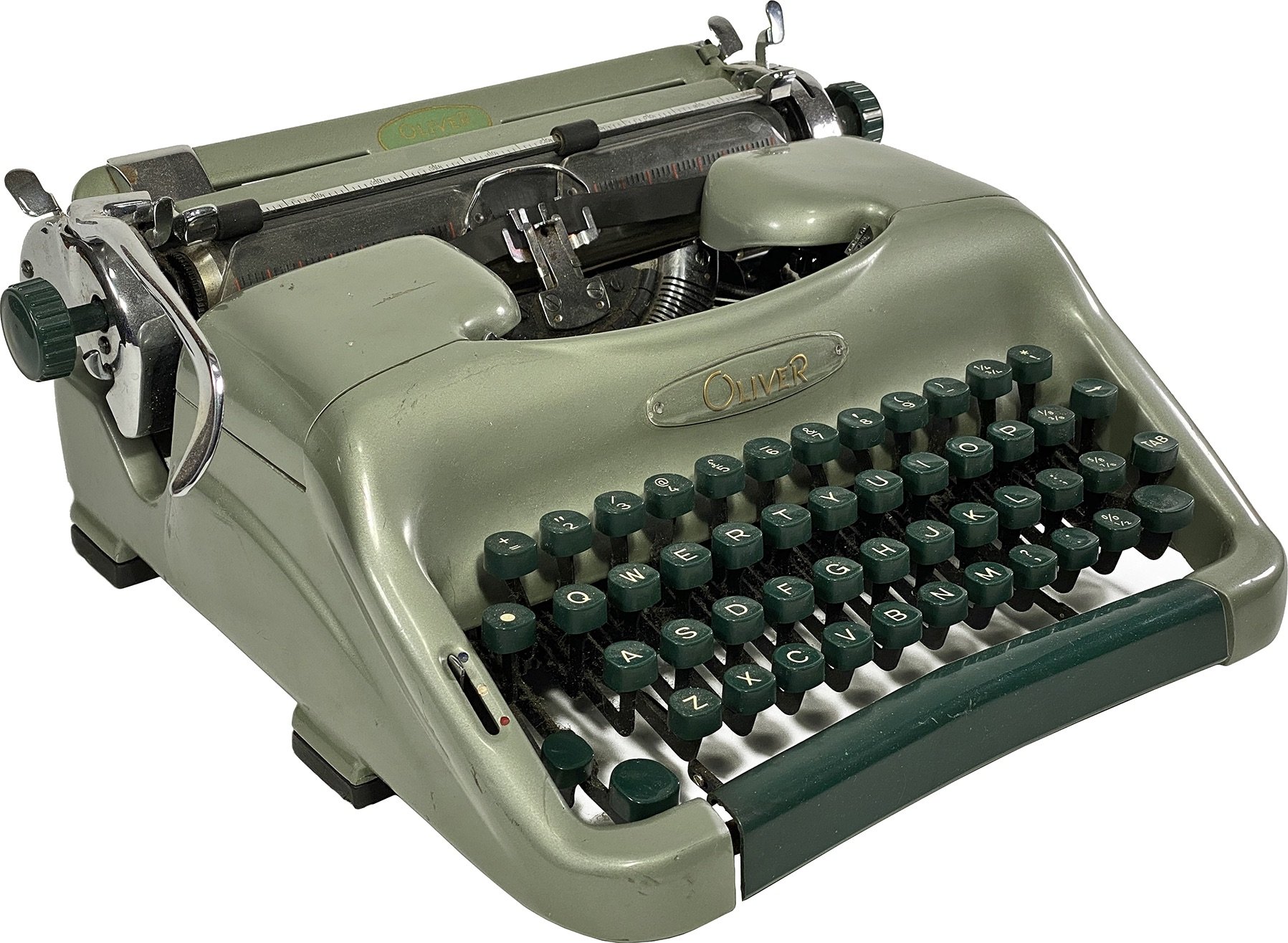
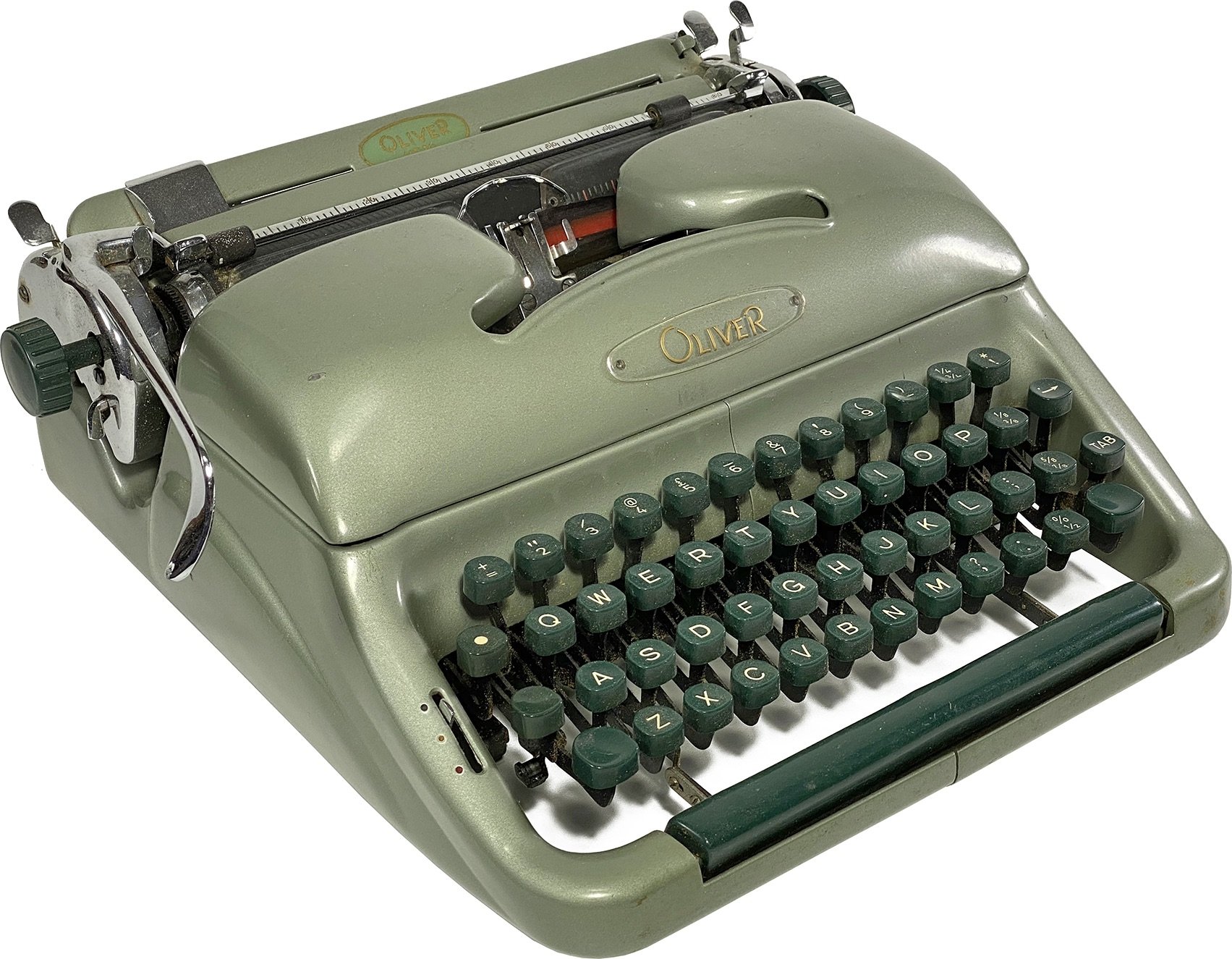
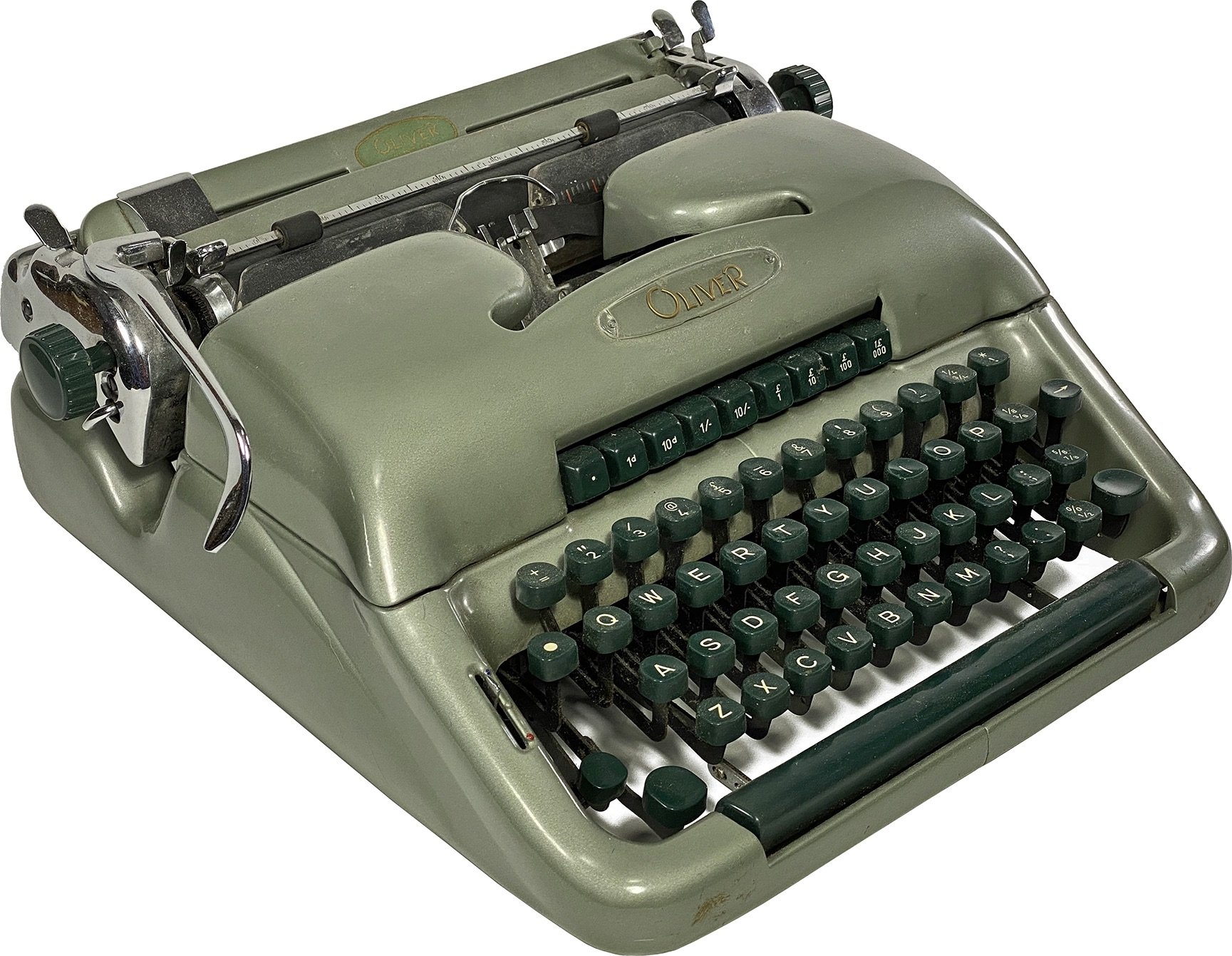
Production information has been derived utilizing the following references:
(1941) Liste der Herstellungsdaten Gangbarer Schreibmaschinen, Wochenschrift für Papier, Otto Hoffmann Verlag
(1953) Liste der Herstellungsdaten deutscher und auslandischer Schreibmaschinen, Hans Burghagen Verlag
Schramm, H. F. W. (1962) Liste der Herstellungsdaten Deutscher und Auslaendischer Schreibmaschinen mit Wichtigen Technischen Daten, 11 Auflage, Hans Burghagen Verlag
In addition to the above references, the author’s extensive research was used to correct false information and fill in gaps of missing information.

